ALOS-2 (Advanced Land Observing Satellite-2) / Daichi-2
EO
JAXA
Atmosphere
Ocean
Discover the ALOS-2 (Daichi) satellite mission and its advanced SAR capabilities for Earth observation and disaster monitoring.
Quick facts
Overview
| Mission type | EO |
| Agency | JAXA |
| Mission status | Operational (extended) |
| Launch date | 24 May 2014 |
| Measurement domain | Atmosphere, Ocean, Land, Gravity and Magnetic Fields, Snow & Ice |
| Measurement category | Multi-purpose imagery (ocean), Multi-purpose imagery (land), Surface temperature (land), Vegetation, Albedo and reflectance, Gravity, Magnetic and Geodynamic measurements, Landscape topography, Sea ice cover, edge and thickness, Soil moisture, Snow cover, edge and depth, Ocean surface winds, Atmospheric Winds, Ice sheet topography |
| Measurement detailed | Ocean imagery and water leaving spectral radiance, Land surface imagery, Vegetation type, Fire fractional cover, Earth surface albedo, Land surface temperature, Land surface topography, Wind vector over sea surface (horizontal), Sea-ice cover, Snow cover, Soil moisture at the surface, Iceberg fractional cover, Sea-ice type, Glacier motion, Sea-ice sheet topography, Oil spill cover, Crustal Motion, Above Ground Biomass (AGB), Active Fire Detection, Snow melting status (wet/dry) |
| Instruments | CIRC, PALSAR-2, SPAISE2 (AIS) |
| Instrument type | Other, Data collection, Imaging microwave radars |
| CEOS EO Handbook | See ALOS-2 (Advanced Land Observing Satellite-2) / Daichi-2 summary |
Related Resources
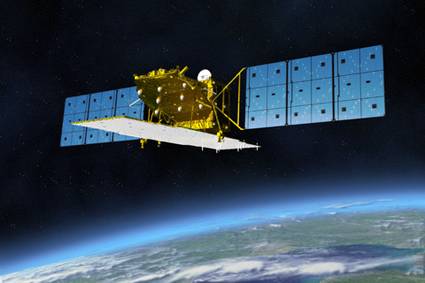
Summary
Mission Capabilities
ALOS-2 features an imaging microwave radar, PALSAR-2 (Phased Array type L-band Synthetic Aperture Radar-2); and a multi-purpose imaging vis/IR (visual/infrared) radiometer, CIRC (Compact InfraRed Camera). PALSAR-2 monitors Japanese natural disasters, land and agriculture, and also explores natural resources in the ground and seabeds of Japan. The instrument also monitors forests to contribute to global warming issues on an international scale. CIRC measures land surface temperature, and therefore also acts as a detector of active fires.
PALSAR-2 has a significant advantage over its predecessor PALSAR (which flew onboard ALOS) in that it has a wider range of observation modes to better suit the variety of observations tasked to the satellite. Whilst PALSAR had a minimum spatial resolution of 10 m in stripmap mode, PALSAR-2 has a minimum resolution of 3 m in the same mode. Additionally, PALSAR-2 has spotlight mode which has a resolution of 1 m x 3 m.
Performance Specifications
As indicated by its name, PALSAR-2 observes in the L-band, specifically 1257.5 MHz which is adjustable by ± 21 MHz. ScanSAR mode provides a spatial resolution of 60 m and 100 m for a swath of 490 km and 350 km respectively. Stripmap mode provides a resolution of 10 m, 6 m, and 3 m for a swath of 70 km, 70 km, and 50 km respectively. Spotlight mode provides a resolution of 1 m x 3 m for a swath of 25 km x 25 km.
ALOS-2 maintains a sun-synchronous orbit with an inclination of 97.9° at an altitude of 628 km and a period of 97 minutes. ALOS-2 has also decreased the revisit time of its predecessor by 70% from 46 days to 14 days.
Space and Hardware Components
The payload downlink is provided in Ka-band at 278 Mbit/s via the DRTS (Data Relay Technology Satellite) of JAXA, and is provided to various ground stations in X-band at 800, 400, or 200 Mbit/s. TT&C (Telemetry, Tracking, and Command) will be provided in S-band.
ALOS-2 was launched upon a Mitsubishi vehicle - an H-IIA F24 bus. The satellite was accompanied on launch by four secondary payloads, all microsatellites from different Japanese universities.
ALOS-2 (Advanced Land Observing Satellite-2; SAR mission) / Daichi-2
ALOS-2 is the follow-on JAXA L-SAR satellite mission of ALOS (Daichi) approved by the Japanese government in late 2008. The overall objective is to provide data continuity to be used for cartography, regional observation, disaster monitoring, and environmental monitoring.
The post-ALOS program of JAXA has the goal to continue the ALOS (nicknamed Daichi) data utilisation - consisting of ALOS-2 (SAR satellite) and ALOS-3 (optical satellite) in accordance with Japan’s new space program.
In 2010, ALOS has been operating for more than four years since January 2006 to accomplish four mission goals, including:
- cartography,
- regional observations,
- disaster monitoring,
- resource surveys.
ALOS-2 will continue the L-band SAR observations of the ALOS PALSAR (Phased Array L-band Synthetic Aperture Radar) and will expand data utilisation by enhancing its performance. Table 2 shows the major observation advantages of the planned ALOS-2 mission when compared with the ALOS PALSAR. 1) 2) 3) 4) 5) 6) 7) 8) 9)
Note: The ALOS (Daichi) spacecraft was retired on May 12, 2011. The JAXA recovery team had been trying to communicate with ALOS for about three weeks after it developed a power generation anomaly.
Disaster monitoring | - To contribute to the nation’s disaster prevention activities through fast access to damaged areas during serious disasters in Japan, Asia and so on, as well as continuous monitoring of subsequent disasters and/or recovery/reconstruction status over the areas. |
Land monitoring | - To provide national land information in a timely manner and promote its utilisation based upon archived data developed by a wide range of observation data as well as its continuous acquisitions. |
Agricultural monitoring | - To contribute to the sophistication and sustainability of agriculture by providing related organisations with the observation data necessary for the evaluation of irrigated rice. |
Natural resource Exploration (facilitate natural resources & energy supply) | - To contribute to enhancing the method of natural resource exploration by providing related organisations with the observation data necessary for detecting oil and mineral resources in the ground and seabed. |
Global forest monitoring | - To contribute to solving global warming issues by providing related organisations with data derived from global monitoring of tropical rain forests to identify carbon sinks. |
Observation parameter | ALOS (launch 2006) | ALOS-2 (launch 2014) |
| - Revisit time: 46 days | - Revisit time: 14 days |
-Daytime observation is limited by sharing with optical observation | - No conflict | |
- Incidence angle : 8-60º | - Incidence angle: 8-70º | |
Spatial resolution | - Strip map: 10 m | - Strip map: 3 m /6 m /10 m |
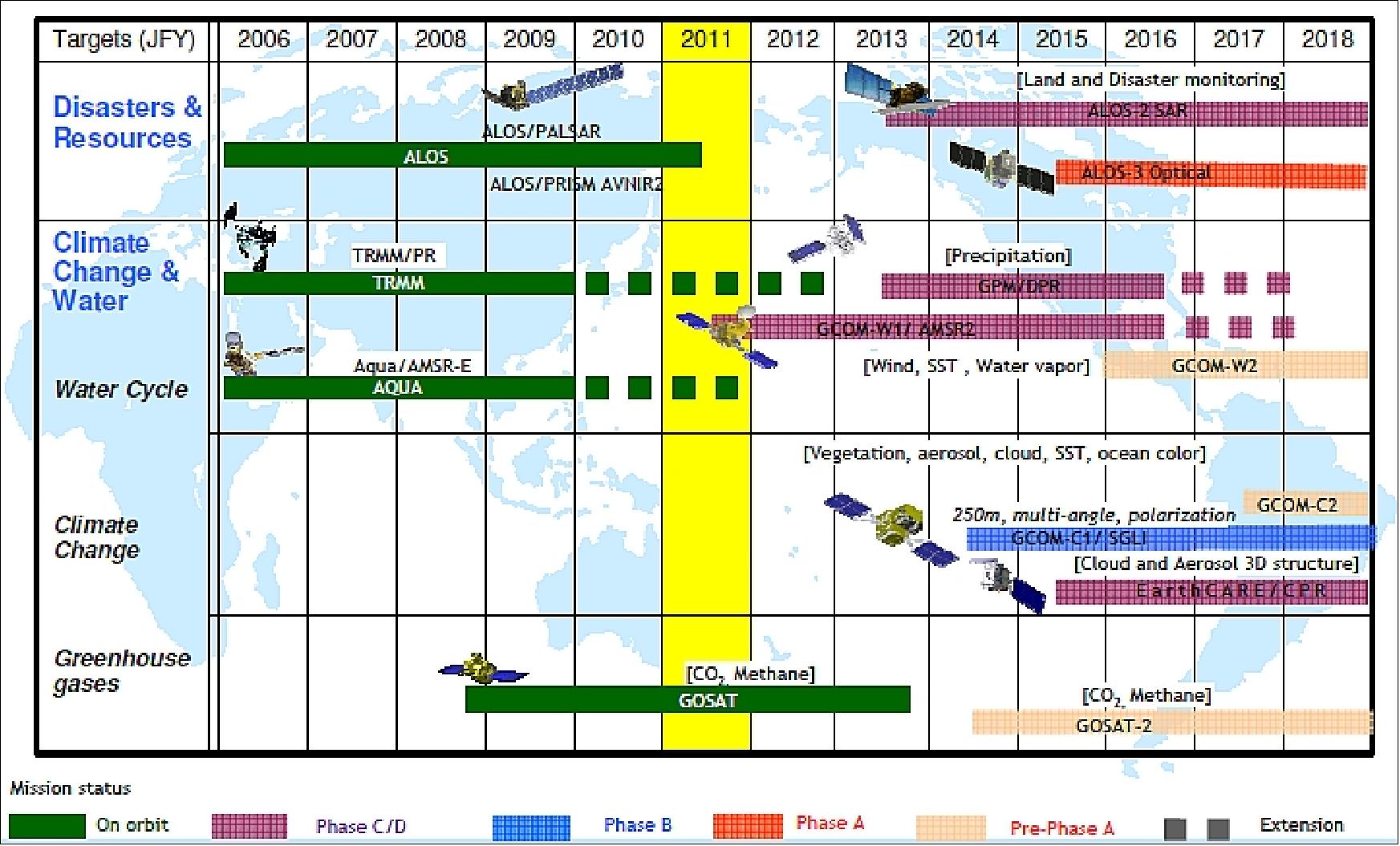
Japan is an earthquake-prone and volcanic country where two-thirds of the land area is covered by forestry. The L-band Synthetic Aperture Radar (SAR), which was aboard the past two satellites, namely FUYO-1 (JERS-1) between 1992 and 1998 and DAICHI (ALOS) between 2006 and 2011, is a sensor using a radio wave (microwave), and it enables observations of land surface conditions even during the night and under bad weather. The special feature of the L-band radio wave (whose wavelength is about 24 cm) is the ability to gather information from the land surface by penetrating vegetation such as forests (to a certain extent), thus it can acquire changes on the land more precisely compared to other band’s SAR when some diastrophism takes place due to an earthquake or a volcanic activity. 11)
DAICHI-2 (ALOS-2) is equipped with a global-leading L-band SAR (PALSAR-2) to conduct a health check mainly of the earth’s land areas in detail. The observation performance has been improved to promptly conduct accurate observations of the surface while maintaining a wide observation band. Hence, it will acquire more useful data that is directly related to our safe life as it can observe not only diastrophism but also floods or landslides caused by a natural disaster, such as a storm or a gale, accurately in a timely manner. Its predecessor, DAICHI, responded to many requests for disaster monitoring from overseas, and, as a result, Japan was able to receive a lot of image data from foreign satellites in return in addition to those taken by the DAICHI when we were hit by the Great East Japan Earthquake. This data was very helpful to understand the situation of the unprecedented huge natural disaster in Japan. We would like to maintain this international cooperation framework with the DAICHI-2.
Besides natural disaster observations, the DAICHI-2 will regularly observe tropical rain forestry, which is difficult to observe optically due to thick clouds covering it frequently, as well as snow and ice conditions in the polar areas. By combining observation data acquired over more than 11 years, we will keep observing the time elapse to capture changes of forestry, which is a greenhouse gas sink, as well as the transformation of snow and ice due to the greenhouse gas effect. By doing so, we will contribute to environmental issues on a global scale.
With the L-band SAR, which is one of Japan’s specialities that has been inherited for a long time, the DAICHI-2 is a “national project” that contributes to safety and security in cooperation with domestic and overseas pertinent agencies. As an engineer, I am proud of participating in such an important project while I feel a heavy responsibility throughout the development of the satellite. I will do my utmost to achieve this project’s mission goal by launching and operating it smoothly in order to meet the expectations of its users and, eventually, of the people who are the ultimate beneficiaries.
Spacecraft
The ALOS-2 system is developed by Mitsubishi Electric Corporation under contract with JAXA (Japan Aerospace and Exploration Agency).
A proper description of the spacecraft will be provided when available.
Precise positioning using GPS:
ALOS-2 is equipped with spaceborne dual-frequency GPS receivers using both L1 and L2 bands and demonstrated precise navigation on orbit. However, to achieve higher resolution observation and more accurate orbit manoeuvring for next Earth observation satellites, an advanced GPS receiver was necessary. The JAXA Guidance and Control Group has been conducting a series of studies for a next-generation spaceborne GPS receiver. In this development, an enhancement of navigation accuracy is a major theme, and the new receiver will be reinforced with the ability to receive multiple frequencies and multiple channels to meet with GPS modernisation. 12)
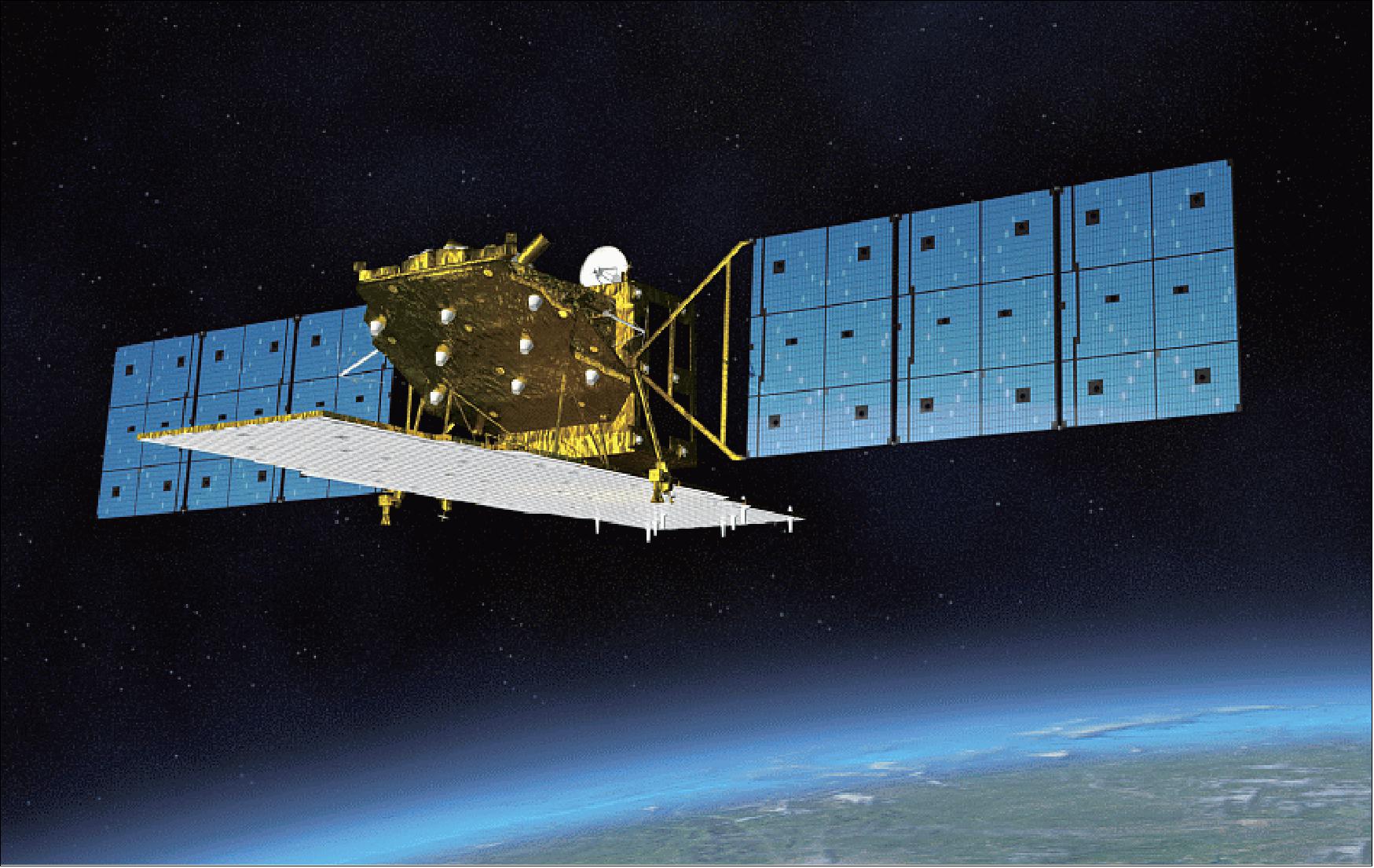
Recently, an algorithm for enhancing navigation accuracy, especially when using the L1 band only by reducing the error due to ionospheric delay has been developed based on the algorithm developed in this work, software installed in the GPS receiver for ALOS-2 is developed (Ref. 4).
Real-time GPS L1 navigation:
- In monitoring disasters, real-time navigation using an L1 signal is important
- Algorithm for enhancing navigation accuracy is developed (estimate of ionospheric delay and its change)
- Measurement accuracy < 10 m (95%, 3Drss).
Offline precise positioning:
- Dual (L1 and L2) off-line position determination < 1m
- ALOS-2 SAR frequency is overlapped with the L2 signal
- Enhanced low-noise amplifier for GPS receiver with endurance against SAR signal is being developed

Orbit | Sun-synchronous orbit: altitude = 628km, inclination = 97.9º |
Mission design life | 5 years ( with a goal of 7 years) |
Spacecraft mass | 2120 kg |
Spacecraft size (deployed) | 9.9 m (x) x 16.5 m (y) x 3.7 m (z) |
Spacecraft power generation | 5.2 kW (EOL) |
Downlink communications | X-band: 800 Mbit/s (16 QAM), 400/200 Mbit/s (QPSK) |
Launch | H-IIA launch vehicle from TNSC |
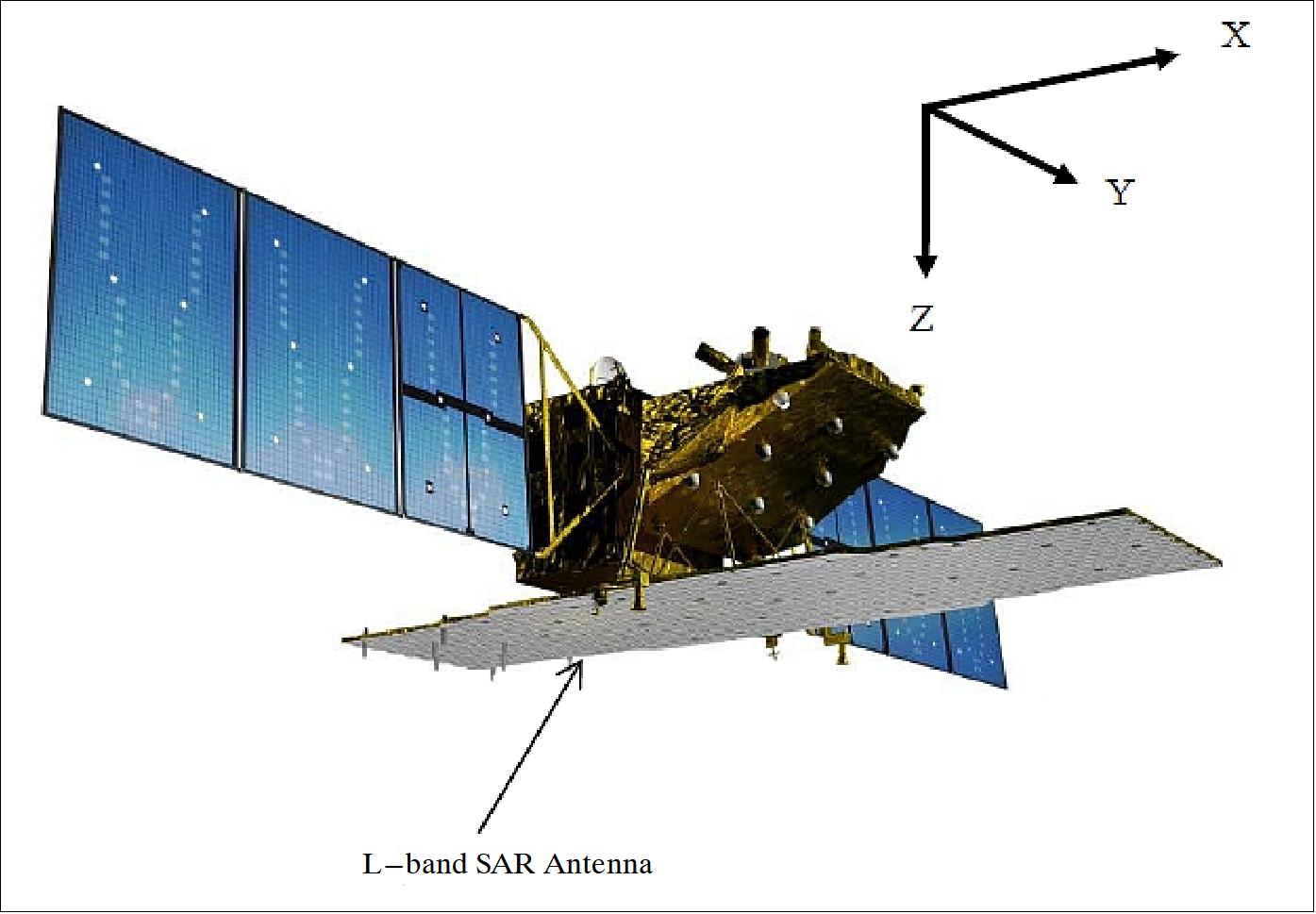
Agile spacecraft: ALOS-2 has a body pointing function of ±30º in the roll axis. For the purpose of minimising observation intervals, the requirement for attitude manoeuvring is up to 2 minutes from the Earth pointing attitude to right- or left-looking, and the manoeuvring from right- to left-looking (or from left- to right-looking) is up to 3 minutes, as shown in Figure 5.
To achieve a high agility of maximum attitude rate, 0.7º/s in roll axis, one Reaction Wheel (RW) is aligned with the roll axis, and the other four RWs are mutually skewed. This RW assembly was developed by the JAXA GCG (Guidance and Control Group), and establishes more than 0.9 Nm output torque and maximum momentum 40 Nms (at 3200 rpm). The numerical simulation results of attitude pointing are summarised in Table 4.
Case | No of RWs | Requirement | Result (seconds) |
Nominal to Right- or Left | 5 | Up to 2 minutes | 109 |
Right- to Left (or Left- to Right) | 5 | Up to 3 minutes | 159 |
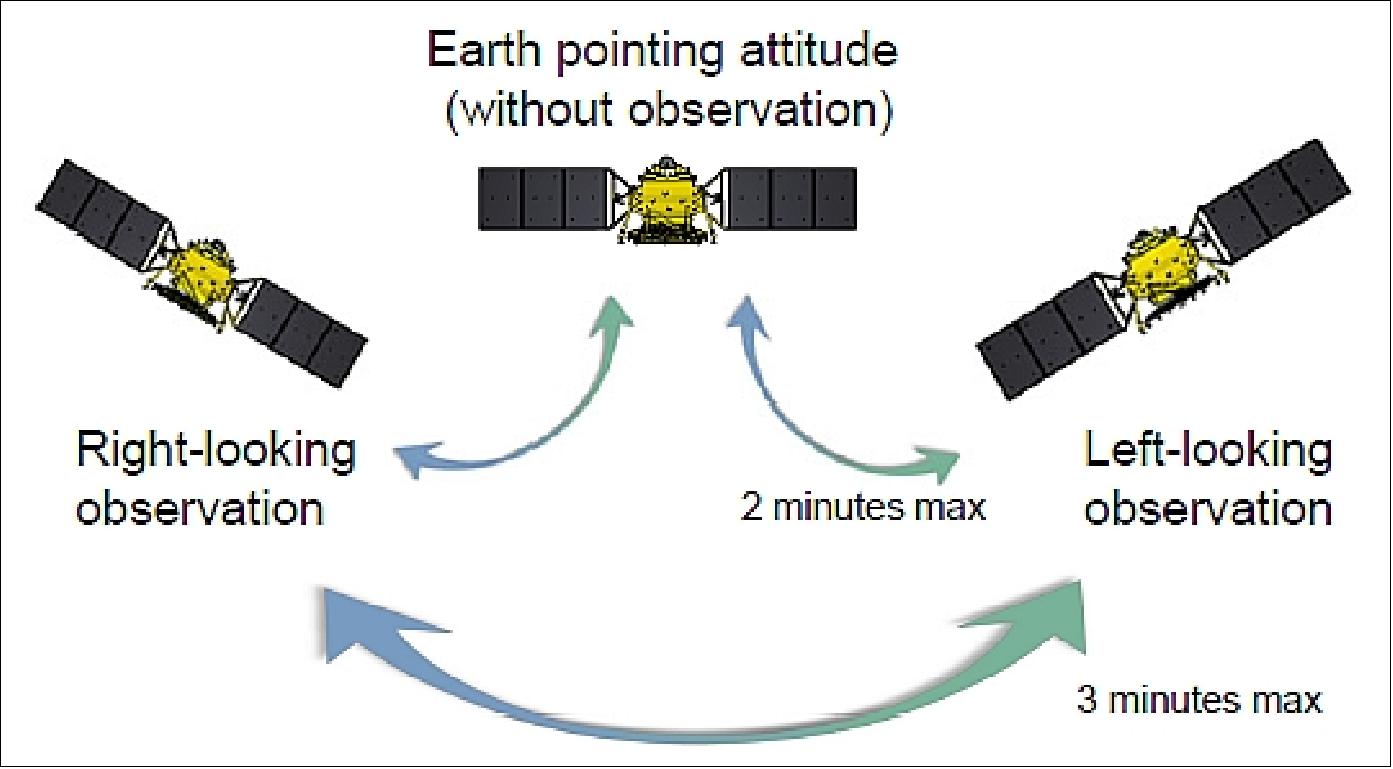
RF communications:
The requirement calls for a payload data transmission rate of 800 Mbit/s in the X-band. With a traditional modulation scheme of QPSK, the transmission speed peaks at about 400 Mbit/s since the frequency bandwidth allocation is limited to 375 MHz by the ITU (International Telecommunication Union) regulations.
To solve this problem, the project designed and developed XMOD (Multi-mode High-Speed Modulator), capable of achieving a (max) data rate of 800 Mbit/s. The XMOD device has the following features, not only to achieve the 800 Mbit/s data rate but also to target strong international competitiveness as well as high system reliability. 15) 16) 17)
1) Use of a 16QAM 16 (Quadrature Amplitude Modulation) scheme to enable the 800 Mbit/s data rate, regarded as the world’s highest RF data rate, implemented as a single X-band carrier.
2) Adoption of the QPSK (Quadrature Phase Shift Keying) technique to comply with existing ground stations and improve robustness.
3) Implementation of a “Multi-mode/Multi-rate” design capable of supporting various satellite projects.
4) Introduction of some cutting-edge techniques for space and a high-reliability design to improve the tolerance to space radiation effects.
5) Reduction of XMOD in size and mass by boosting double-sided mounting techniques and applying small lightweight parts.
• Baseband module:
The baseband module consists of the following devices:
- WizardLink family of multi-Gigabit Serialiser/Deserialisers (Ser/Des)
- SRAM-based FPGA (Virtex-4QV)
- High-speed Digital-to-Analog Converter (DAC5675A-SP)
- antifuse-FPGA
- TCXO (Temperature Compensated Crystal Oscillator).
• RF module:
The RF modules perform quadrature modulation on the I-channel and Q-channel signals generated by the baseband module, and then the modulated signals are amplified as desired.
• Load oscillator module:
The local oscillator module generates the X-band local carrier frequency for the quadrature modulator
• DC/DC:
The DC/DC converter, 30V-53V unregulated bus support, supplies regulated DC power to all the XMOD modules

Modulation scheme | 16QAM without differential coding |
Data rate | 800, 400, or 200 Mbit/s |
Frequency bandwidth | < 275 MHz: @ 800, or 400 Mbit/s (specification), 238.3 MHz (obtained result) |
Interface | Data: WizardLink |
Operating temperature | -20 to + 50ºC |
Operating voltage | 30 to 53 VDC |
RF output power | +5 dBm ± 1 dB |
Power consumption | ≤ 25.5 W (specification), 19.02 W (obtained result) |
Mass | ≤ 3.36 kg, internal redundancy (specification), 2.64 kg (obtained result) |
Size | 277 mm x 106 mm x 186 mm (max), internal redundancy |
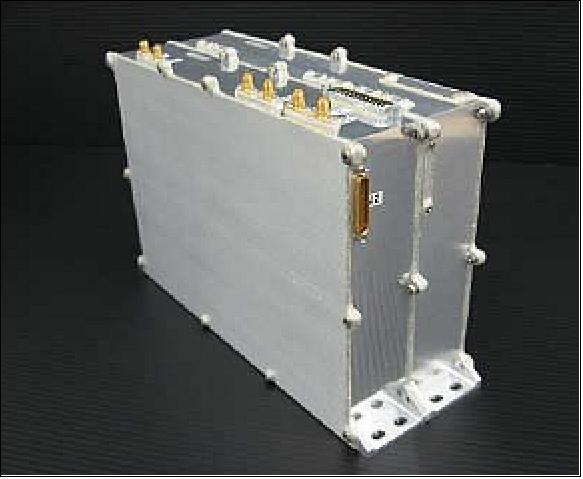
ALOS-2 has an improved data handling function which consists of a high-rate and huge-amount storage system, MDHS (Mission Data Handling System), and two types of high-rate transmission systems, DT (Direct Transmission) and DRC (Dual -Receive Channel), as shown in Figure 8. MDHS has a data storage volume of 130 GB. MDHS collects mission data from PALSAR-2 and health monitoring data from other components and carries out digital processing such as adding of forward error correction codes, file pointer management, and so on. It can be operated in various modes such as simultaneous record and replay, replay follow write, this scheme will contribute to flexible data handling operations.
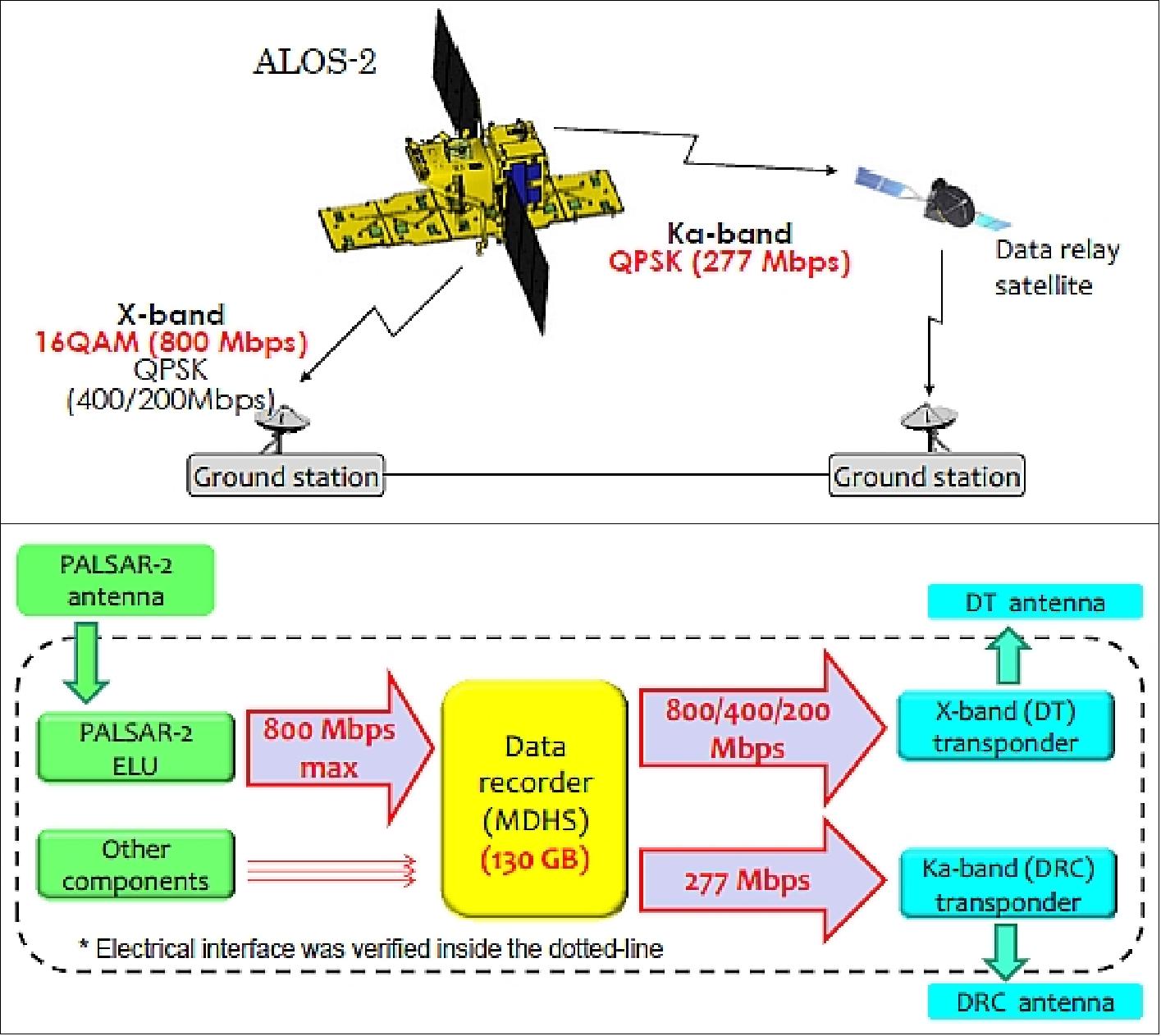
The PALSAR-2 Electric Unit (ELU) consists of System Controller (SC), Data Processor (DP), as shown in Figure 61. SC receives commands from the satellite and sends telemetry to the satellite. DP compresses mission data and sends it to MDHS.
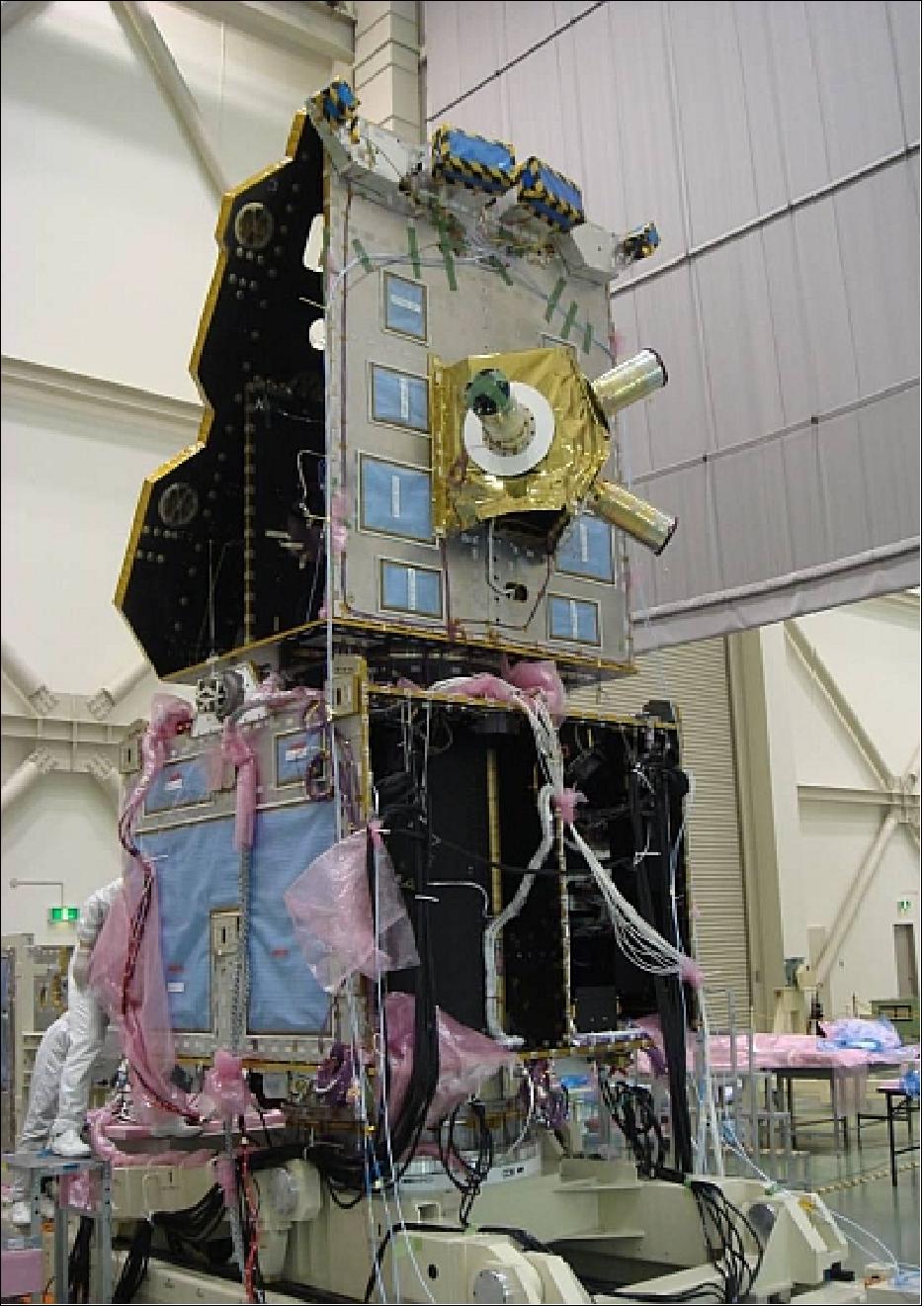
Launch: ALOS-2 (Daichi-2) was launched on May 24, 2014 (03:05 UTC) on an H-IIA F24 vehicle (No 24) from the Yoshinobu Launch Complex at TNSC (Tanegashima Space Center), Japan. The launch provider was MHI (Mitsubishi Heavy Industries, Ltd.). At about 15 minutes and 47 seconds after liftoff, the separation of the DAICHI-2 was confirmed. 19) 20) 21) 22)
The secondary missions on the ALOS-2 mission by JAXA were: 23)
• Rising-2, a cooperative microsatellite (43 kg) project of Tohoku University (Sendai) and Hokkaido University, Sapporo, Japan.
• UNIFORM-1 (University International Formation Mission-1), of Wakahaya University, Wakayama, Japan.
• SOCRATES (Space Optical Communications Research Advanced Technology Satellite), a microsatellite (~ 50 kg) mission of NICT (National Institute of Information and Communications Technology), Koganei, Japan.
• SPROUT (Space Research on Unique Technology), a nanosatellite of ~7 kg of Nihon University, Tokyo, Japan.
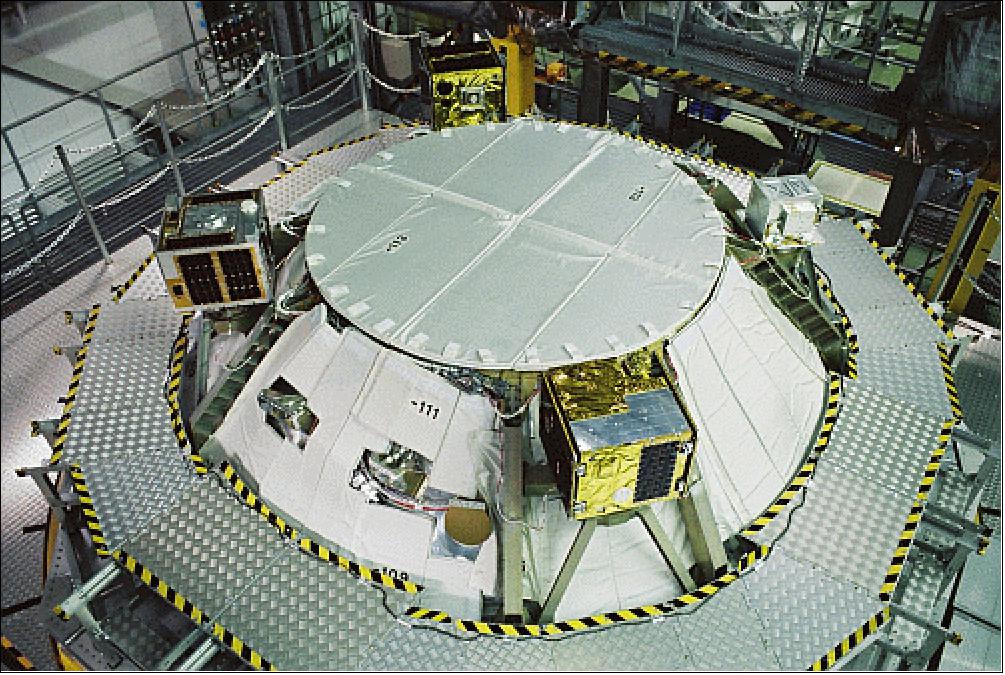
Orbit
Sun-synchronous near-circular sub-recurrent orbit, altitude = 628 km, inclination = 97.9º, period = 97.4 minutes, revisit time = 14 days, number of orbits/day = 15 3/14, LSDN (Local Sun time on Descending Node) = 12:00 hours ± 15 min.
To achieve higher coherence of interferometry, autonomous accurate orbit manoeuvring (within 500 m orbital tube) and enhanced GPS receiver with endurance against L-band SAR signal was developed. The orbit control requirement to satisfy the geometric restriction which arises from the repeat-pass SAR interferometry is illustrated in Figure 11. The reference Earth-fixed flight path is defined for a repeat cycle of its orbit. ALOS-2 satellite must fly within a tube-shaped corridor, the centre of which is the reference flight path. The radius of the tube-shaped corridor, 500 m, is the tolerance of an orbit error. The orbit prediction, based on a detailed perturbation model, is introduced to generate the reference flight path. Using it as a reference for orbit maintenance, unnecessary orbital manoeuvres can be avoided.
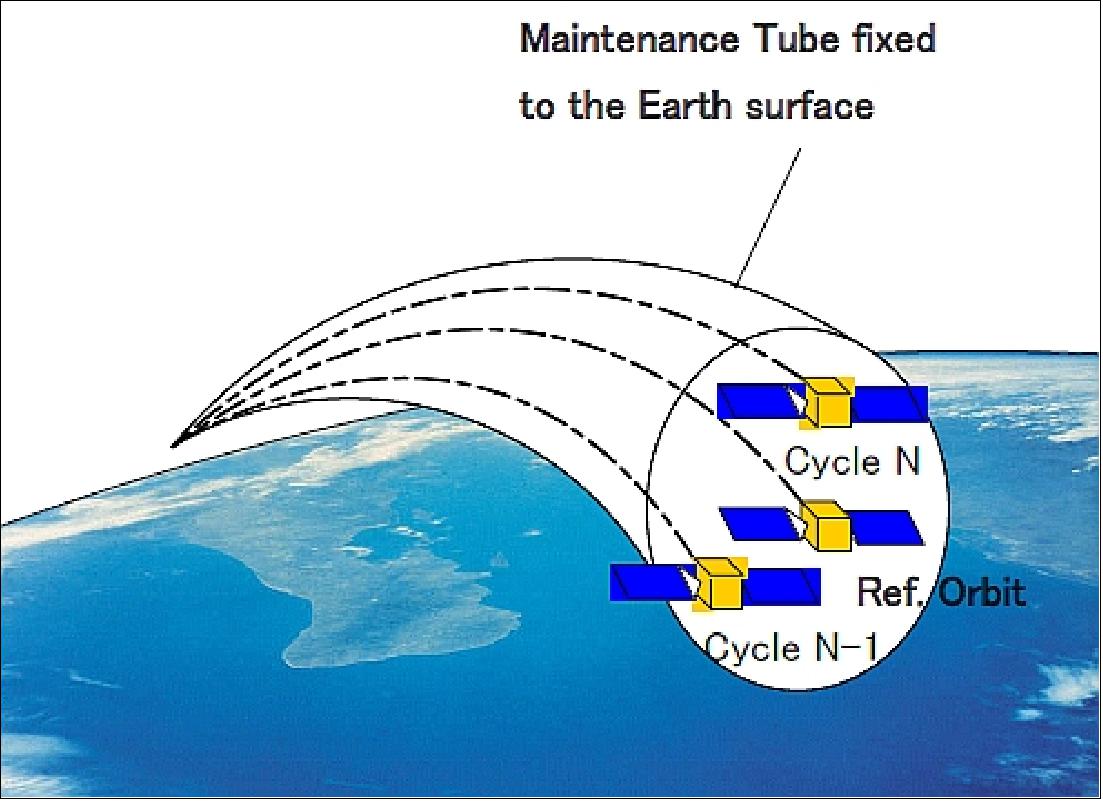
As a result of numerical simulations, throughout the mission life, orbit maintenance within the 500 m tube was verified to be accomplished 99.7% of the time, which exceeds the requirement of 95%. The average period between orbit manoeuvres was 4.9 days for in-plane manoeuvres and 176 days for out-of-plane manoeuvres. The minimum interval of in-plane manoeuvres during the active solar period was estimated at 1.5 days. This means that autonomous orbit maintenance is essential for this mission in terms of operational aspects.
The onboard software of ALOS-2 can handle operations of orbit determination, manoeuvre prediction and planning, and manoeuvre executions for both drag-makeup manoeuvres and inclination manoeuvres. This feature of autonomy is expected to be a great help for efficient ground operations of ALOS-2. 24) 25)
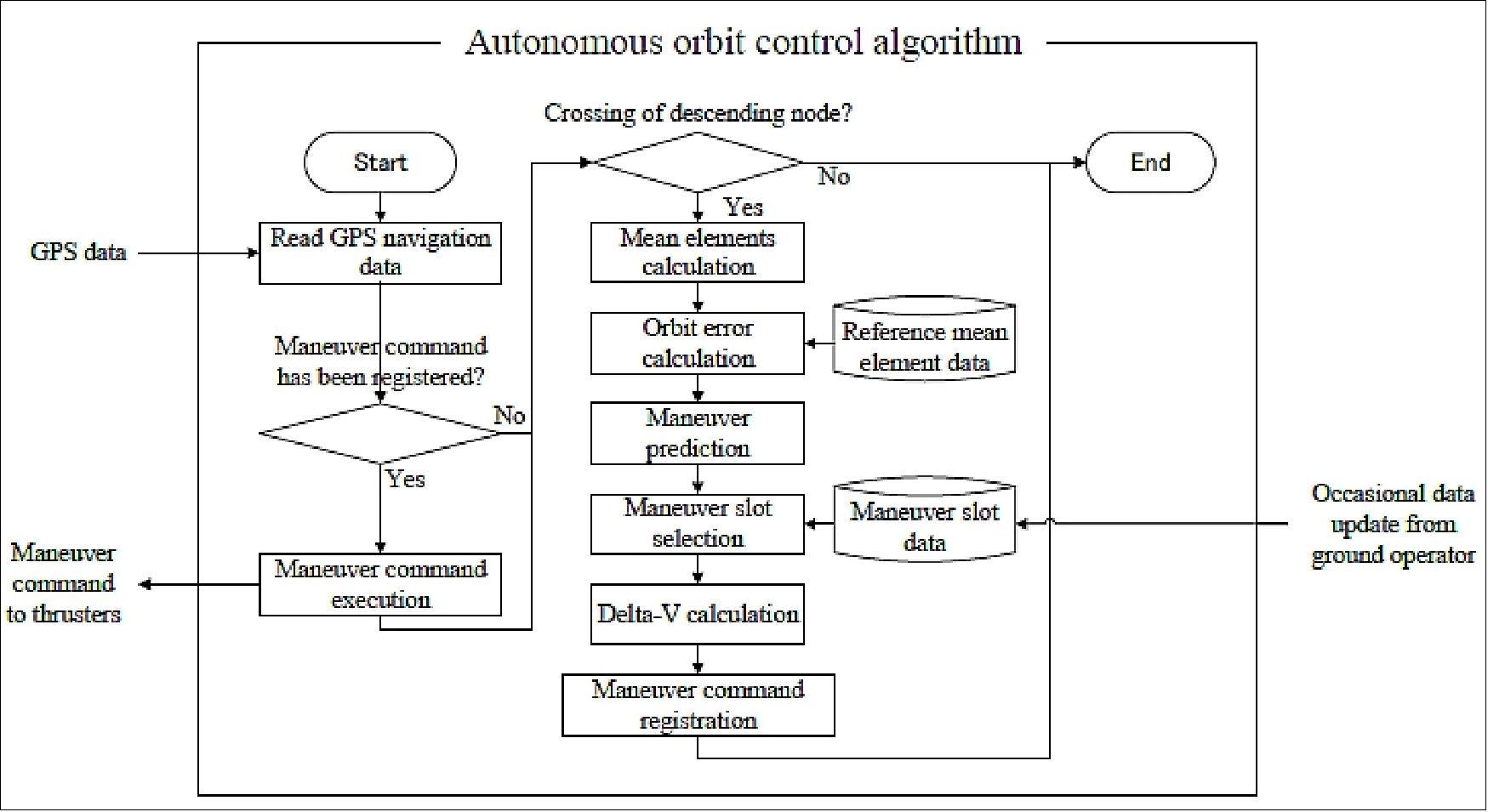
Mission Status
• July 14. 2020: According to one estimate, there are more than 3.6 million lakes in the Arctic. They are remote and hard to reach and sample in the field, especially when they are covered with ice during the Arctic’s long winters. 26) Yet they are critically important to understanding climate change. They release methane (CH4) that has a heat-trapping power about 30 times stronger than carbon dioxide. Finding the sources of methane around the world and measuring how much they are emitting has become an important scientific pursuit. Most attempts to measure methane emissions from lakes have focused on summer conditions when lakes are ice-free, but the processes that produce the gas continue through the winter when many lakes are frozen. To get around this problem, the group developed a new satellite-based technique to measure methane from lakes. The new technique makes use of L-Band synthetic aperture radar (SAR), a technology that involves bouncing microwaves off Earth’s surfaces and looking for changes in the reflection patterns observed by the satellite. The technique works even in cloudy conditions if a layer of snow covers lake ice, or in darkness
The Synthetic Aperture Radar of ALOS-2 offers scientists a new way to measure how much of the potent greenhouse gas is bubbling up from frozen Arctic lakes. A key reason the small lakes around Fairbanks had such high fluxes is that they are located within yedoma—a type of Pleistocene-aged permafrost rich with organic material that releases significant amounts of methane when thawed. To validate their satellite observations, the group also made ground-based measurements at dozens of lakes near Barrow Peninsula, Atqasuk, Toolik, Northern Seward Peninsula, and Fairbanks, where they placed submerged “bubble traps” to measure methane emissions.
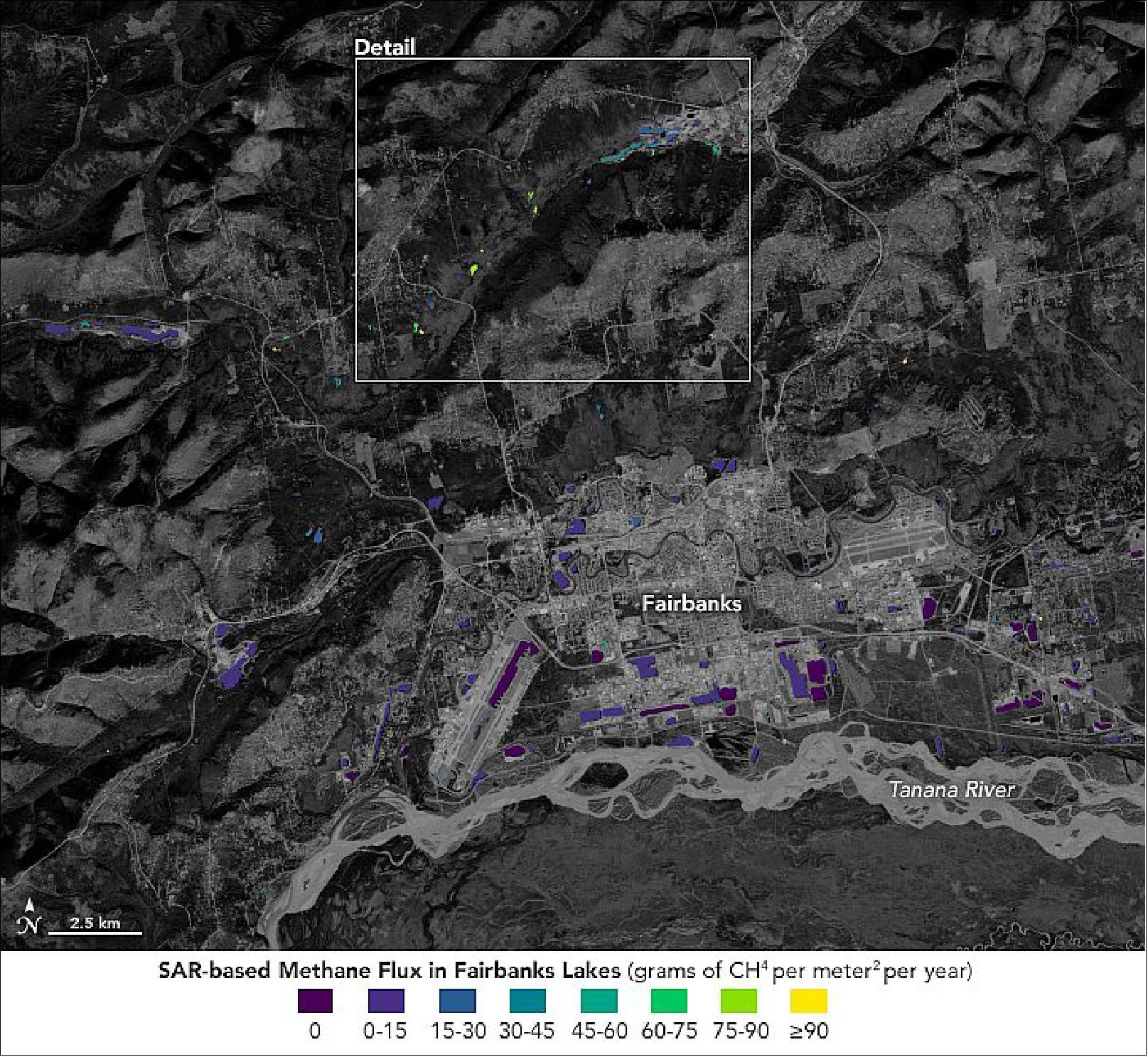
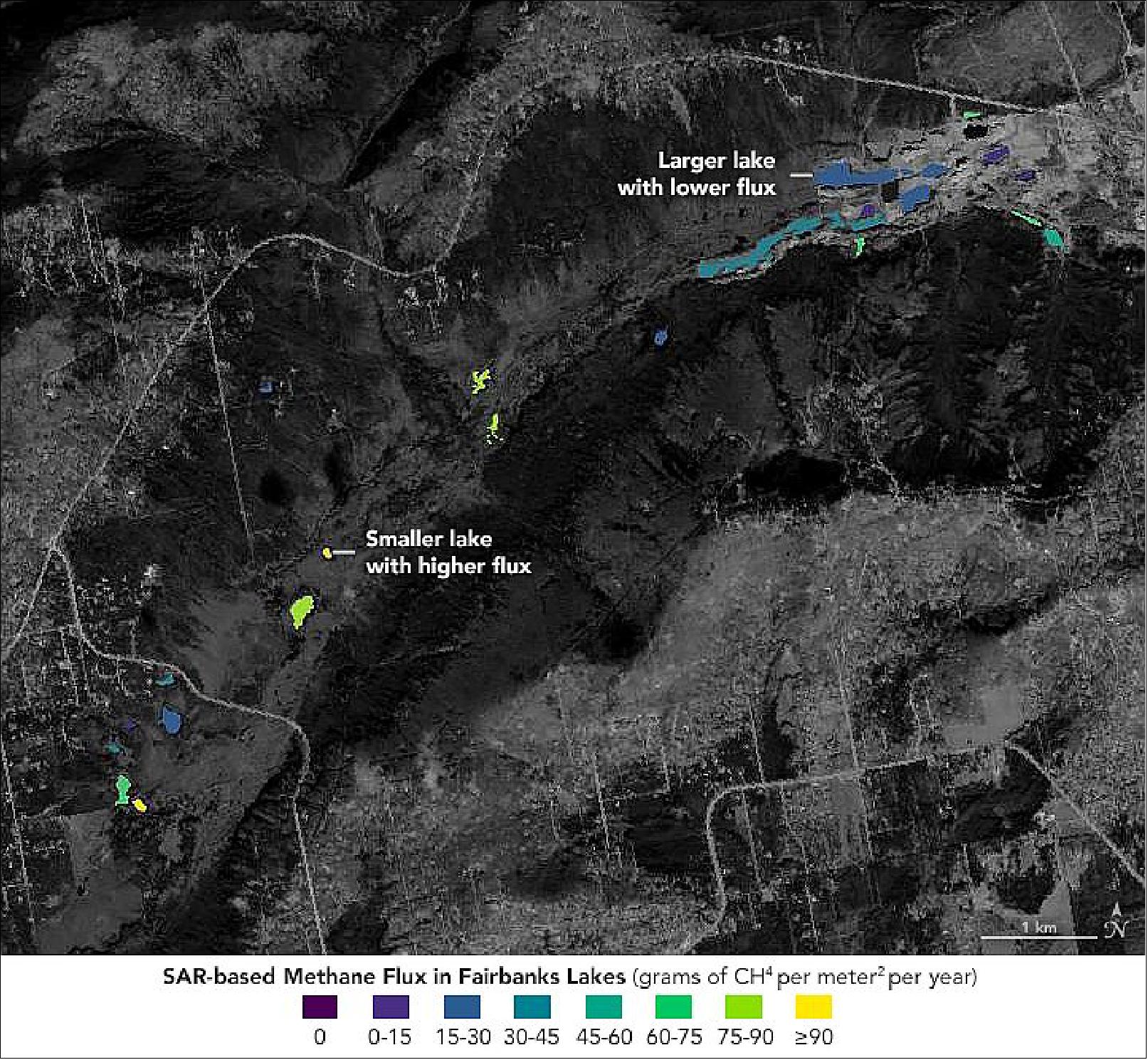
• January 23, 2020: FAO improved the scope of its geospatial monitoring toolkit due to the collaboration with the Japan Aerospace Exploration Agency (JAXA) that will expand the capacity of FAO's accessible platforms for forestry and land-use assessments. 28)A three-year agreement was signed that day that would enhance the access of FAO member states and other users to JAXA data sets, including ALOS-2 data. JAXA has observed forests using L-band radar technology since 1992. Observation data of global forests that JAXA has been accumulating for over 25 years will be provided to SEPAL which is FAO's toolkit for monitoring forest and land use. Additionally, this cooperation supports JAXA to improve the accuracy of its satellite data.
• November 6, 2019: On September 28, 2018, a powerful, shallow earthquake ruptured the land surface and seafloor near Indonesia’s Sulawesi island and sent a devastating tsunami into the city of Palu. While the nearby strike-slip fault was a known tsunami hazard, the magnitude 7.5 earthquake surprised scientists because it triggered large and deadly landslides in an area with a gently sloping landscape. 29) One year later, a team of scientists from six countries has unravelled the mystery of the landslides and discovered a new earthquake hazard in the process. Examining various types of radar and visible satellite data, the team found that mud and soil flowed most readily near irrigated rice paddies. The earthquake in Indonesia made the land flow like mud in a place where science previously said it shouldn't. This image of PALSAR-2 on ALOS-2 is a damage proxy map created by NASA/JPL (Figure 46). Satellite radar data collected before and after the quake was examined, mapping changes in the land surface and built structures. Yun’s data has been overlaid on a digital elevation map to show the slope of the landscape.
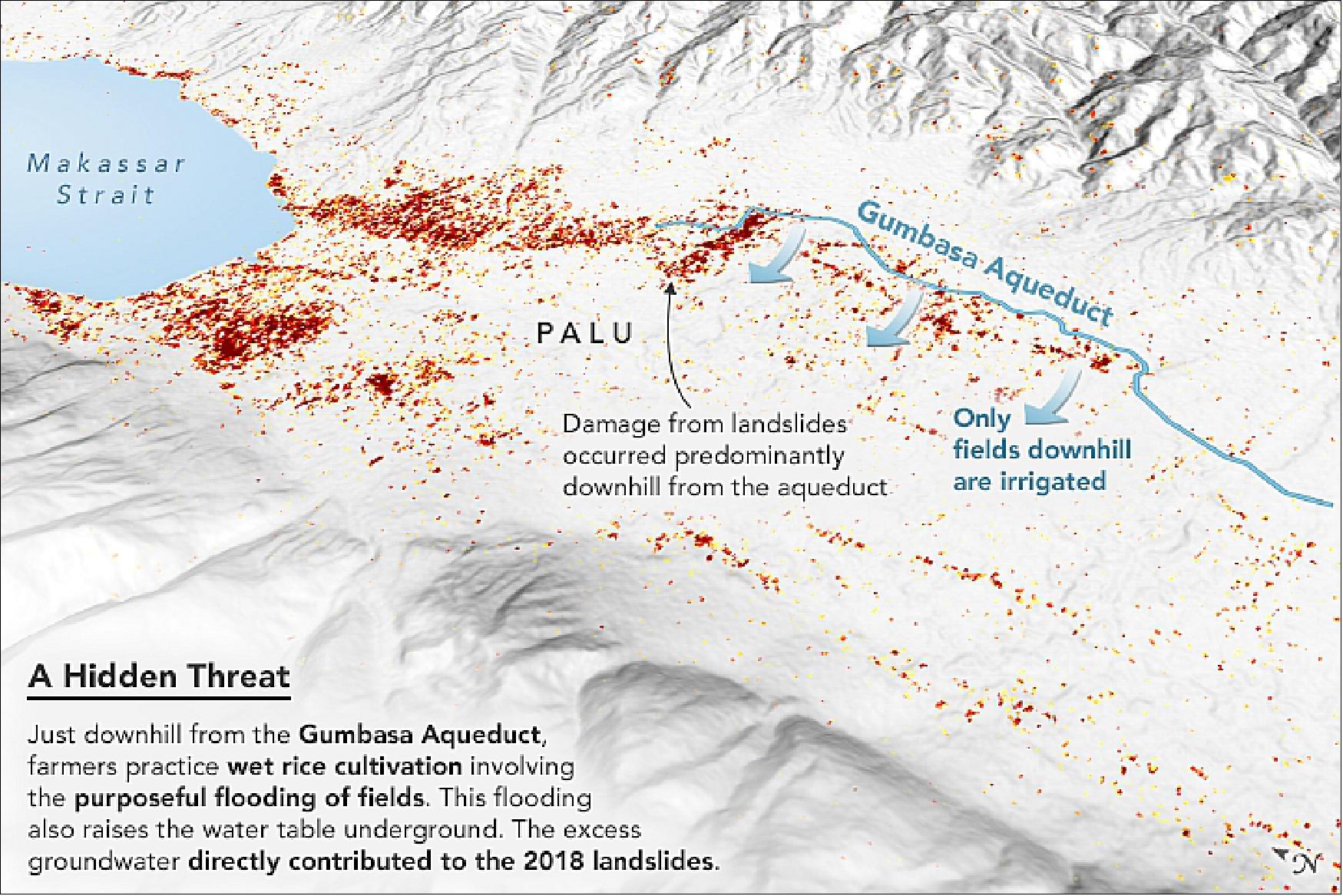
• July 25, 2019: The ground beneath Southern California moved greatly in early July 2019 due to two large earthquakes, one of which was the strongest in the region in at least two decades. At 10:33 a.m. Pacific Daylight Time (PDT) on July 4, 2019, an earthquake struck northeast of Ridgecrest, California, which is north of Los Angeles and northeast of Bakersfield. The magnitude 6.4 temblor turned out to be a foreshock of a stronger quake—magnitude 7.1—that occurred at 8:19 p.m. PDT on July 5 about 6 miles (11 km) to the northwest.
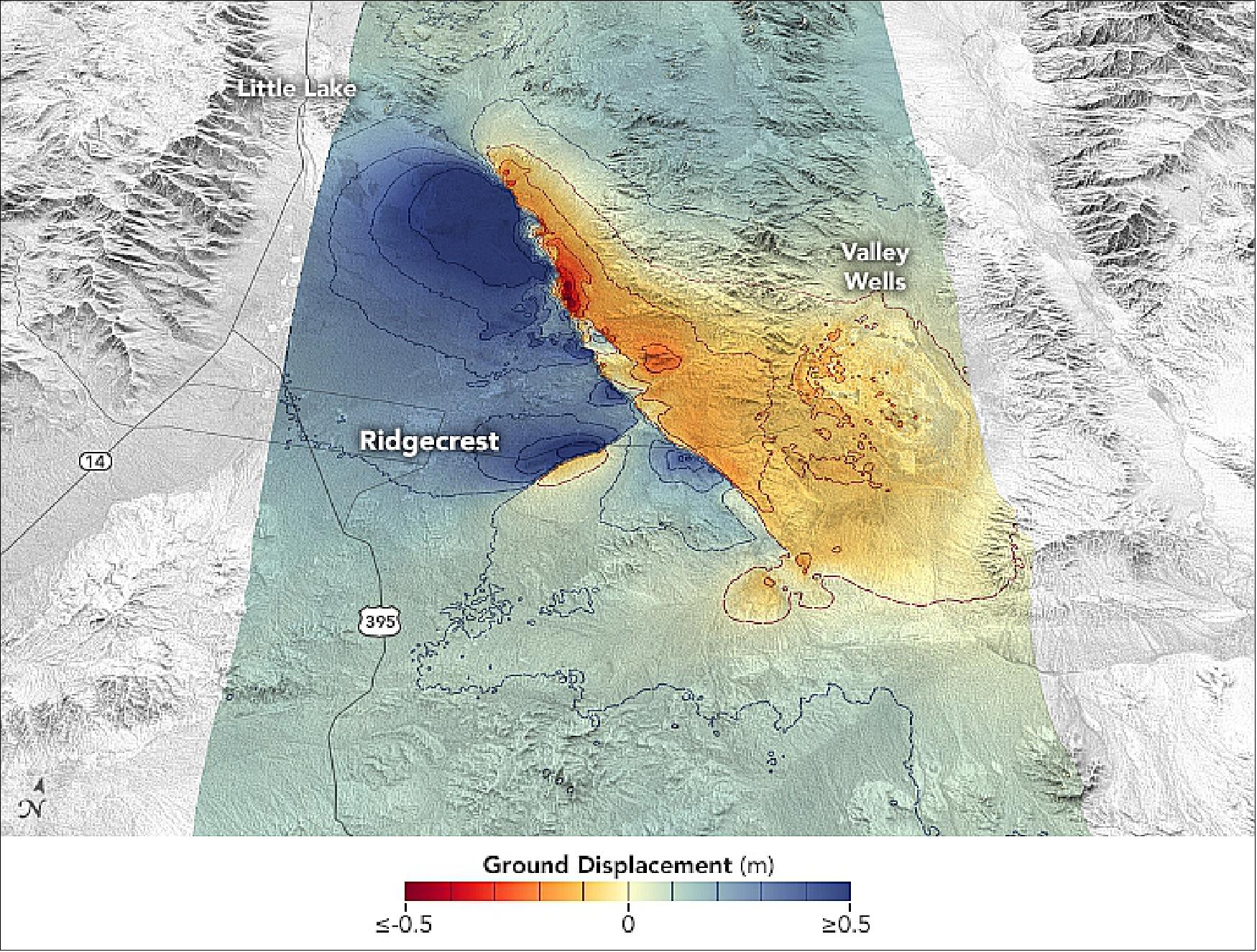
- ARIA researchers compiled and processed SAR (Synthetic Aperture Radar) data from the Japan Aerospace Exploration Agency’s ALOS-2 satellite. SAR instruments bounce radio signals off of the ground and measure the reflections to determine the distance between the ground and the satellite. By comparing SAR images from different days, scientists can determine how much the land surface and human-built structures have shifted. The analysis can be used to estimate where the fault moved deep and which areas have increased stress and a higher likelihood of future earthquakes. NASA provides such maps to the California Geological Survey, the Federal Emergency Management Agency, and USGS as they assess damages and map the faults. The analysis can be used to estimate where the fault moved deep and which areas have increased stress and a higher likelihood of future earthquakes.
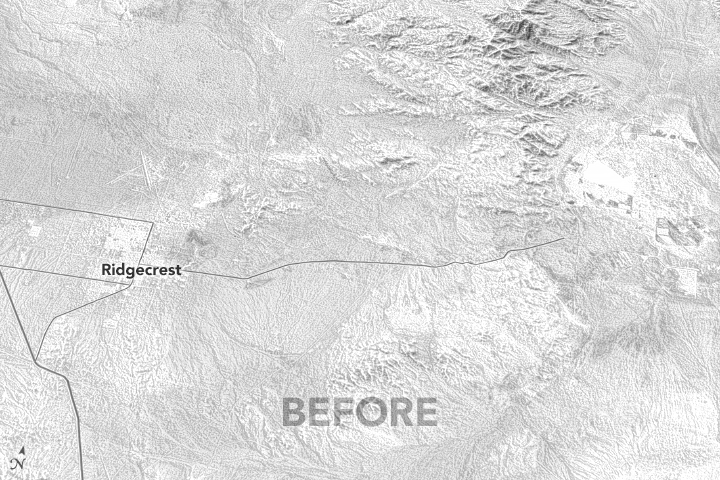
• July 9, 2019: Damage from two strong earthquakes that rattled Southern California on July 4 and July 5 — a magnitude 6.4 and a magnitude 7.1, respectively — can be seen from space. The epicentre of the quakes was near the city of Ridgecrest, about 150 miles (241 km) northeast of Los Angeles. According to the U.S. Geological Survey, the 7.1 quake was one of the largest to hit the region in some 40 years. 31) The Advanced Rapid Imaging and Analysis (ARIA) team at NASA's Jet Propulsion Laboratory in Pasadena, California, used synthetic aperture radar (SAR) data from the ALOS-2 satellite to produce a map showing surface displacement from the earthquakes. The post-quake imagery was acquired on July 8, 2019, and compared with April 8, 2018, data from the same region.
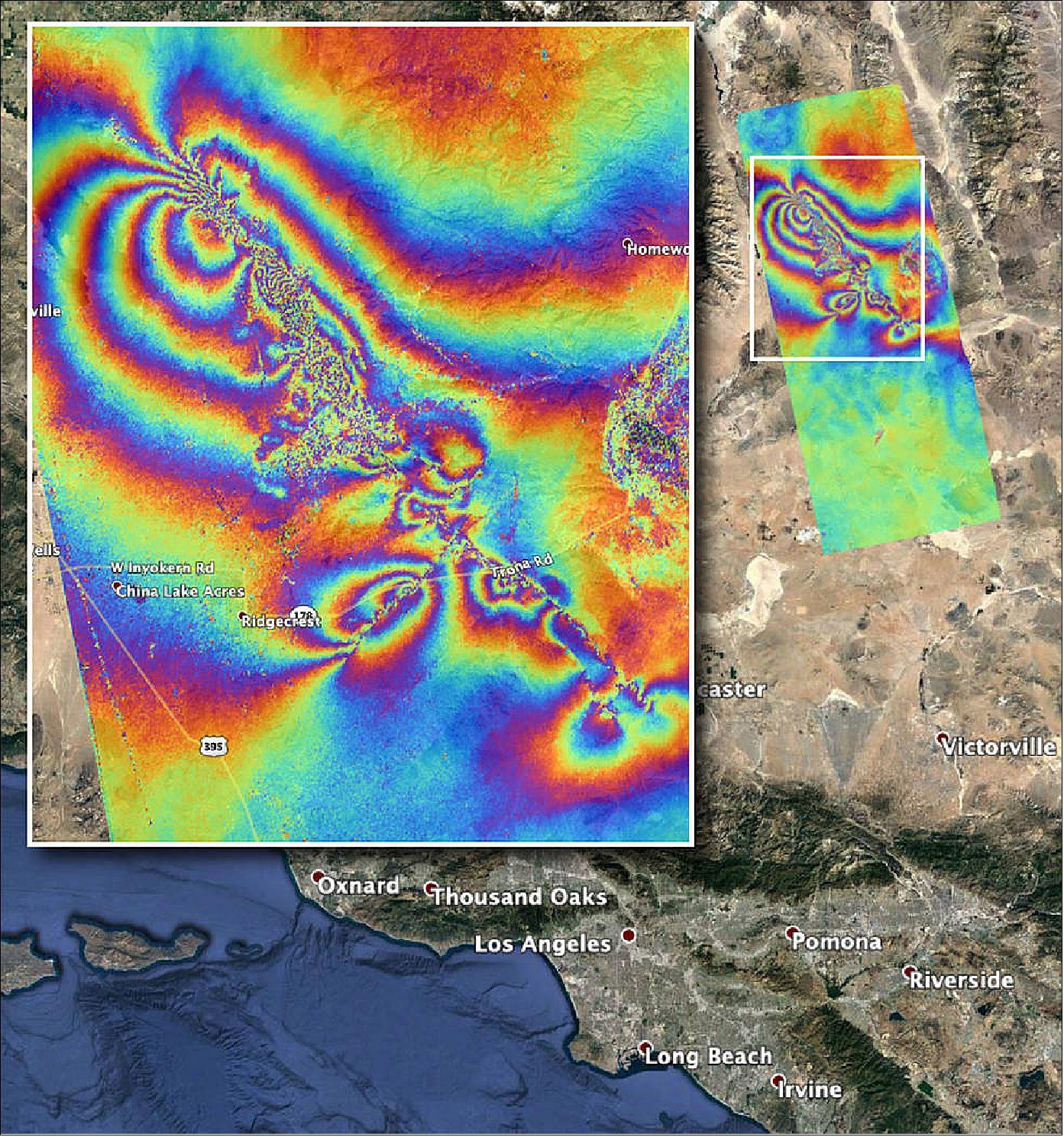
• February 2019: The ALOS-2 mission was in its 5th year on-orbit operating nominally.
• December 22, 2018: A tsunami probably related to the eruption of Anak Krakatau caused serious damage to coastal cities close to the island. JAXA performed an emergency observation by ALOS-2 (“DAICHI-2”) on December 24, 2018 (UTC), and ALOS-2 captured significant topographic changes in the southern island.
Observation date | Path | Mode | Orbit | Direction | Beam | Polarisation |
24 December 2018 | 135 | Stripmap 10 m | Ascending | Right | F2_5 | HH+HV |
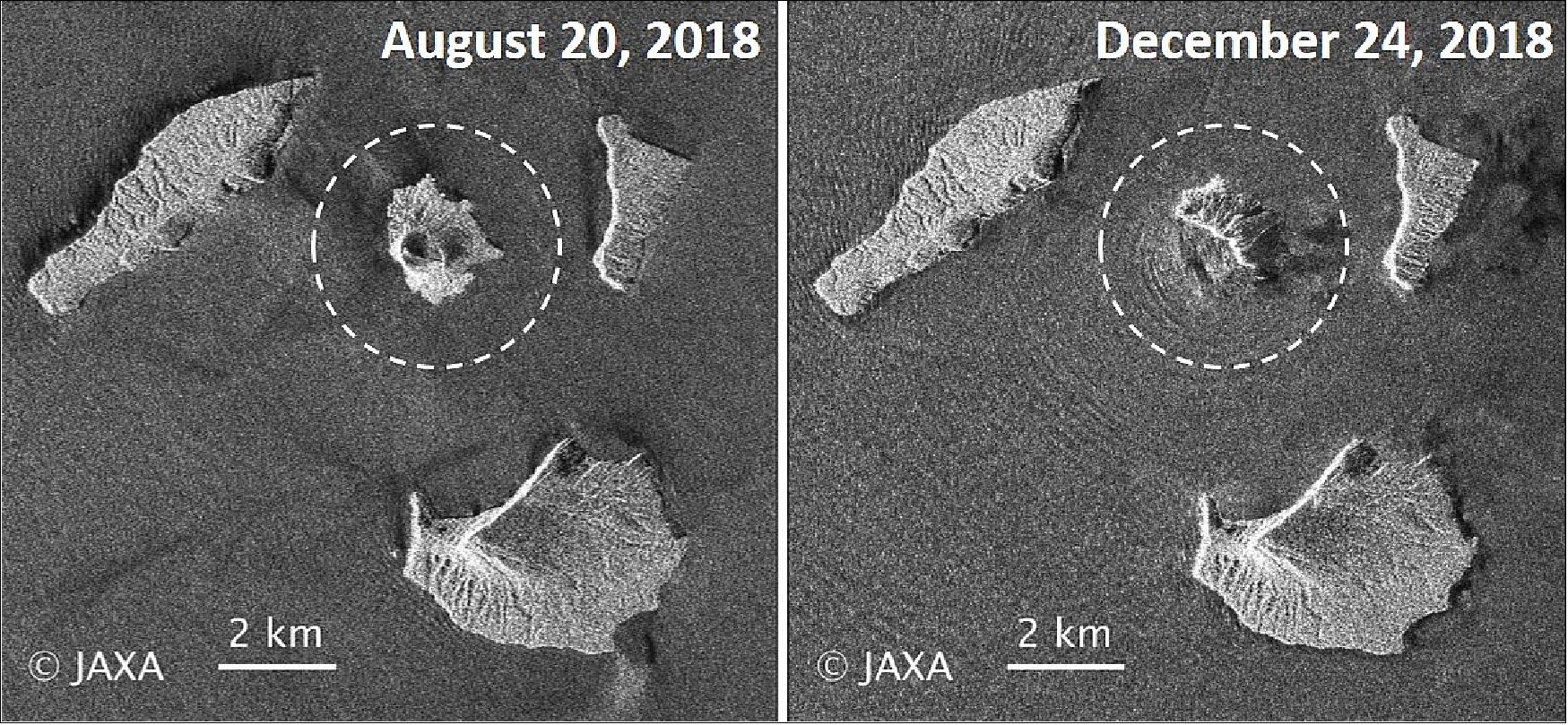
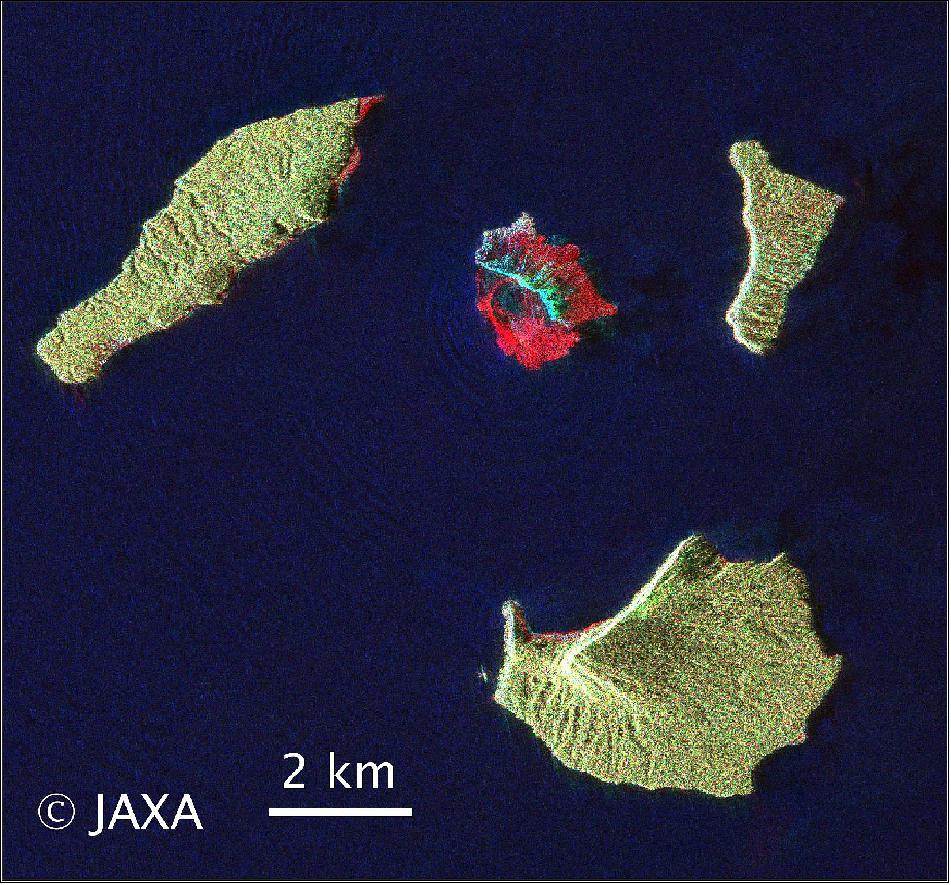
• July 2018: JAXA regularly checks the performance of the ALOS-2 bus system which was operating nominally. The orbit is automatically controlled within a 500 m radius tube around the reference orbit. As shown in Figure 21, the success rate of the autonomous orbit control was almost 100%. The signal plots (Figure 21) of the 16QAM constellation were distributed around the ideal positions, and the obtained frequency spectrums were good, indicating successful data transmission to the ground stations. 33) The PALSAR-2 data were acquired based on a systematic observation strategy known as BOS (Basic Observation Scenario) to achieve consistent data acquisition in time and space. Among the various observation modes of PALSAR-2 such as Spotlight, 3/6/10-m resolution stripmap, and ScanSAR, the coverage of Japan area by 3 m stripmap mode is shown in Figure 21, and the coverage of the global world by 10 m stripmap is shown in Figure 40.
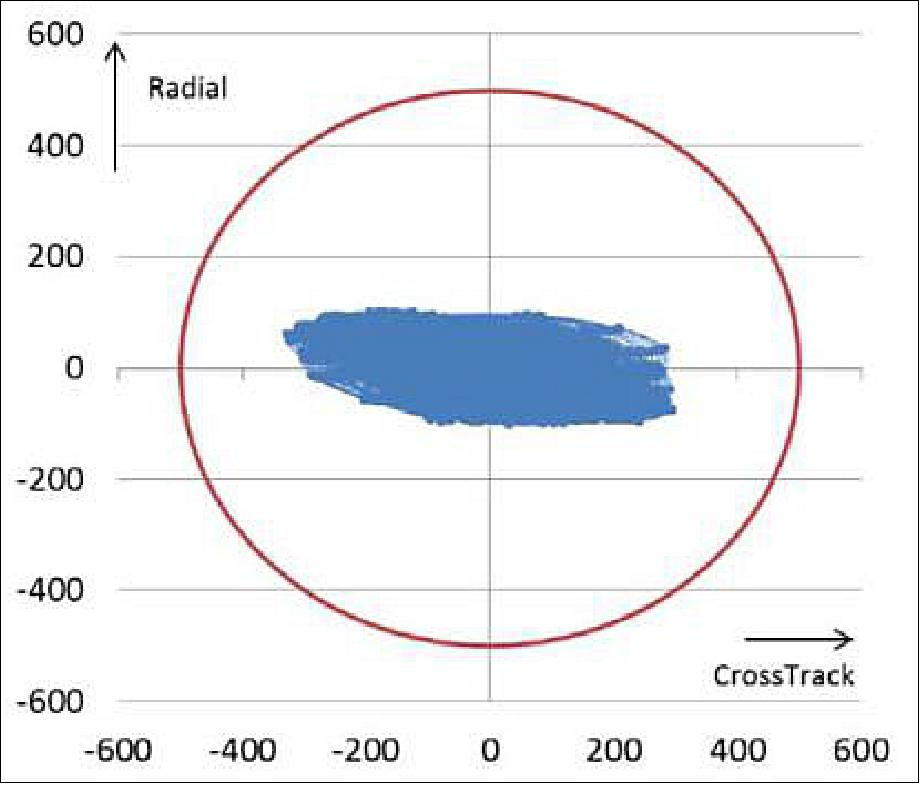
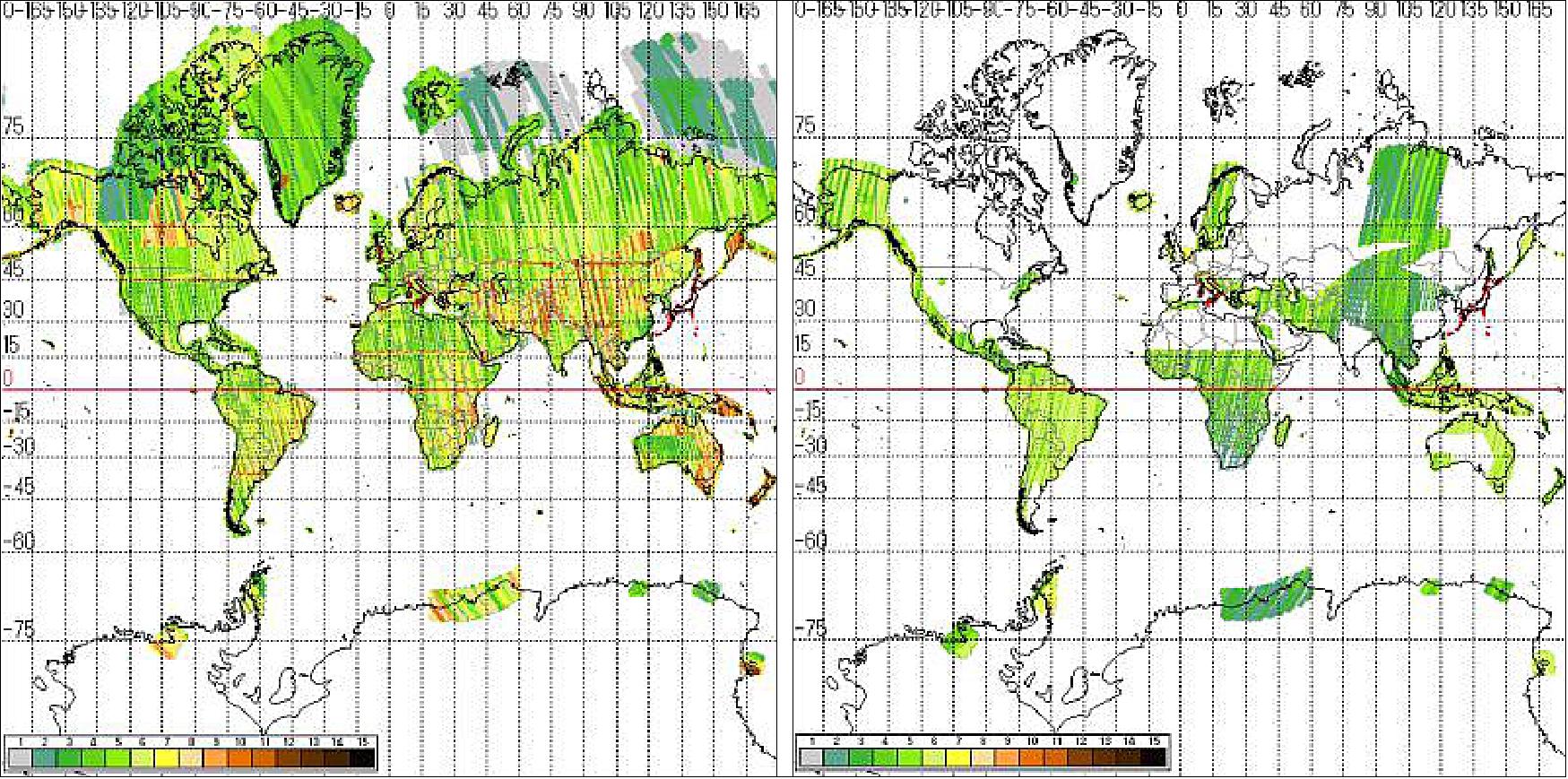
• May 25, 2018: JAXA (Japan Aerospace Exploration Agency) and FRMO (Forest Research and Management Organization)/ FFPRI (Forestry and Forest Products Research Institute), signed a basic agreement concerning the application of Earth observation satellite data to collaboratively solve issues surrounding the global forests. 34) In order to sustain and activate various functions of forests such as the conservation of national landscapes, fostering of water resources and prevention of global warming, it is necessary to monitor the forest resources and to promote forest development systematically. JAXA's ALOS-2/Daichi-2 mission as well as other earth observation satellites promptly monitor wide swaths from space. The observation data enables them to track changes in the forests including disaster-hit and inaccessible areas.
- Based on this agreement, JAXA will provide local governments with satellite data for forest stewardship and the latest status through JICA-JAXA (Forest Early Warning System in the Tropics), JJ-FAST. Data verification will ensue in developing countries to improve the accuracy of JJ-FAST by comparing JJ-FAST data with the ground-based counterpart including statistics on deforestation presented by FFPRI. — FFPRI will use the satellite data from JAXA to examine forest management methods that local governments can employ and explore possibilities to utilise the data for forest monitoring in developing countries. JJ-FAST is a project, jointly developed by JICA (Japan International Cooperation Agency) and JAXA. In November 2016, JICA (Japan International Cooperation Agency) and JAXA launched the “JICA-JAXA Forest Early Warning System in the Tropics” Service to obtain information based on deforestation and forest change data for tropical regions using JAXA’s ALOS-2.35) 36)
• January 24, 2018: The ALOS-2 spacecraft and its payload were operating nominally in 2018. The PALSAR-2 calibration and validation were conducted regularly. Internal calibration involved using the on-board calibration mode every 3 months and keeping good condition after launch. Product quality of major observation modes was evaluated regularly using SAR data over the calibration sites and is part of external calibration. Point target characteristics (resolution, etc.), radiometric accuracy, geometric accuracy and olarimetric calibration were also part of this .

• December 6, 2017: On November 21, 2017, Mount Agung in Bali Island, Indonesia, erupted for the first time in 54 years. JAXA performed an emergency observation with the PALSAR-2 onboard ALOS-2/ DAICHI-2 (Advanced Land Observing Satellite-2) at around 16:38 on November 30, 2017 (UT). 38) Figure 24 illustrates the observation area and the overall image. The observation mode was the high-resolution 10 m mode (dual polarisation). The colour composite in the image represents HH polarisation in red, HV polarisation in green, and HH/HV in blue. In this image, black or dark blue roughly show water or bare land, green shows the vegetation-covered areas, and bright green or purple show the urban areas.
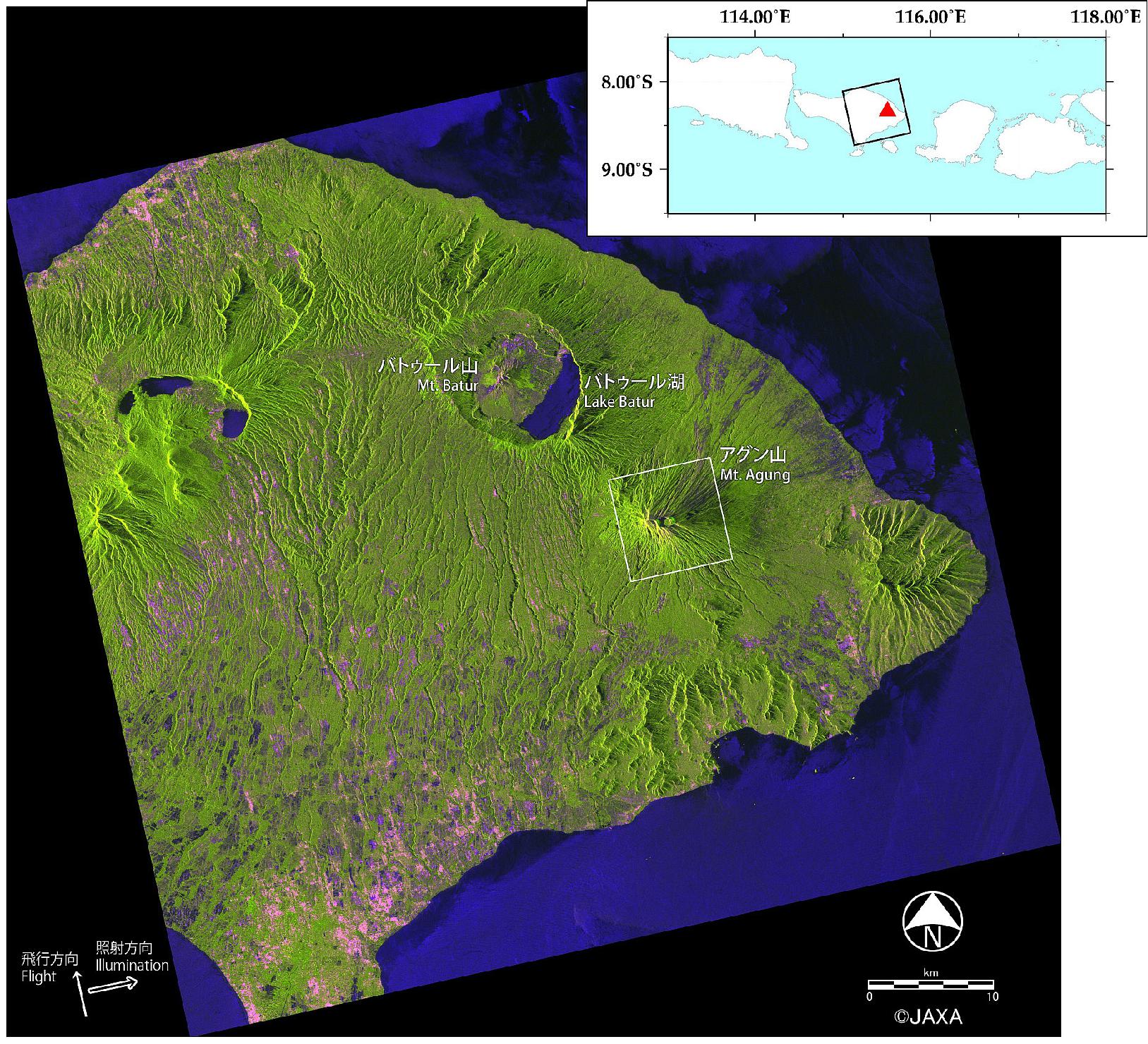
• July 25, 2017: One of Antarctica's largest ice shelf is Larsen. In 1995 and 2002, respectively, Larsen-A and -B were destroyed. West Antarctic ice loss and the global sea level rise are both influenced by the Larsen Ice Shelf. As a result, their dynamics have drawn the interest of glaciologists. On July 12, 2017, a massive iceberg broke off from the Antarctic Peninsula's Larsen-C Ice Shelf. On July 21, 2017, an ALOS-2 ScanSAR observation showed the whole separated iceberg. The observation photograph from August 4, 2017, demonstrates how the sea ice drove the iceberg back towards the ice shelf. According to the observation photograph taken on September 1, 2017, the iceberg has once more begun to drift away from the ice shelf. 39)
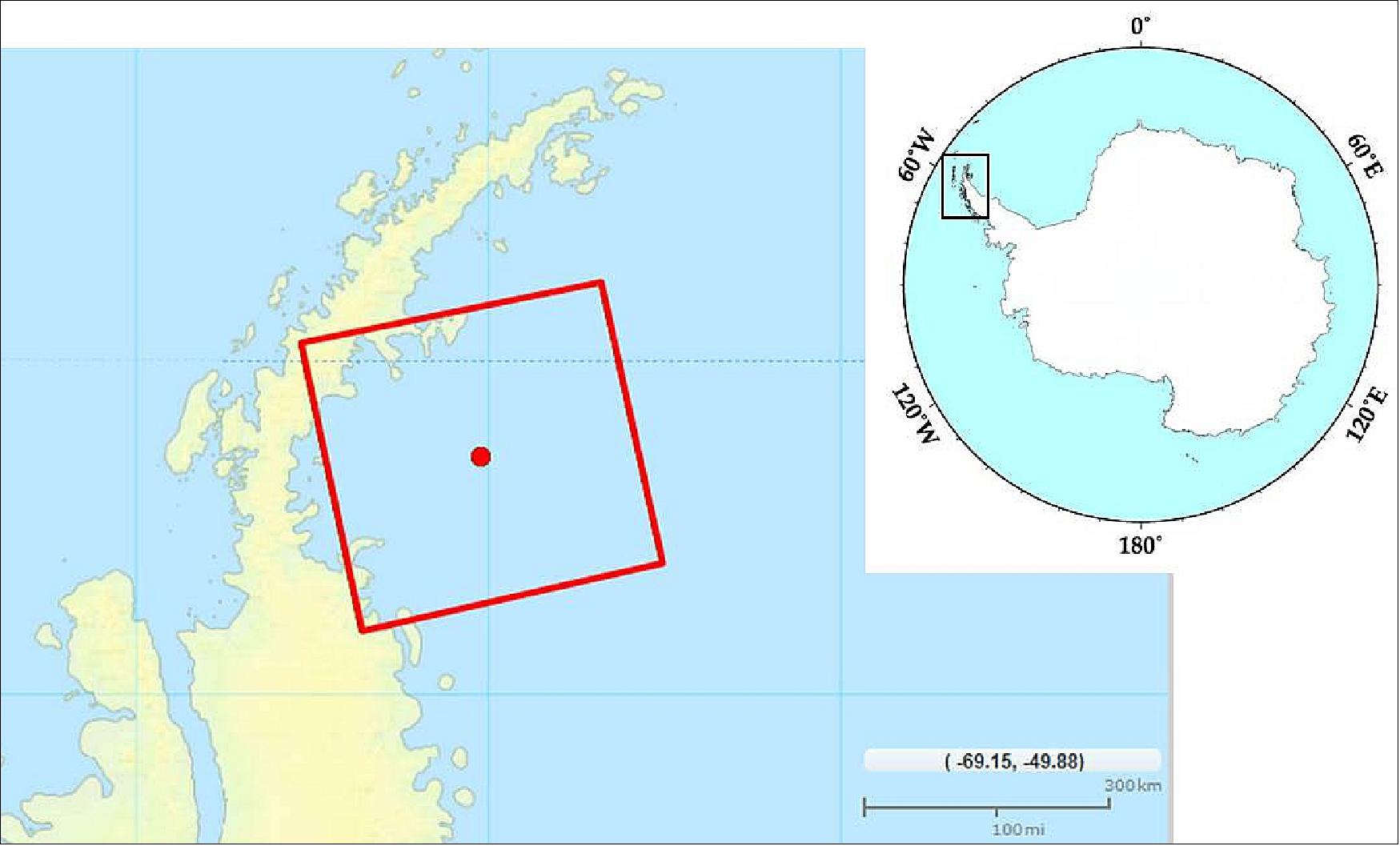
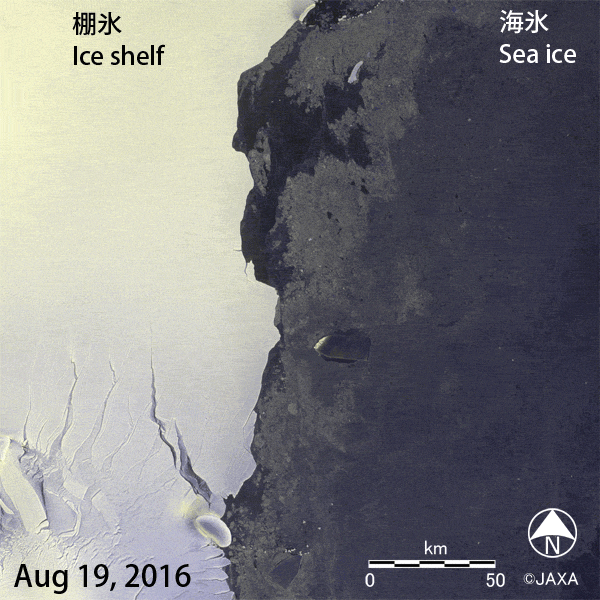
• August 30, 2017: The ARIA (Advanced Rapid Imaging and Analysis) team at NASA/JPL in Pasadena, California, created a Flood Proxy Map depicting areas of Southeastern Texas that were likely flooded as a result of Hurricane Harvey (shown by light blue pixels). The map is derived from synthetic aperture radar amplitude images from the Japan Aerospace Exploration Agency's (JAXA) ALOS-2 PALSAR-2 satellite, taken before (July 30, 2017) and after (August 27, 2017) Hurricane Harvey made landfall. The map covers an area of 350 km2. Each pixel measures about 50 m2. Local ground observations provided anecdotal preliminary validation. This flood proxy map was used as guidance to identify areas that were likely flooded and less reliable over urban areas. ALOS-2 data were accessed through the International Charter. 40) 41)
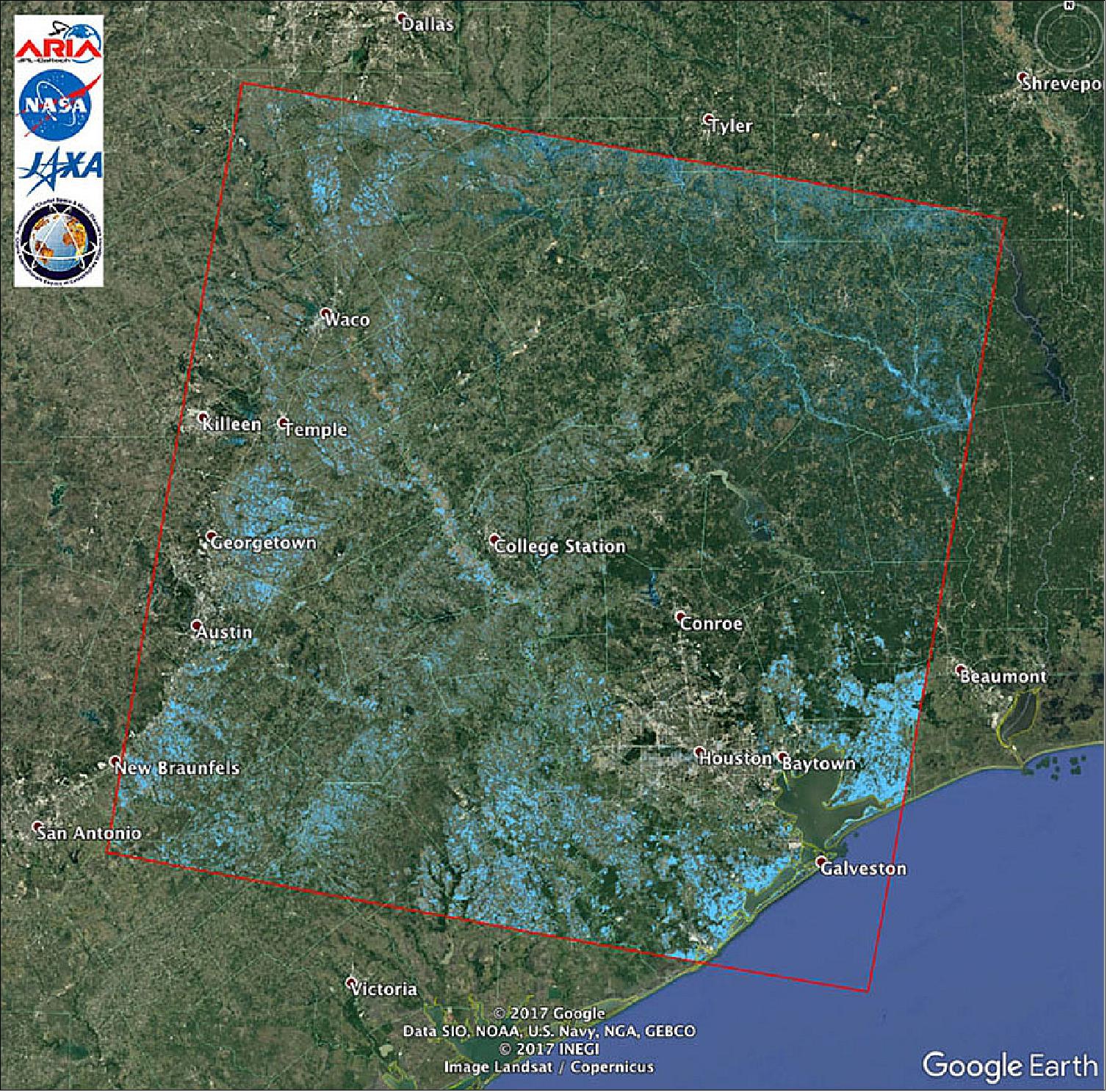
• March 23, 2017: ALOS-2 data contributed to studies of last November's magnitude 7.8 Kaikoura earthquake in New Zealand. 42) 43)The study, led by GNS Science, Avalon, New Zealand, with NASA participation, is published this week in the journal Science. The team found that Nov. 14, 2016, the earthquake was the most complex earthquake in modern history. 44)The research team combined multiple datasets, including satellite radar interferometry and GPS data that measure the amount of ground movement associated with the earthquake, along with field observations and coastal uplift data.
- The scientists analysed interferometric synthetic aperture radar (InSAR) data from the Copernicus Sentinel-1A and -1B satellites, which are operated by the European Space Agency, along with InSAR data from the Japan Aerospace Exploration Agency's ALOS-2 satellite. They compared pre- and post-earthquake images of Earth's surface to measure land movement across large areas and infer movement on faults at depth. The Sentinel and ALOS-2 satellites orbit Earth in near-polar orbits at altitudes of 600 and 700 km, respectively, and image the same point on Earth at repeat intervals ranging from six to 30 days. The Sentinel and ALOS-2 satellites use different wavelengths, which means they pick up different aspects of surface deformation, adding to the precision and completeness of the investigation.Both space agencies re-prioritised their satellites immediately after the quake to collect more images of New Zealand to help with research and support the emergency response activities.
- Before the earthquake, coauthors Cunren Liang and Eric Fielding of NASA/JPL ( Jet Propulsion Laboratory), Pasadena, California, developed new InSAR data processing techniques to measure the ground deformation in the satellite flight direction using wide-swath images acquired by the ALOS-2 satellite. This is the first time this new approach has been successfully used in earthquake research. This paper (Ref. 44) is the first in a series of studies to be published on the rich array of data collected from this earthquake.
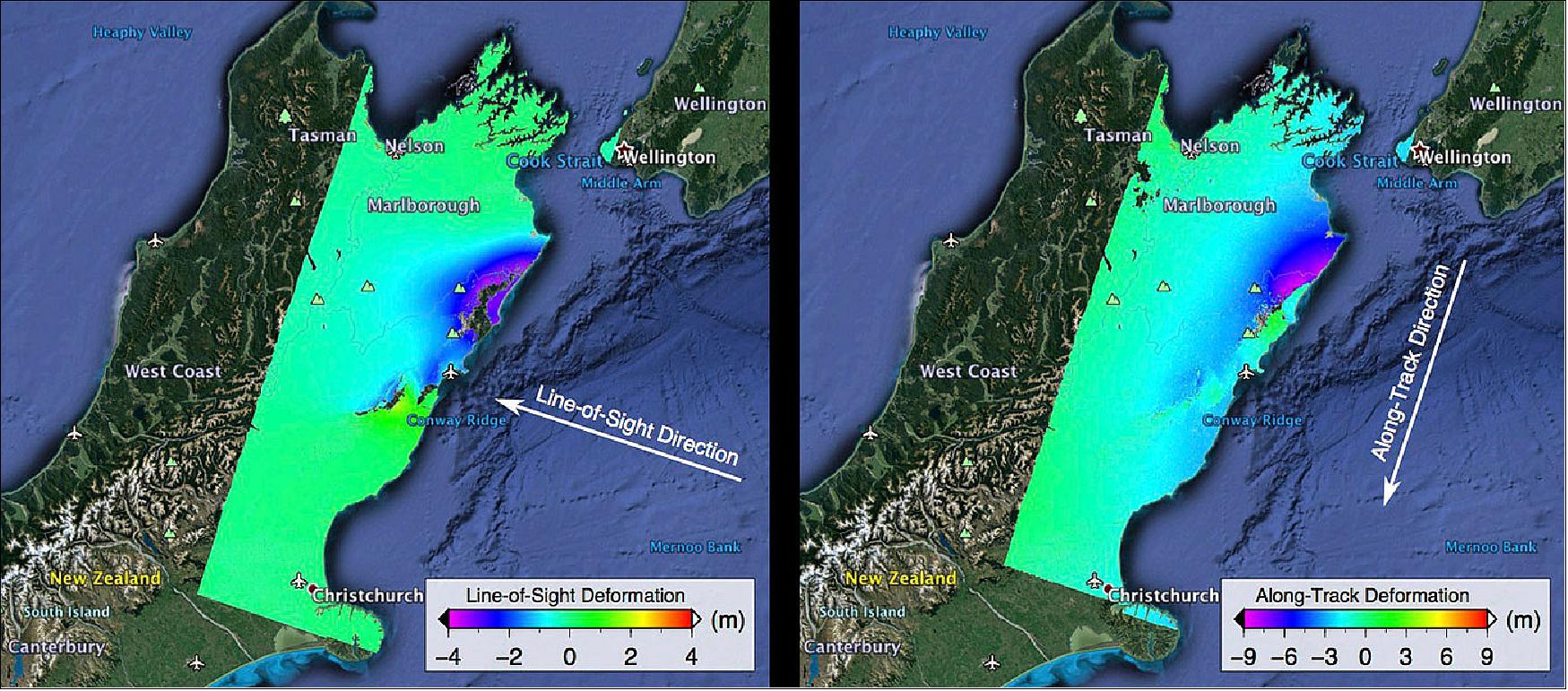
• March 6, 2017: JAXA released the global DSM (Digital Surface Model) dataset with a horizontal resolution of approx. 30 m mesh (1 arcsec) free of charge. The dataset has been compiled with images acquired by ALOS/ Daichi (Advanced Land Observing Satellite). The dataset is published based on the DSM dataset (5 m mesh version) of the "World 3D Topographic Data", which is the most precise global-scale elevation data at this time, and its elevation precision is also at a world-leading level as a 30 m mesh version. This dataset was last updated March 2017 and is expected to be useful for scientific research, education, as well as the private service sector that uses geospatial information.45) The dataset download site is: http://www.eorc.jaxa.jp/ALOS/en/aw3d30/data/index.htm
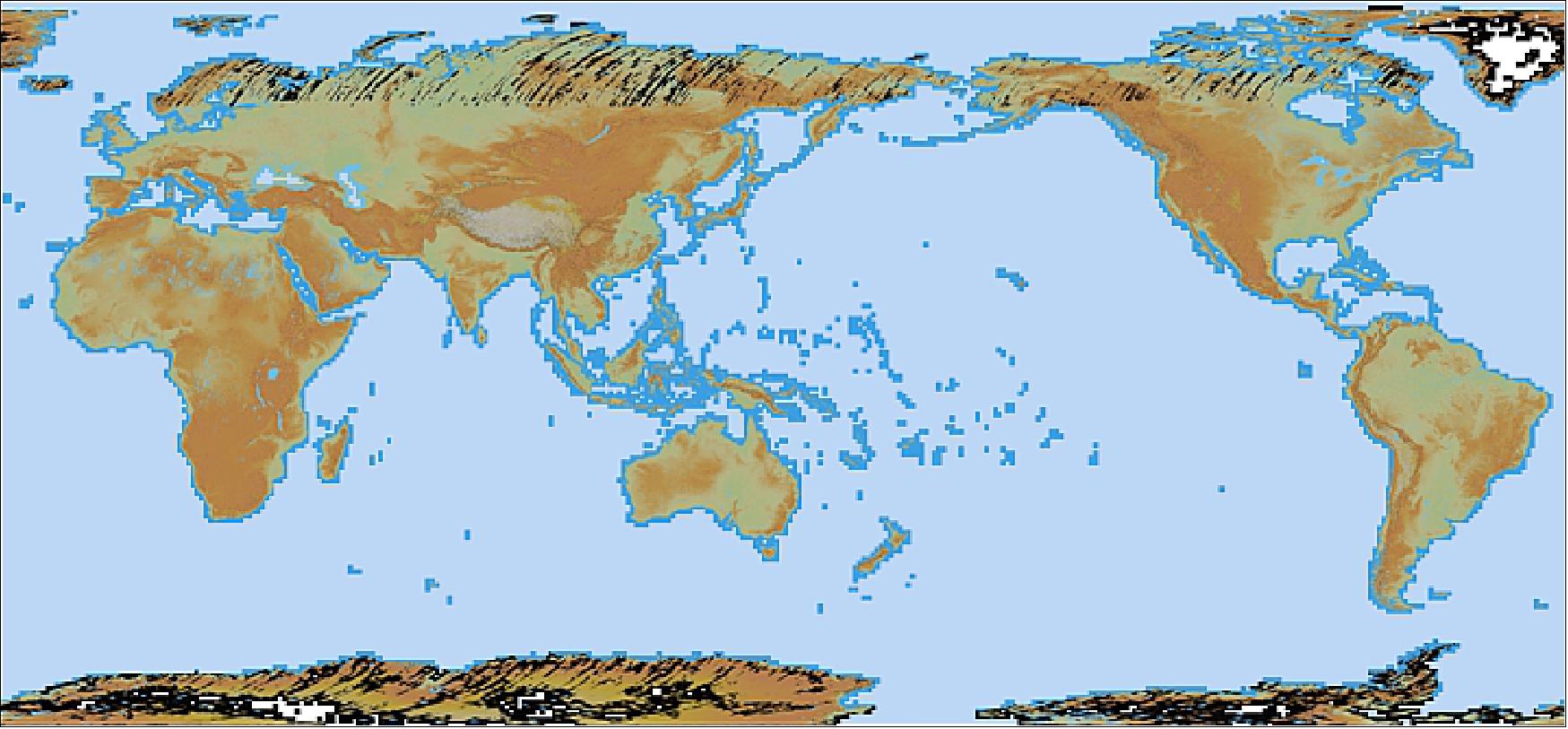
• November 15, 2016: An emergency observation with the PALSAR-2 aboard ALOS-2 (Daichi-2) was performed in response to the magnitude 7.8 earthquake in New Zealand on November 13, 2016 at 1:36 (UTC). Figure 30 shows the observation area. JAXA (Japan Aerospace Exploration Agency) has provided the acquired data to corresponding authorities. 46) Figure 30 shows a differential interferometry (DInSAR) result derived from the PALSAR-2 data acquired before (October 18, 2015; UTC) and after (November 15, 2016; UTC) the earthquake. Two major deformation regions were found, approx. The deformation should be larger in the area between the Kekerengu Fault and the Clarence Fault.
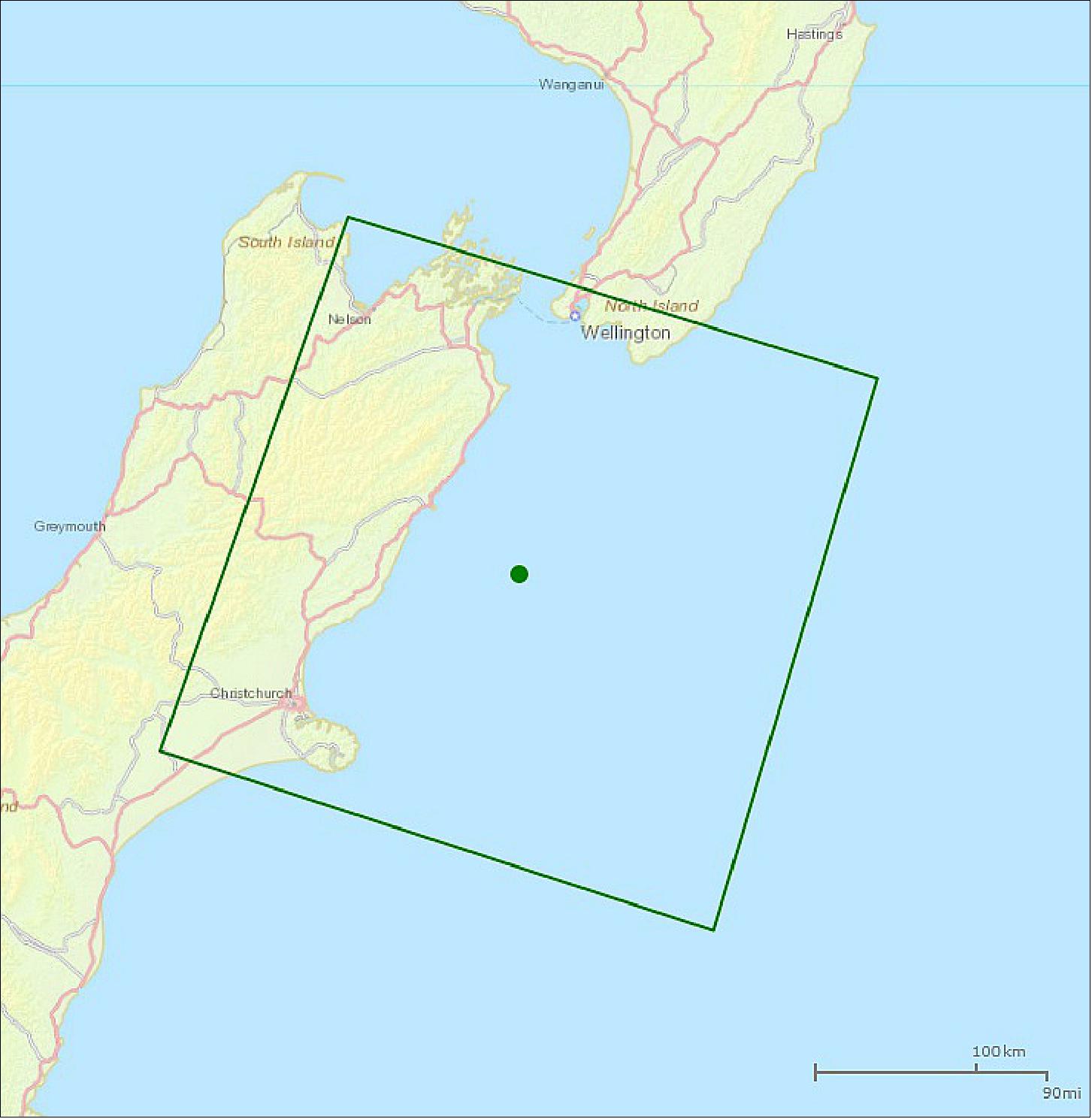
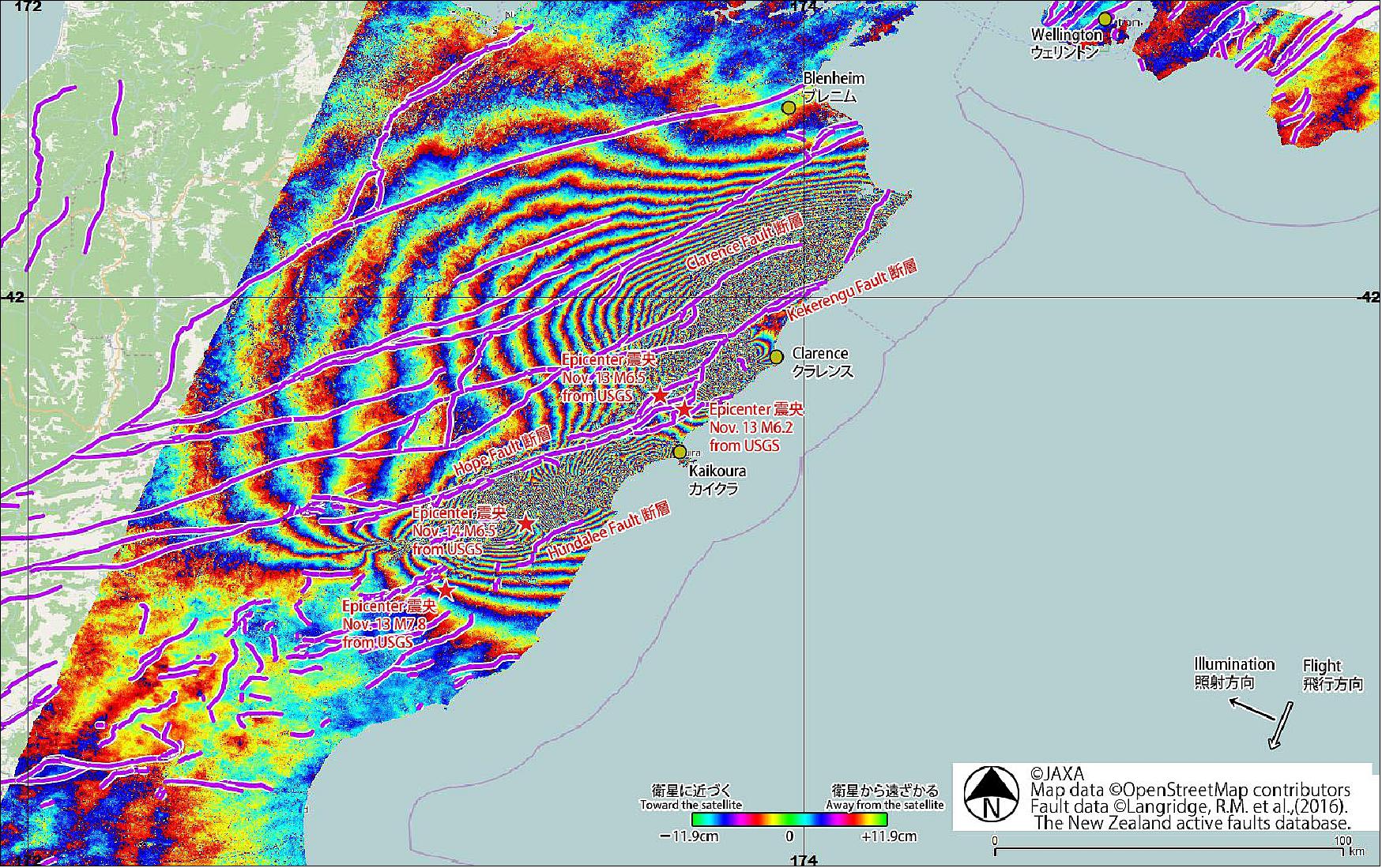
• November 13, 2016: JICA (Japan International Cooperation Agency) and and the JAXA (Japan Aerospace Exploration Agency) launched the “JICA-JAXA Forest Early Warning System in the Tropics” (JJ-FAST) service, easily accessible from PCs and smartphones to obtain information based on deforestation and forest change data for tropical regions using JAXA’s Advanced Land Observing Satellite-2 (ALOS-2). 47) Between 2009 and 2012, JICA and JAXA supported the monitoring of illegal logging in the Amazon Basin of Brazil in near-real time using observation data from ALOS, the predecessor to ALOS-2. More than 2,000 incidents of illegal logging were detected by ALOS in Brazil, which greatly contributed to a 40 percent reduction in illegal logging areas. Building on the knowledge obtained through these efforts. JICA and JAXA then agreed to monitor deforestation and forest changes in tropical regions around the world using data from ALOS-2.
• January 28, 2016: JAXA developed a whole-globe forest map of 25-metre resolution, “Global Forest/Non-forest map”, using the DAICHI-2 (ALOS-2) launched on May 24, 2014, and released it from today free of charge. For achieving a long-term objective of controlling global warming that was set by the UN COP21 (United Nations Conference of Parties 21) held in Paris in December 2015, it is imperative to globally understand and maintain forests which are an important source of absorbing CO2. 48) JAXA planned to provide the Global Forest/Non-forest map by the DAICHI-2 once a year to contribute to measures against global warming through the understanding of forest distribution. JAXA started to release more frequent change information on tropical forests to the world through the “Forest Monitoring System”, which would be implemented in cooperation with JICA ( Japan International Cooperation Agency).
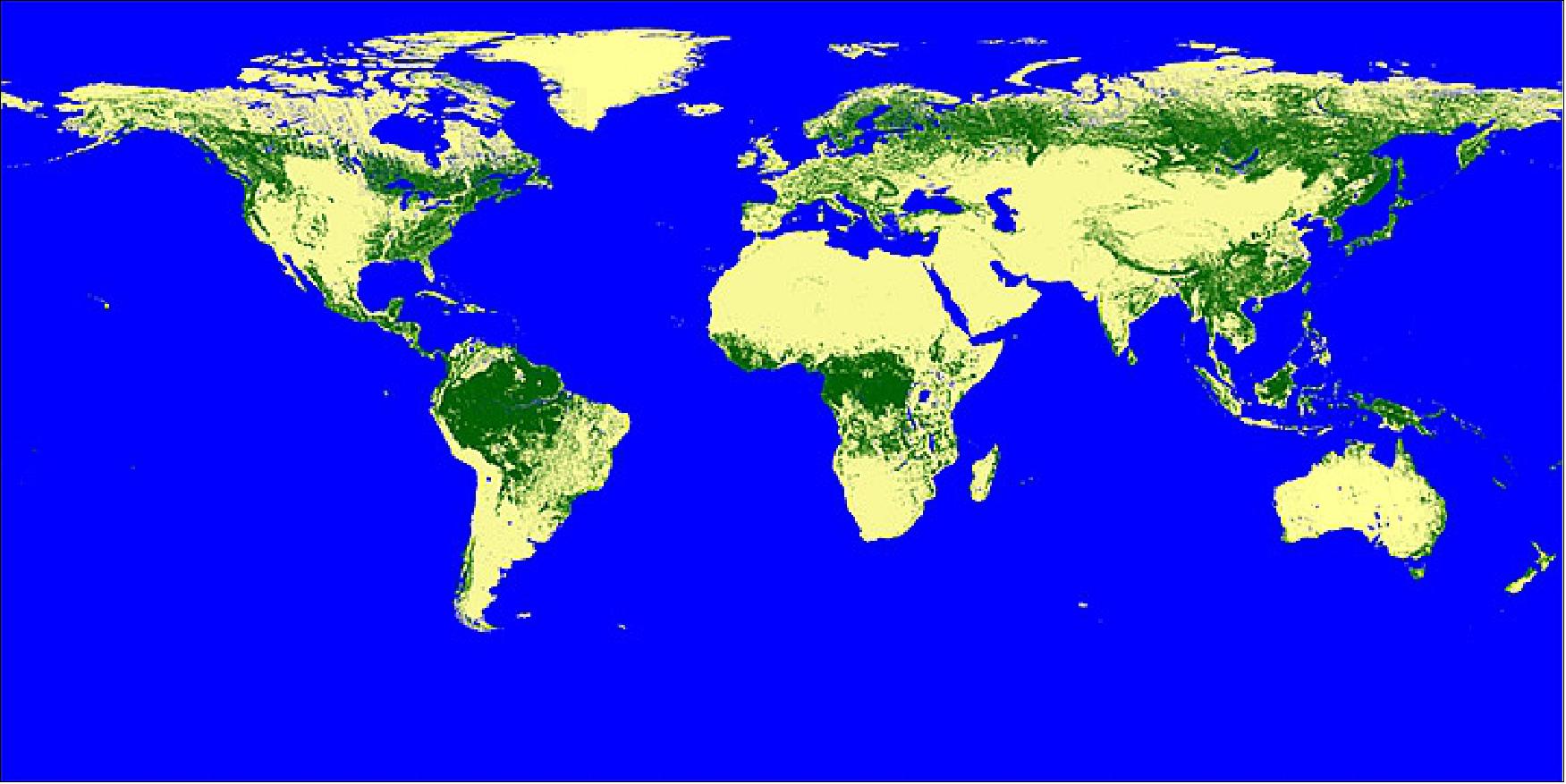
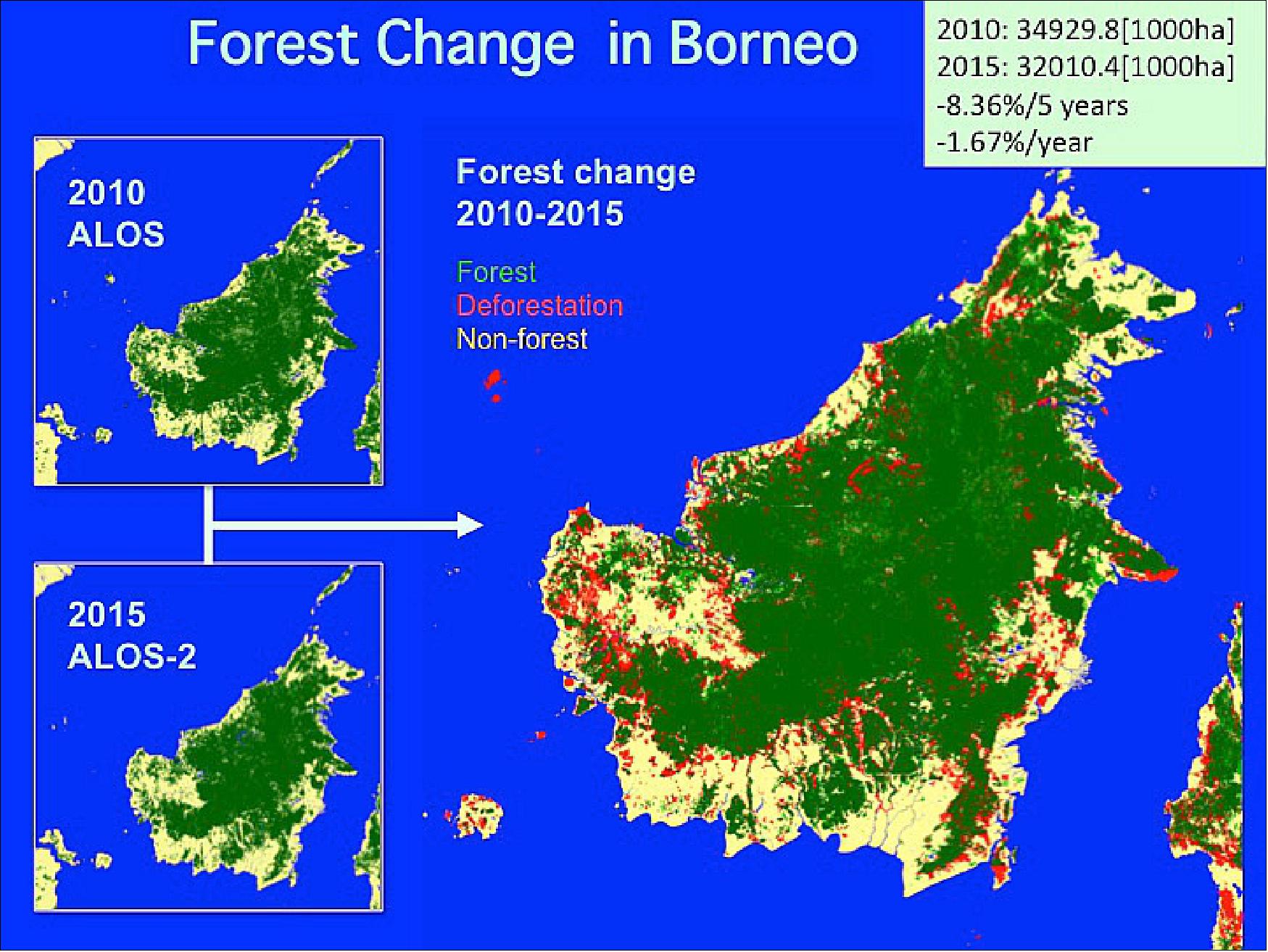
• January 21, 2016: Corresponding to emergency requests from NASA and the International Charter of Space and Major Disasters for flooding of the Mississippi River, JAXA performed an emergency observation over the area using PALSAR-2 (Phased Array type L-band Synthetic Aperture Radar-2 ) aboard ALOS-2/Daichi-2 in the period January 6-16, 2016. 50)
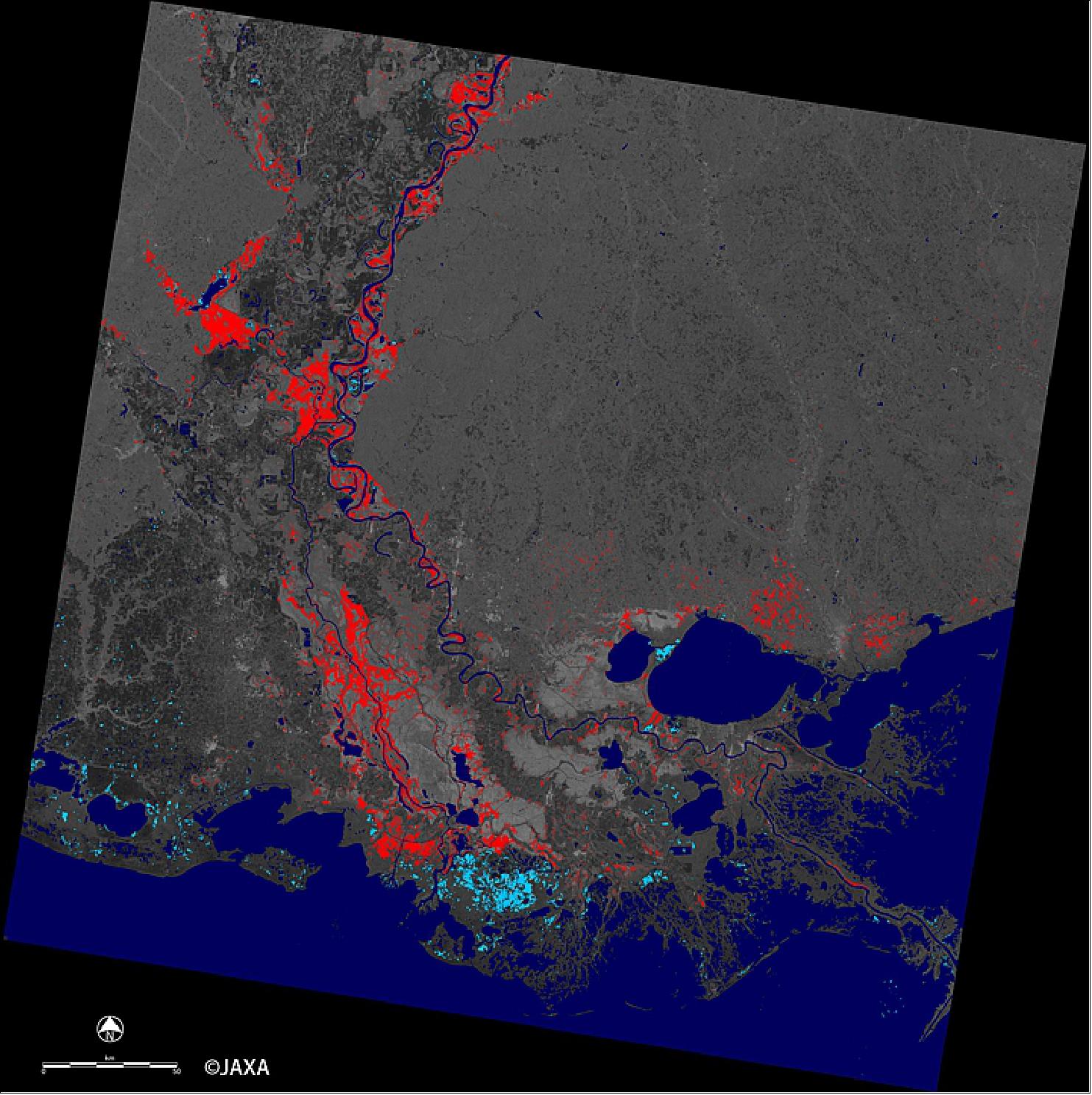
• August 19, 2015: JAXA had observed the volcanic activity of Sakurajima, Japan, using the ALOS-2/Daichi-2 spacecraft, following a request from the Coordinating Committee for Prediction of Volcanic Eruptions of JMA (Japan Meteorological Agency). JAXA was asked to perform an emergency observation as there had been a warning of an eruption since August 16, 2015. 51) The acquired data were immediately forwarded to the Geospatial Information Authority of Japan (GSI) and other related disaster preparation organisations, and analysed for crustal deformation. In the figure below The deformation was up to about 16 cm closer to the satellite was observed at the area on the east side of the Minamidake Summit of Sakurajima (indicated by the white square).
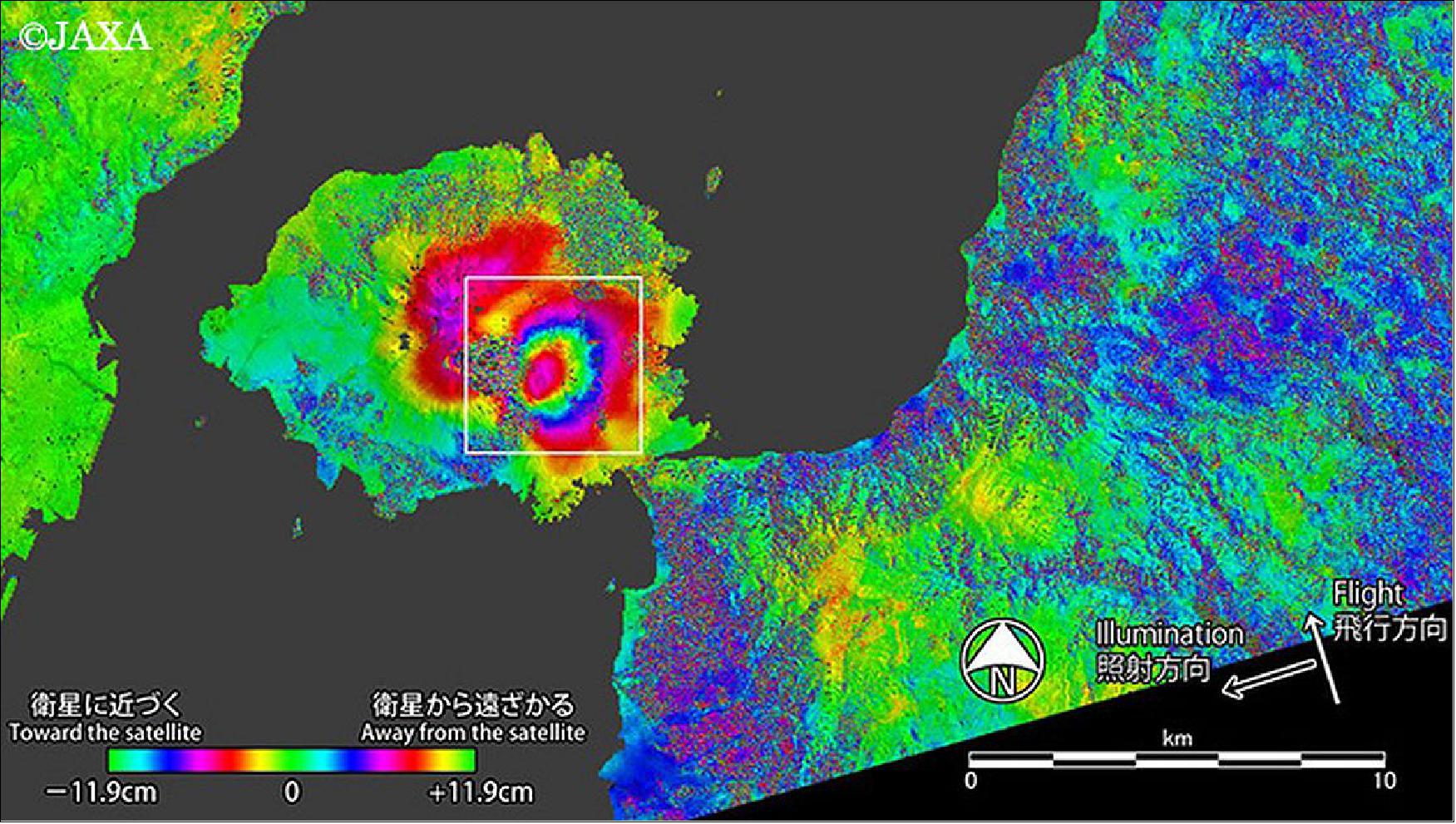
Items | Results | Data | Requirement | |
Geometry (RMSE) | High resolution/ | 5.34m(L1.1) / 6.73 m (L2.1) | 127/129 | 20 m |
ScanSAR mode | 60.77 m (L1.1)/29.93 m (L2.1) | 7/8 | 100 m | |
Radiometry | Corner reflector | 1.31 (CF: -81.60) | 120 | 1.0 dB |
Polarimetry | VV/HH | 1.0143(σ: 0.06) | 6 | 1.047 |
Resolution (m) | Spotlight | 0.79(σ: 0.028)/1.66(σ: 0.04) | 3 | 1.00 x 1.1/1.78 |
Sidelobes | PSLR (azimuth) | -16.20(σ: 2.53) | 124 | -13.26 dB+2 dB |
Ambiguity | Azimuth | 23~14(mean:20) | 7 scenes | 20~25 dB |
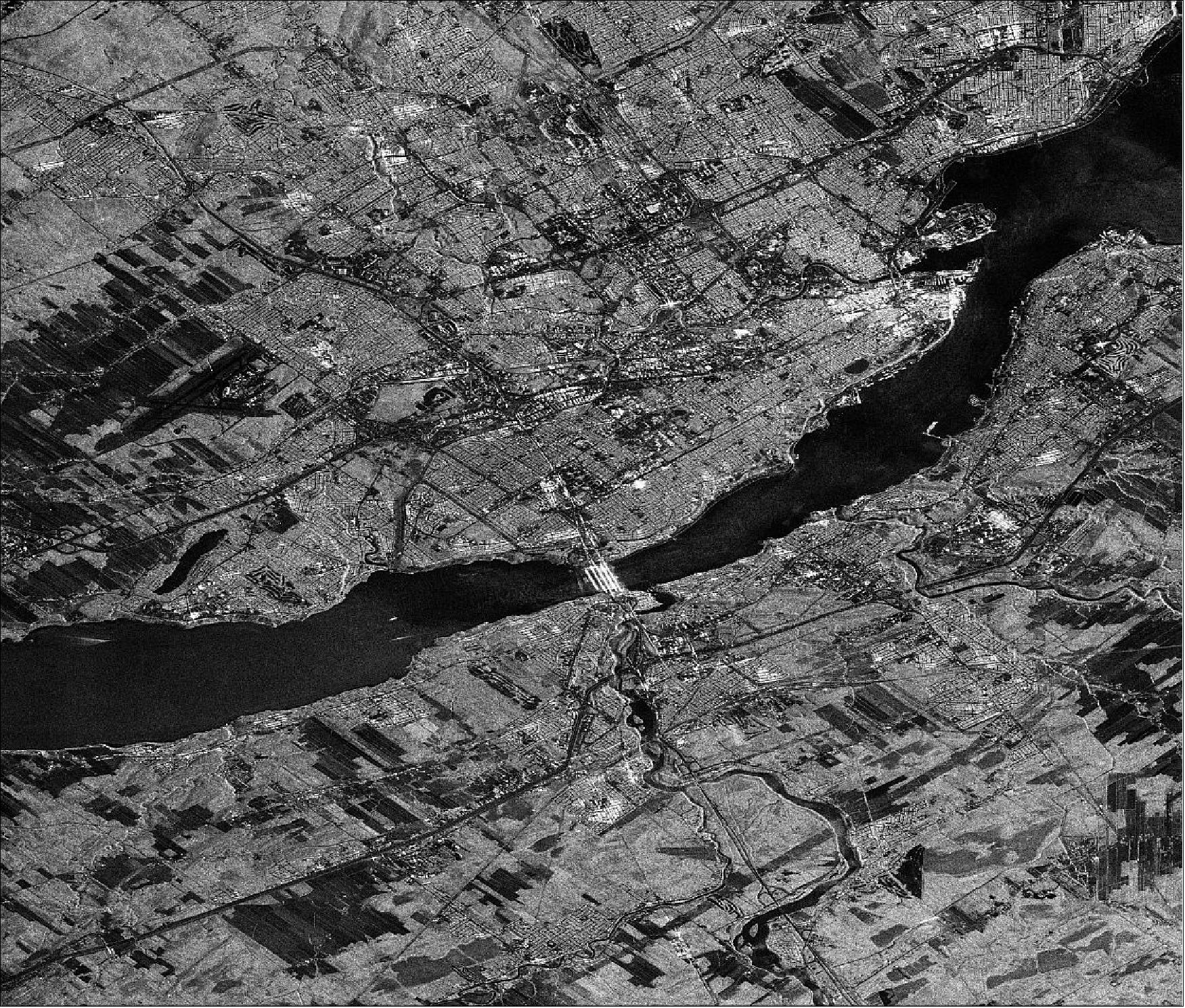
• July 3, 2015: Corresponding to an emergency request from Sentinel Asia related to a GLOF (Glacial Lake Outburst Flood) reported in Bhutan on June 28, 2015, JAXA performed an emergency observation at 5:59 (GMT) on July 2, 2015, using PALSAR-2 53). The ALOS database corresponding to GLOFs in Bhutan located two potential GLOF lakes in the headwater of the Mo Chu River basin. A GLOF (Glacial Lake Outburst Flood) was reported in western Bhutan on June 28, 2015 (local time). 53)
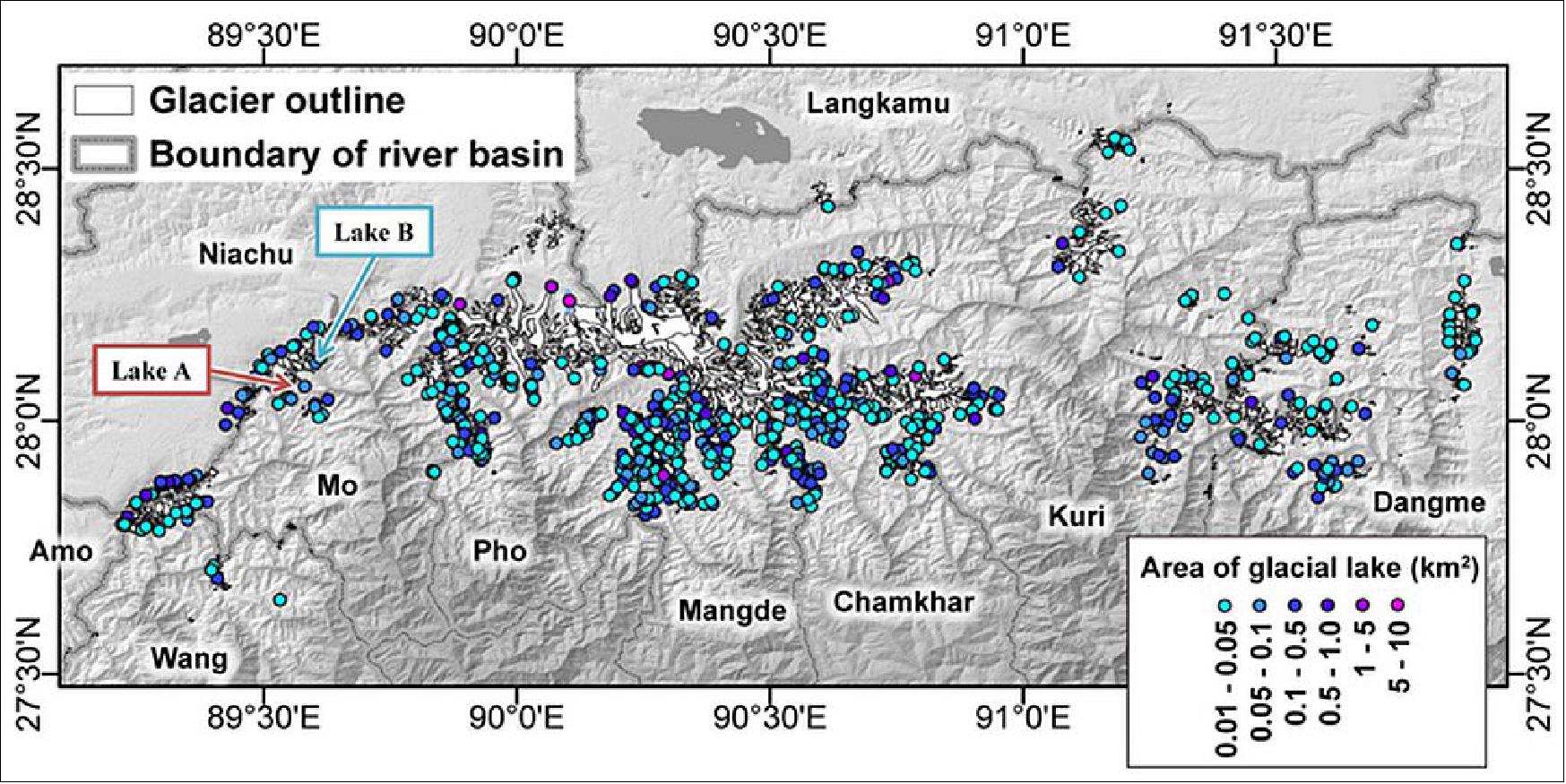
• May 14, 2015: JAXA concluded an agreement with the Kyushu Regional Development Bureau of the MLIT (Ministry of Land, Infrastructure, Transport and Tourism) on April 30, 2015, to provide observation data by theALOS-2/Daichi-2 mission. The purpose of the agreement is to survey (1) secular changes in landscape and ash fall and (2) isolated islands for their upkeep.54)
• May 7, 2015: JAXA performed observations of the 2015 Nepal earthquake, which struck on April 25, 2015 (local time), with the PALSAR-2 (Phased Array type L-band Synthetic Aperture Radar-2) instrument aboard ALOS-2/Daichi-2. The emergency observations were requested from Sentinel Asia and the International Charter. 55) During the earthquake investigation JAXA observed the crustal deformation due to the quake over the Kathmandu area with the ALOS-2 PALSAR-2 data. The deformation area extended more than 100 km from north to south. The project applied an interferometric analysis to the PALSAR-2 data acquired before (Feb. 21, 2015) and after (May 2, 2015) the quake to map the crustal deformation. Coloured fringes denote the change of LOS (Line-of-Sight) distance (distance between the satellite and the ground) between the two observation dates. The dense fringes distributed throughout the image show that the deformation extended at least 100 km from north to south. A large elliptical fringe at just south of the image centre means that the LOS distance became shortened, and the land at the centre of the fringe moved at least 1.5 metres.
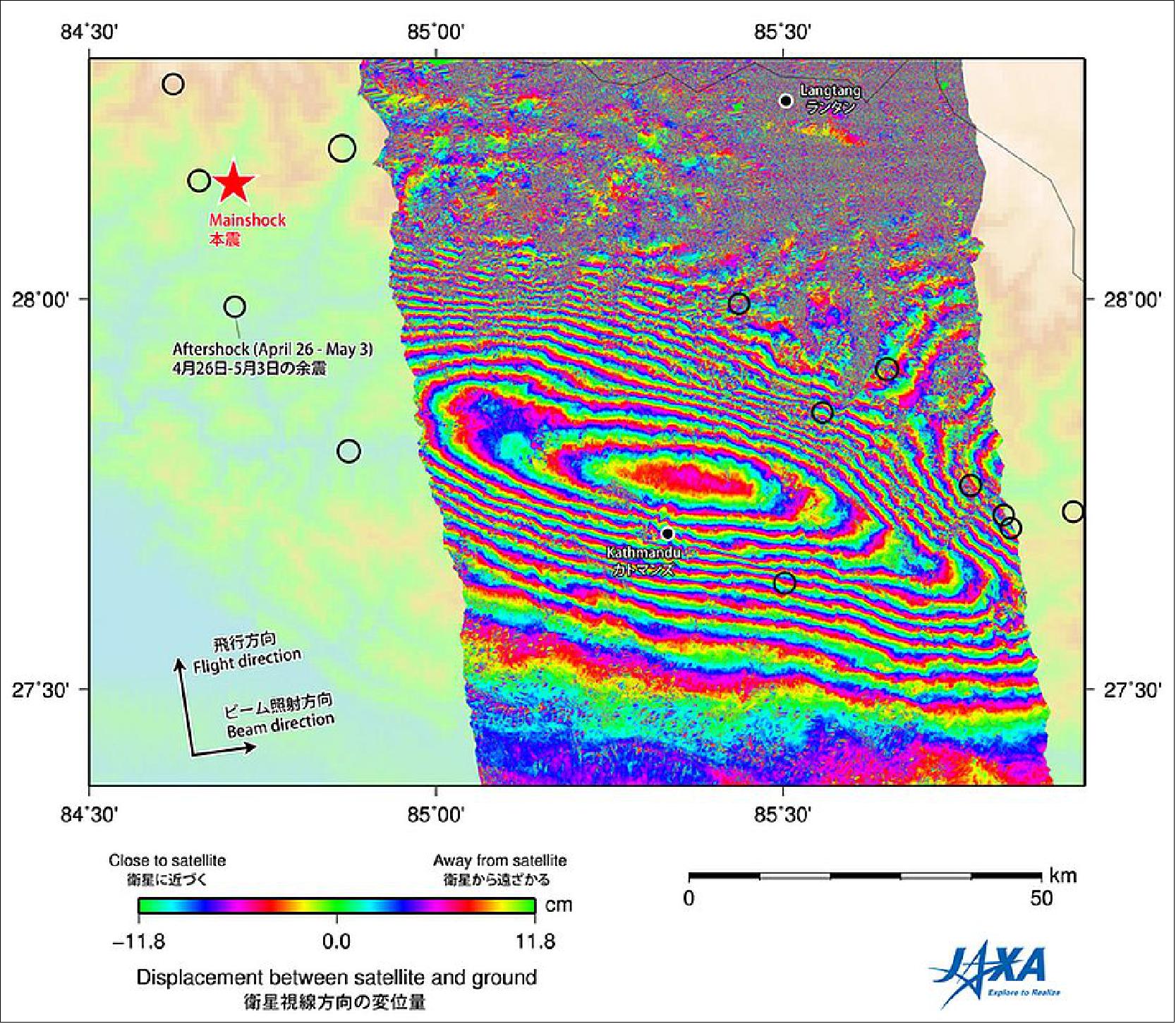
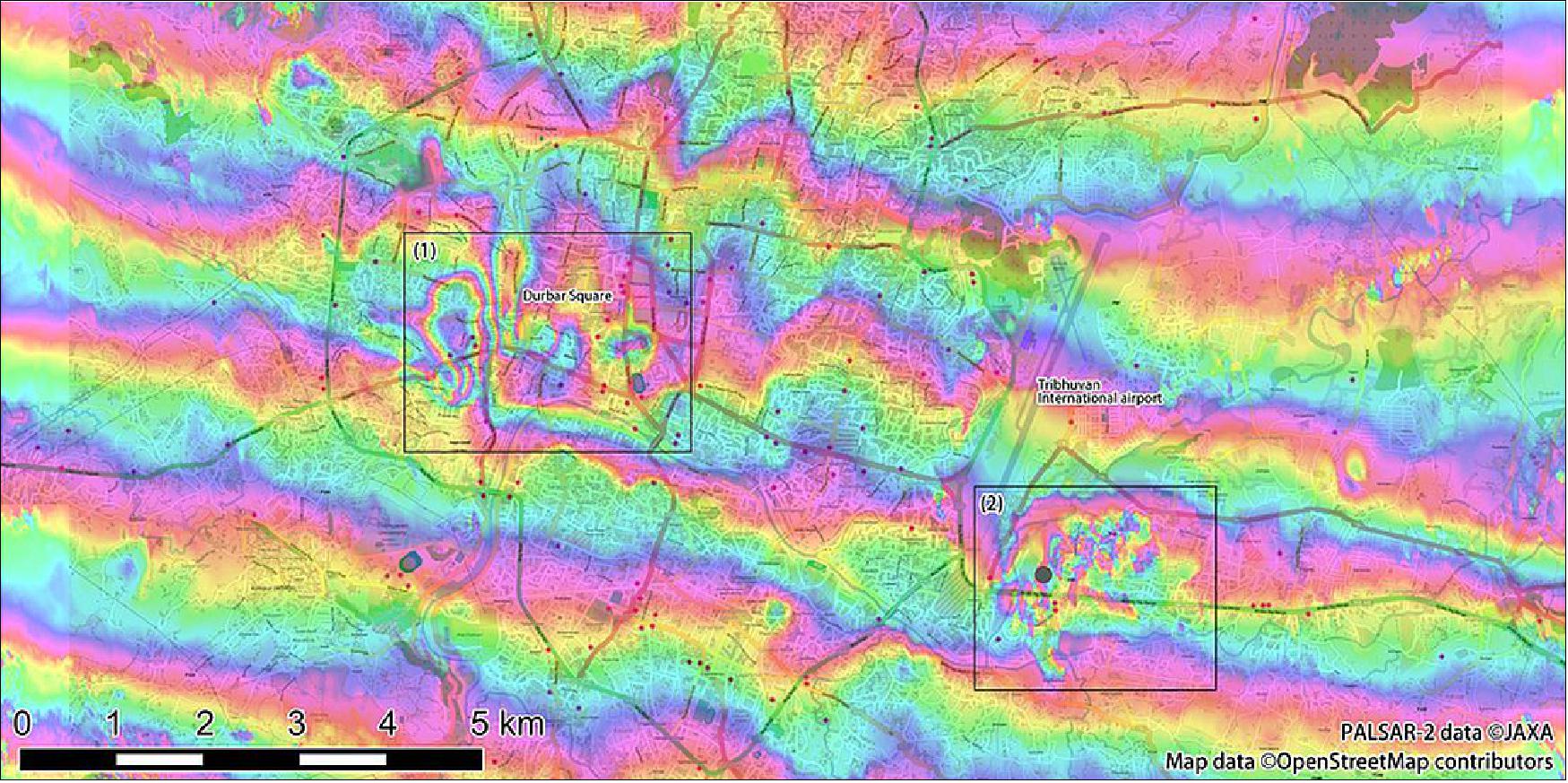
• May 5, 2015: JAXA performed emergency observations with the PALSAR-2 (Phased Array type L-band Synthetic Aperture Radar-2 (PALSAR-2) aboard ALOS-2/Daichi-2 for monitoring the effects of an earthquake struck Nepal on April 25, 2015 over Kathmandu. The figure below shows the coverage area of the data. 56)
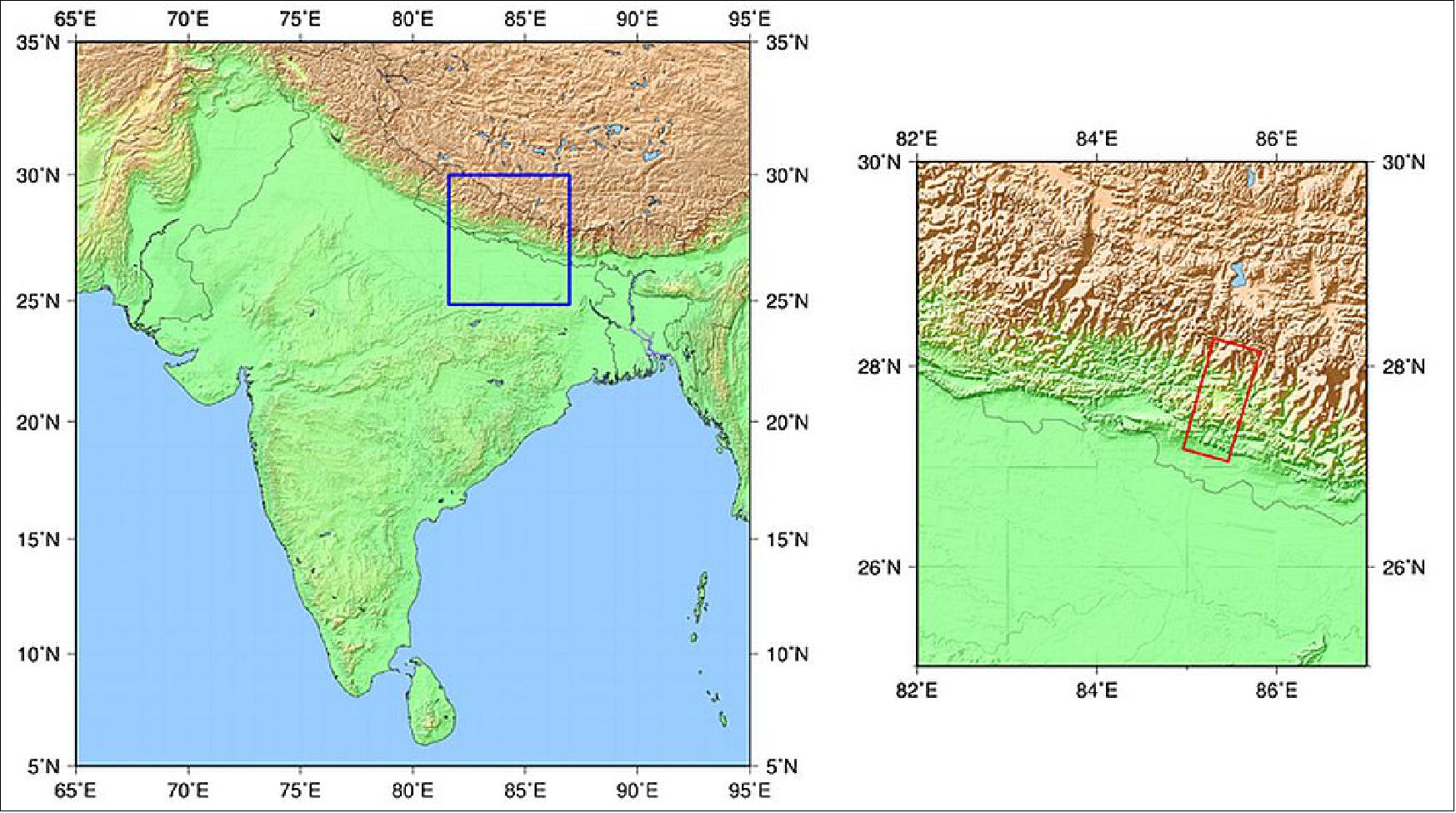
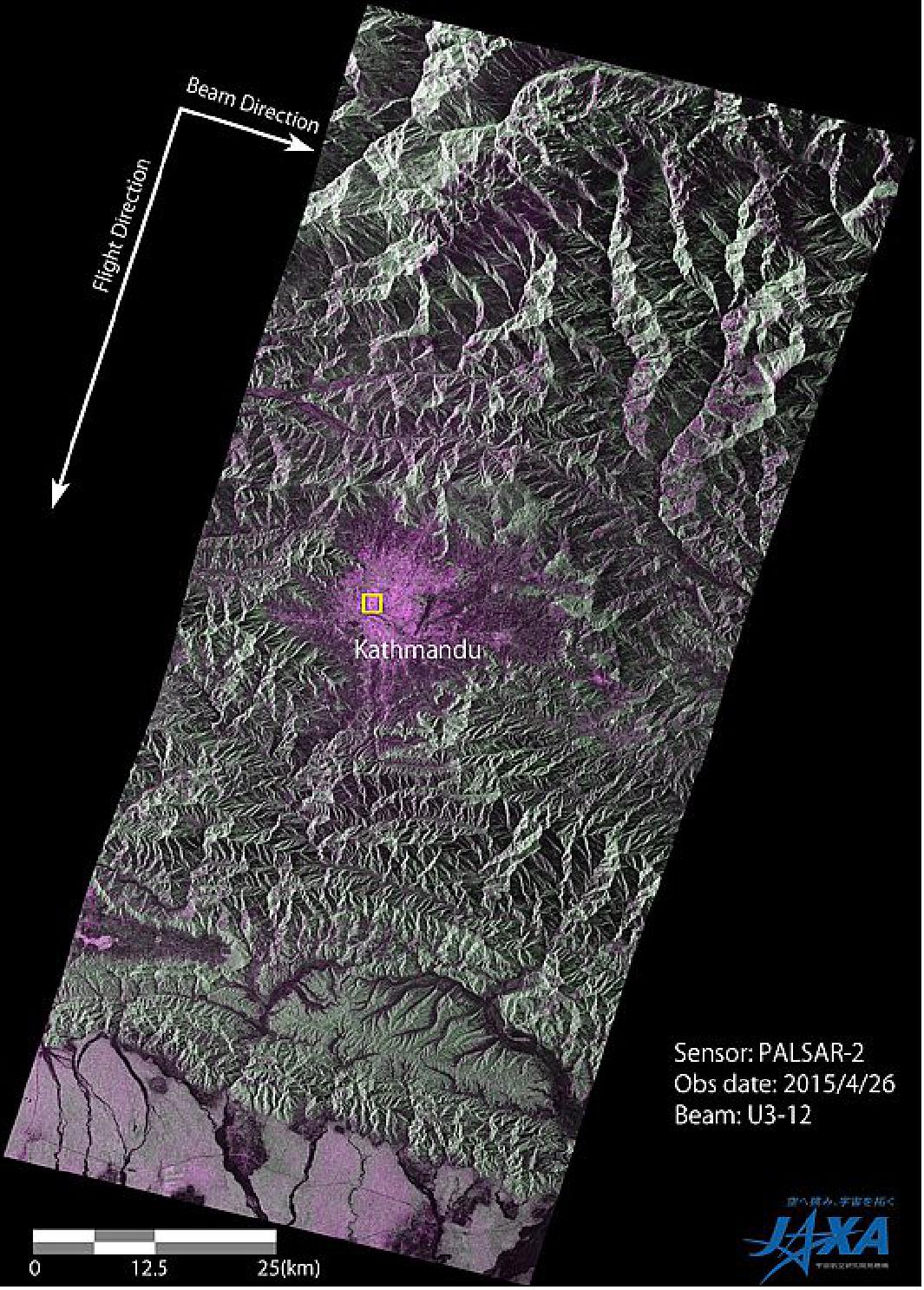
• January 23, 2015: After the calibration and validation of ALOS-2/CIRC (Compact Infrared Camera), JAXA confirmed the data quality of ALOS-2/CIRC was adequate. All ALOS-2/CIRC data is available from CIRC observation data search, if the user follows the CIRC data policy. The ultimate goal of the CIRC project is to minimise the damage and impact caused by forest fires, as well as contributing to urban planning and our understanding of volcanic disasters. 57)
- PALSAR-2 instrument performance parameters showed the 13 dB of SNR, 5 dB larger than PALSAR and very low saturation. Radiometric and geometric performances of all the modes (SL, UB, HB, FB, WB, and VB) met the mission requirements (i.e., 0.4 dB radiometry, 5.34 RMSE of geometry, quite low NESZ, resolution of all the modes, cross-talk of the polarimetry of -40 dB) Interferometry performance, polarimetric performance were confirmed and deformation detection could be conducted.The ALOS-2 observation phase started for the global observation based on BOS (Basic Observation Scenario) on August. 20, 2014. Polar regions were well covered. The forest region was not fully covered for 2014 (50%). The daily data acquisition volume was 800 GB. RFI (Radio Frequency Interference) was the biggest issue of the L-band SAR image quality.
• November 25, 2014: JAXA declared the ALOS-2/Daichi-2 mission “operational“. Regular provision of observation data began after the completion of the commissioning phase (i.e., completion of functional confirmation and of calibration operations). 59)
• September 30, 2014: JAXA captured images of depressions and deposition of falling ash following Japan's Mt. Ontake's volcanic eruption in September . The observations were conducted according to a request from the Coordinating Committee for Prediction of Volcanic Eruptions (Secretariat: Japan Meteorological Agency) and the Cabinet Office (Disaster Management) under the agreement with ministries related to disaster management. JAXA continued to observe Mt. Ontake in cooperation with the disaster management agencies.60) The PALSAR-2 can capture the status of the volcanic crater without being hampered by fumes by seeing through them thanks to its long radio wave length of L-band (1.2 GHz bandwidth). In the left image (after the eruption), a new depression measuring 210 m in length and 70 m in width was newly created due to the eruption. .
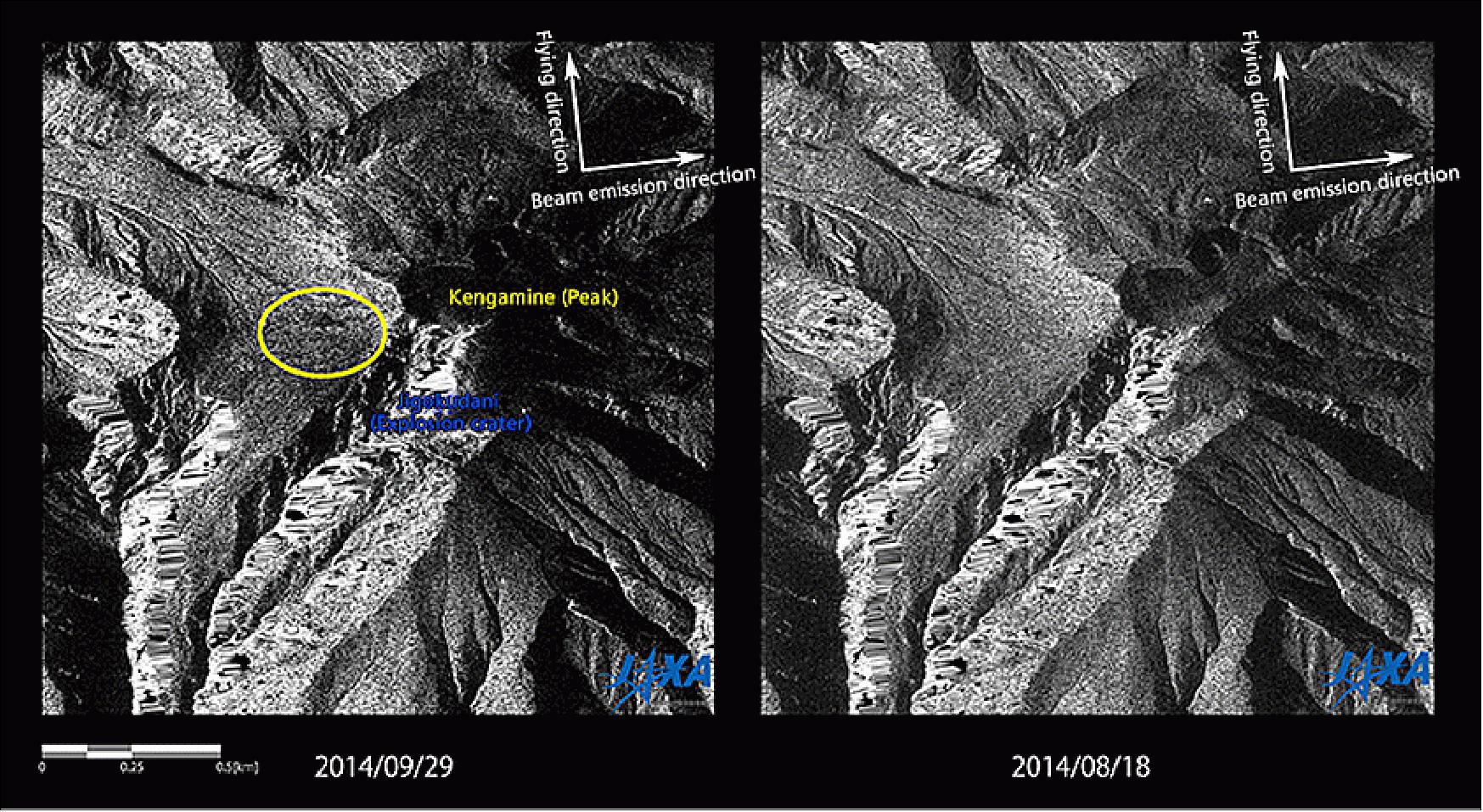
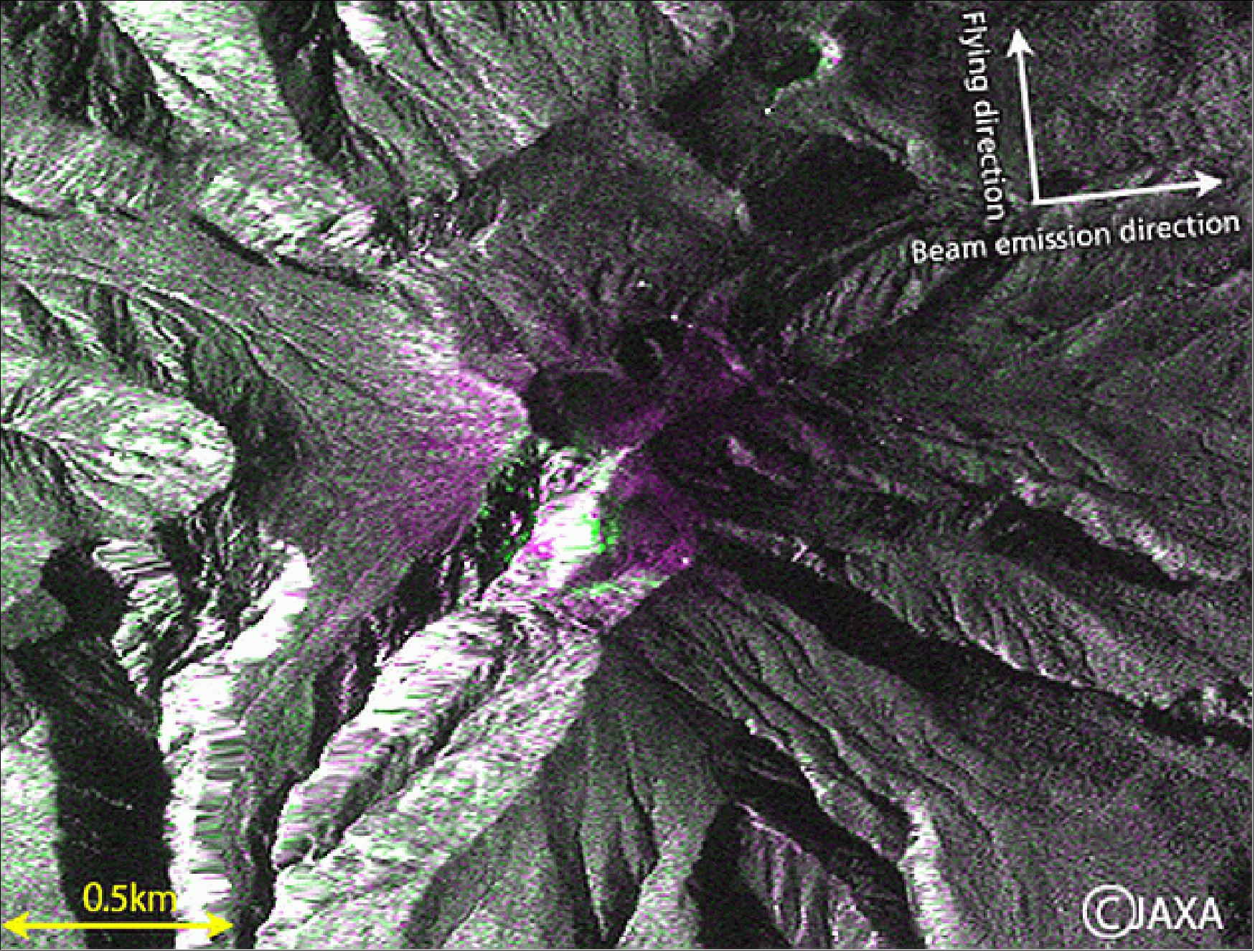
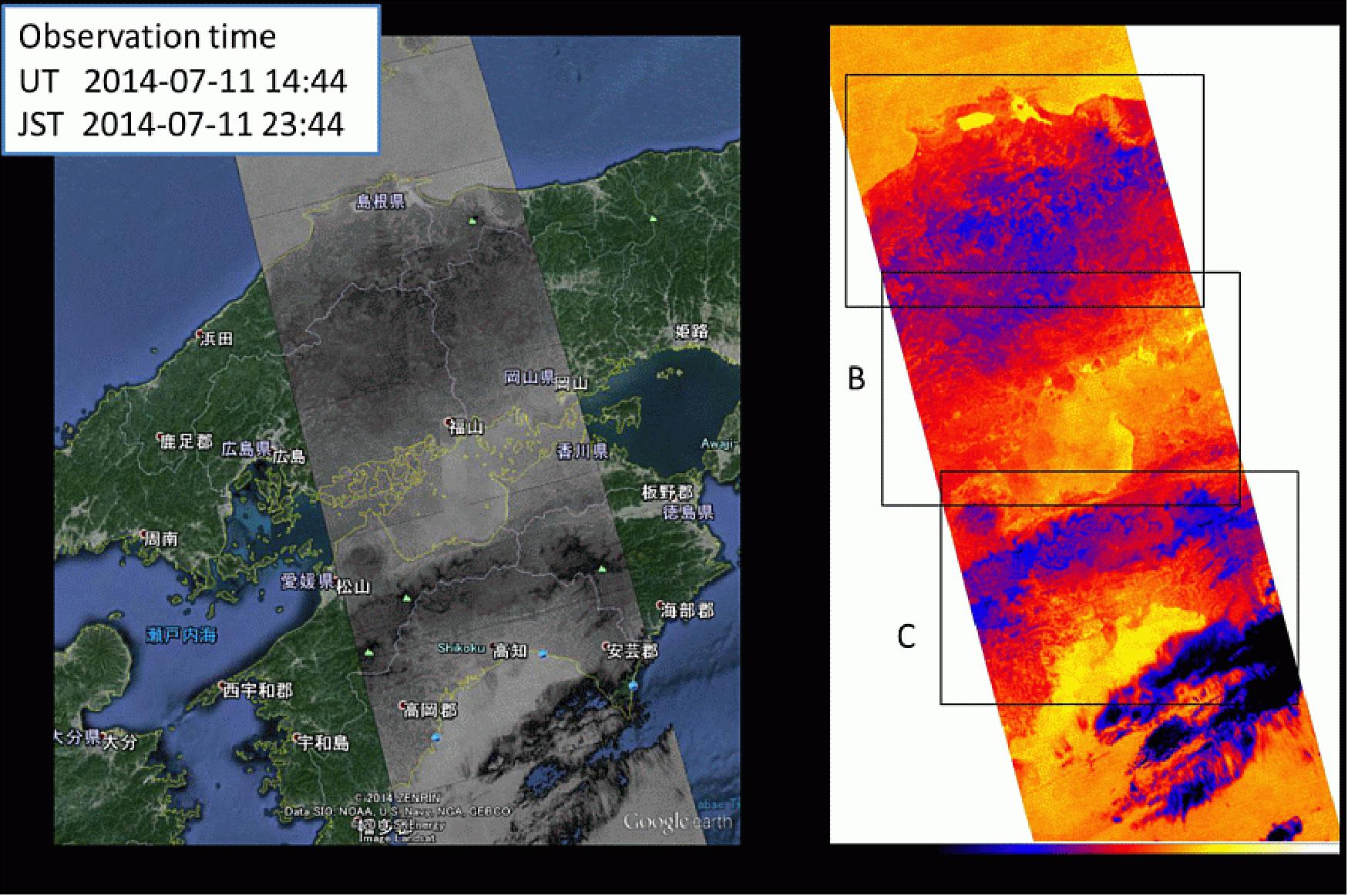
• June 27, 2014: JAXA acquired PALSAR-2 (Phased Array Type L-band Aperture Radar-2) imagery aboard ALOS-2 (Daichi-2) as shown in the figure below. The left image of Figure 46 is of Izuoshima Island on Japan's coast. The right image is a bird’s-eye view image compiled by using altitude data acquired by PRISM aboard ALOS-2. The dark area circled in red shows the scars caused by Typhoon No .26 eight months later.62)
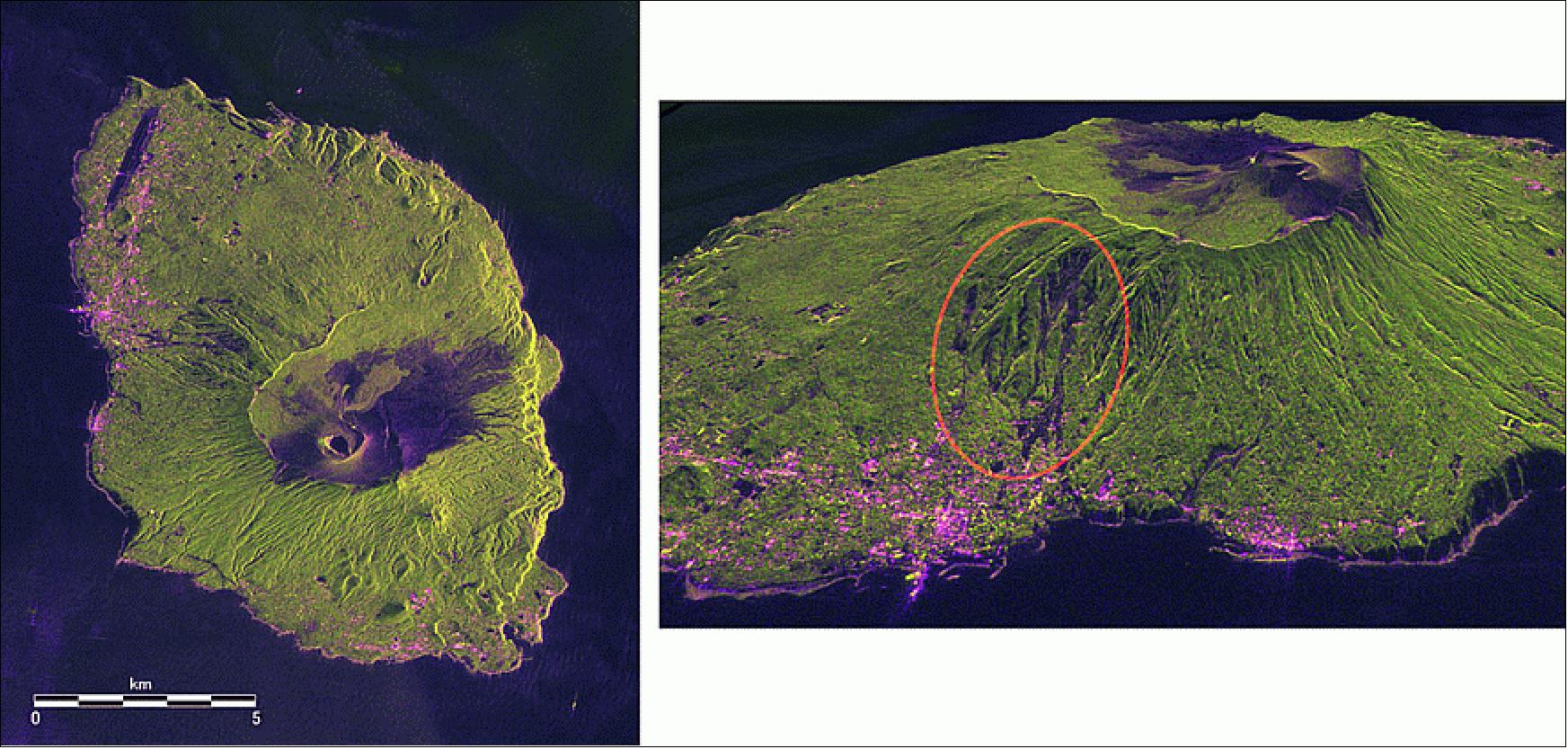
• May 27, 2014: JAXA confirmed via telemetry that the attitude control system of the Advanced Land Observing Satellite (ALOS-2/Daichi-2) shifted to the regular operation mode. With this confirmation, scheduled operations of the critical phase such as the deployment of antennas for direct communications and mission instruments were all achieved. Thus the critical operations phase 1 of Daichi was completed. 63)
• May 26, 2014: JAXA confirmed that the Advanced Land Observing Satellite (ALOS-2/Daichi-2)'s L-band synthetic aperture radar (PALSAR-2) antenna was successfully deployed (the second wing deployment). The satellite was now in stable condition. 64) 65) 66)
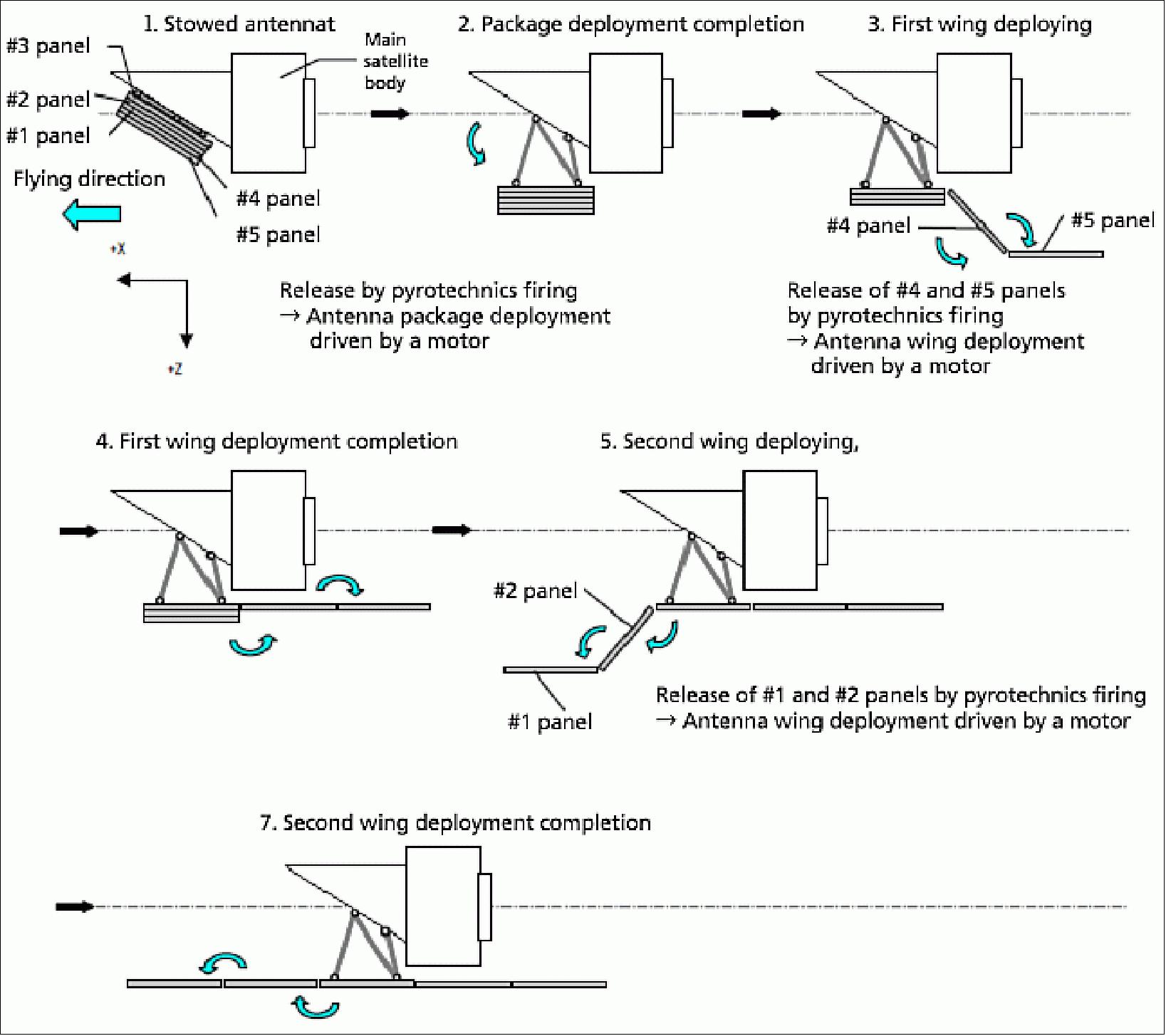
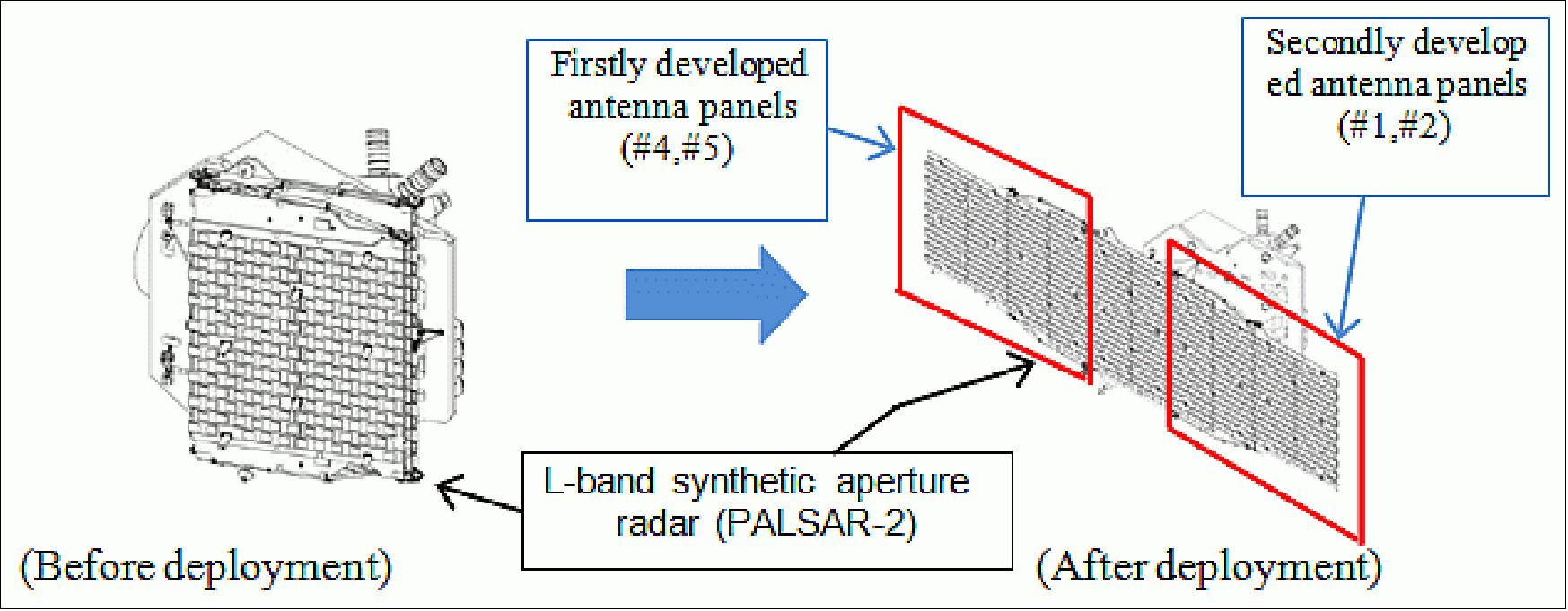
Sensor Complement
PALSAR-2 (Phased Array L-band Synthetic Aperture Radar-2)
PALSAR-2 is an L-band SAR instrument based on APAA (Active Phased Array Antenna) technology. The APAA of ALOS-2 allows not only conventional stripmap and ScanSAR, but also Spotlight mode observations with electronic beam steering in the range and azimuth directions. To cover wide area observations, PALSAR-2 offers the capability of wide incidence angle (8º - 70º) electronic beam steering as well as a means for left-side or right-side looking observations from the satellite ground track; the required spacecraft maneuver for this observation change can be accomplished in about 2 minutes from the nominal nadir look direction. 67) 68) 69) 70) 71) 72) 73) 74)
System design: The PALSAR-2 system is composed of two subsystems: the Antenna subsystem (ANT) and the Electric Unit (ELU).
ELU: The key components of the ELU are Exciter (EX), Transmitter (TX), Receiver (RX), Digital Processor (DP), and System controller (SC).
As for the RF signal, EX generates the pulse, selects two chirp signals (up / down and phase modulation) with selected center frequencies of either 1257.5, 1236.5 or 1278.5 MHz in order to avoid the interference into RNSS (Radio Navigation Satellite Service) using the L-band, and stretches the signal to the selected bandwidth at either 84 MHz, 42 MHz, 28 MHz or 14 MHz. The received radar echo signal is compressed by the BAQ (Block Adaptive Quantization) or the improved BAQ algorithm. The compression mode is selected from 4 bit, 2 bit, and no compression with or without the improved compression mode. Figure 49 shows the system diagram of PALSAR-2.
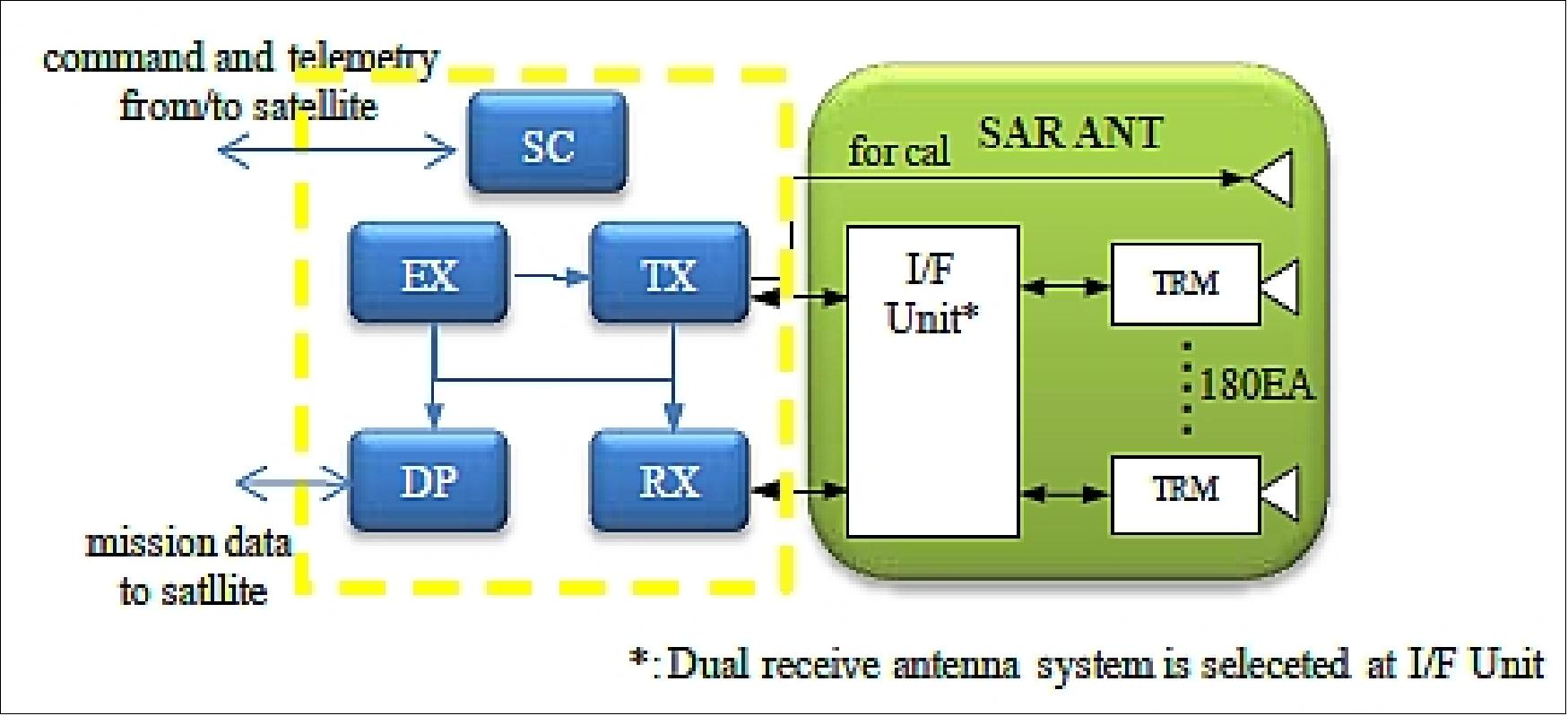
Tables 10 and 11 summarise the specification and the PALSAR-2 system parameters.
Radar carrier center frequency | 1236.5 / 1257.5 / 1278.5 MHz (selectable) |
Band, wavelength | L-band, 22.9 cm |
PRF (Pulse Repetition Frequency) | 1500 to 3000 Hz |
Range of bandwidths | 14 / 28 / 42 / 84 MHz |
Polarisation | Single / dual / full / compact (compact polarisation is an experimental mode) |
Look direction | Right or left |
Beam steering range | Elevation: ±30º; Azimuth: ±3.5º |
Antenna width, length | 2.9 m, 9.9 m |
Incidence angle | 8º to 70º |
Range resolution, azimuth resolution | 3 m / 6 m / 10 m / 100 m, 1 m / 3 m / 6 m / 10 m / 100 m |
Peak power radiation | 3.3 kW with 3/5 aperture in Spotlight and Ultra-fine mode |
Mass of the SAR antenna | 547.7 kg |
Mass of the SAR ELU (Electric Unit) | 109.1 kg (ELU controls all SAR signal generations and beam management) |
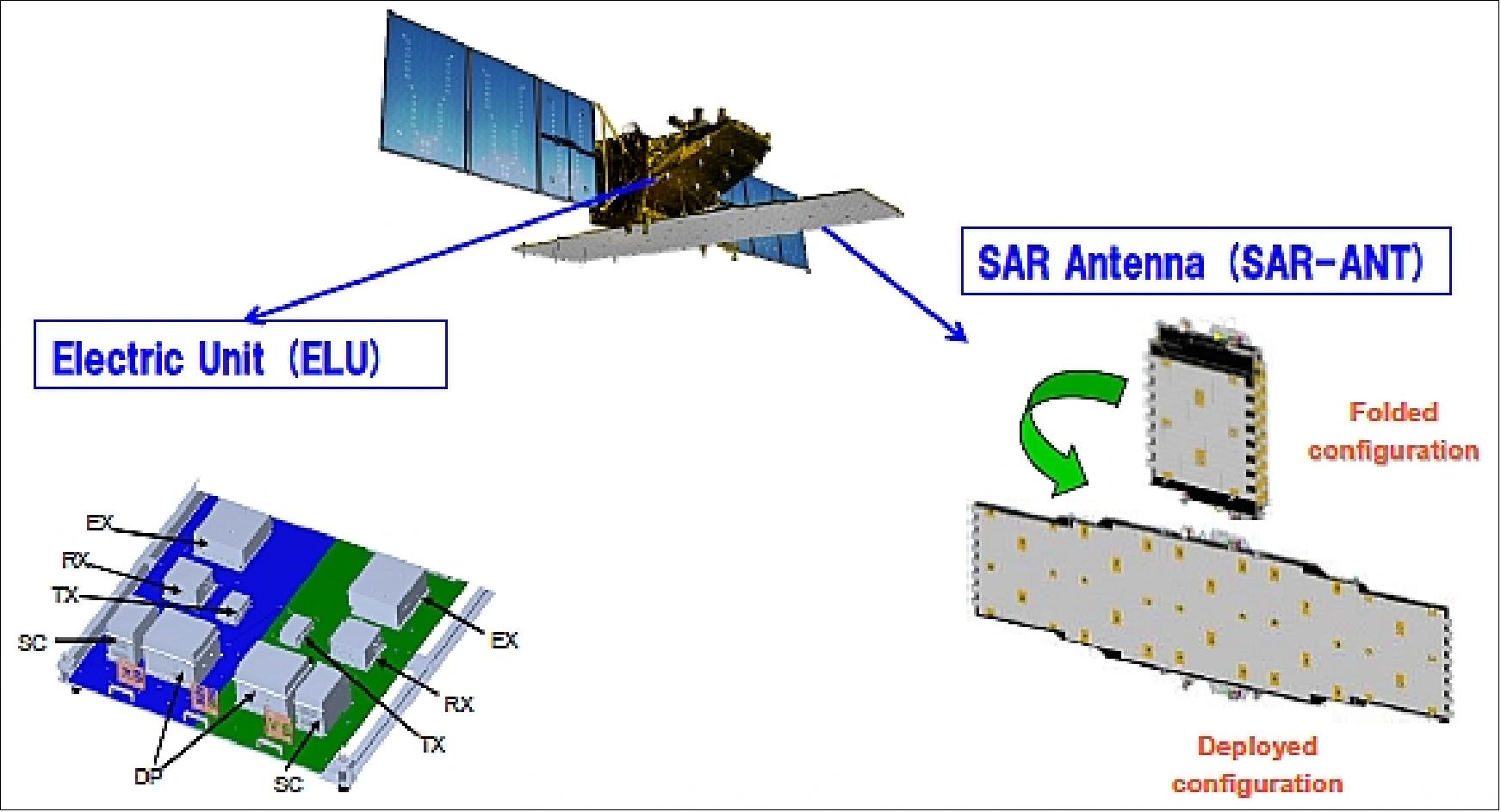
Parameter \ Mode | Spotlight | Stripmap | ScanSAR | ||
Ultra-fine | High-sensitive | Fine | |||
Frequency | 1257.5 MHz | 1257.5 MHz or 1236.5 / 1278.5 MHz, selectable | |||
Incidence angle | 8º to 70º range | ||||
Bandwidth | 84 MHz | 84 MHz | 42 MHz | 28 MHz | 14 MHz |
Ground resolution | 3 m (rg) x 1 m (az) | 3 m | 6 m | 10 m | 100 m |
Swath | 25 km (rg) x 25 km (az) | 50 km | 50 km | 70 km | 350 km |
Polarisation | SP | SP/DP | SP/DP/FP/CP | SP/DP/FP/CP | SP/DP |
Data rate | 800 Mbit/s | 800 Mbit/s | 800 Mbit/s | 400 Mbit/s | 400 Mbit/s |
NESZ | -24 dB | -24 dB | -28 dB | -26 dB | -26 dB |
S/A: range | 25 dB | 25 dB | 23 dB | 25 dB | 25 dB |
S/A: azimuth | 20 dB | 25 dB | 20 dB | 23 dB | 20 dB |
Legend to Table 11: Performance values @ incidence angle of 37º; CP: Compact Polarimetry (Linear+circular), FP: Full Polarimetry (HH+HV+VV+VH).
The specification of Table 11 is defined for an incidence angle of 37º above the equator. The polarisation acronyms are as follows:
- SP: Single Polarisation
- DP: Dual Polarisation
- FP: Full Polarisation (quad)
- CP: Compact Polarisation (experimental mode).
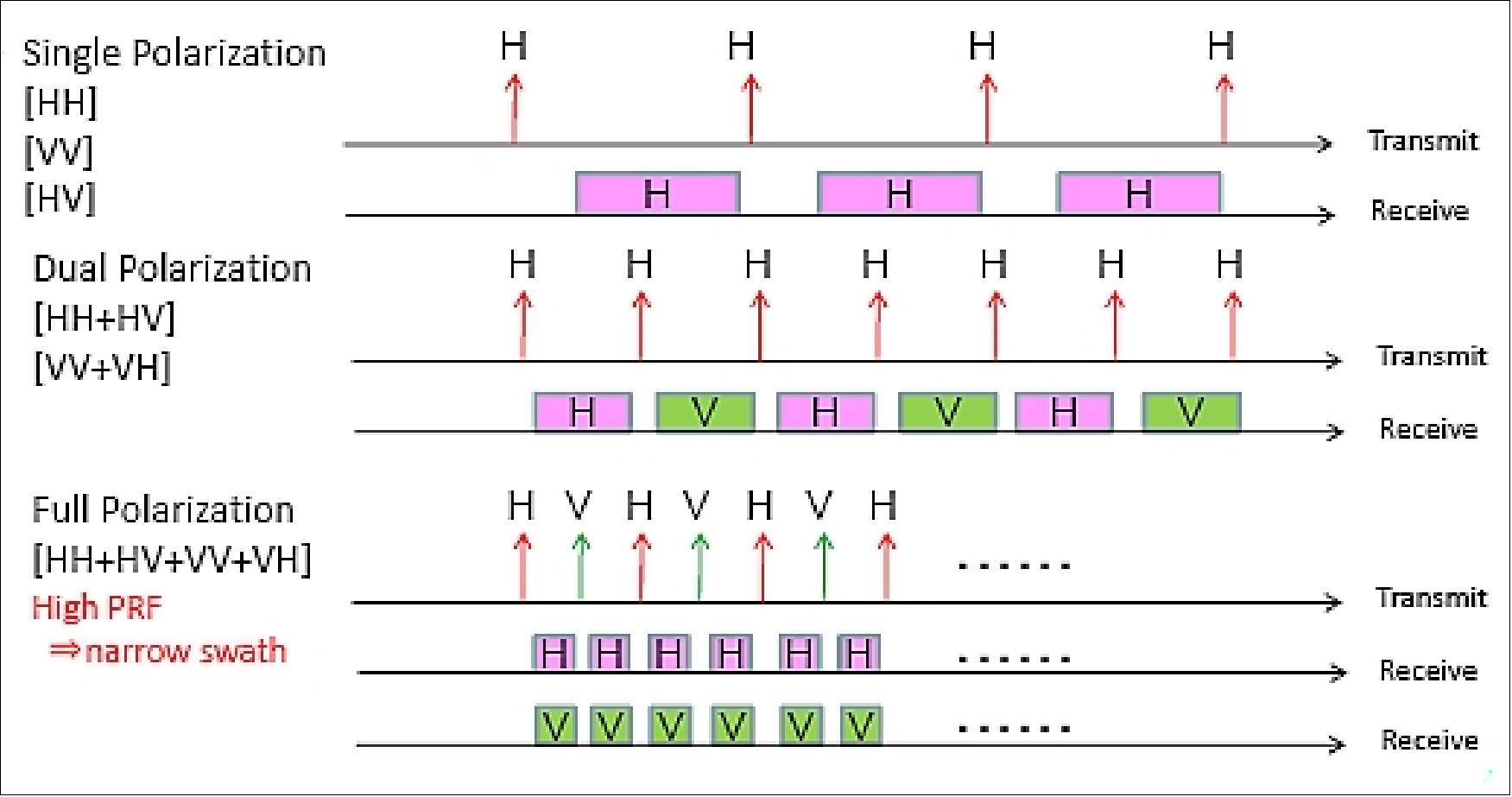
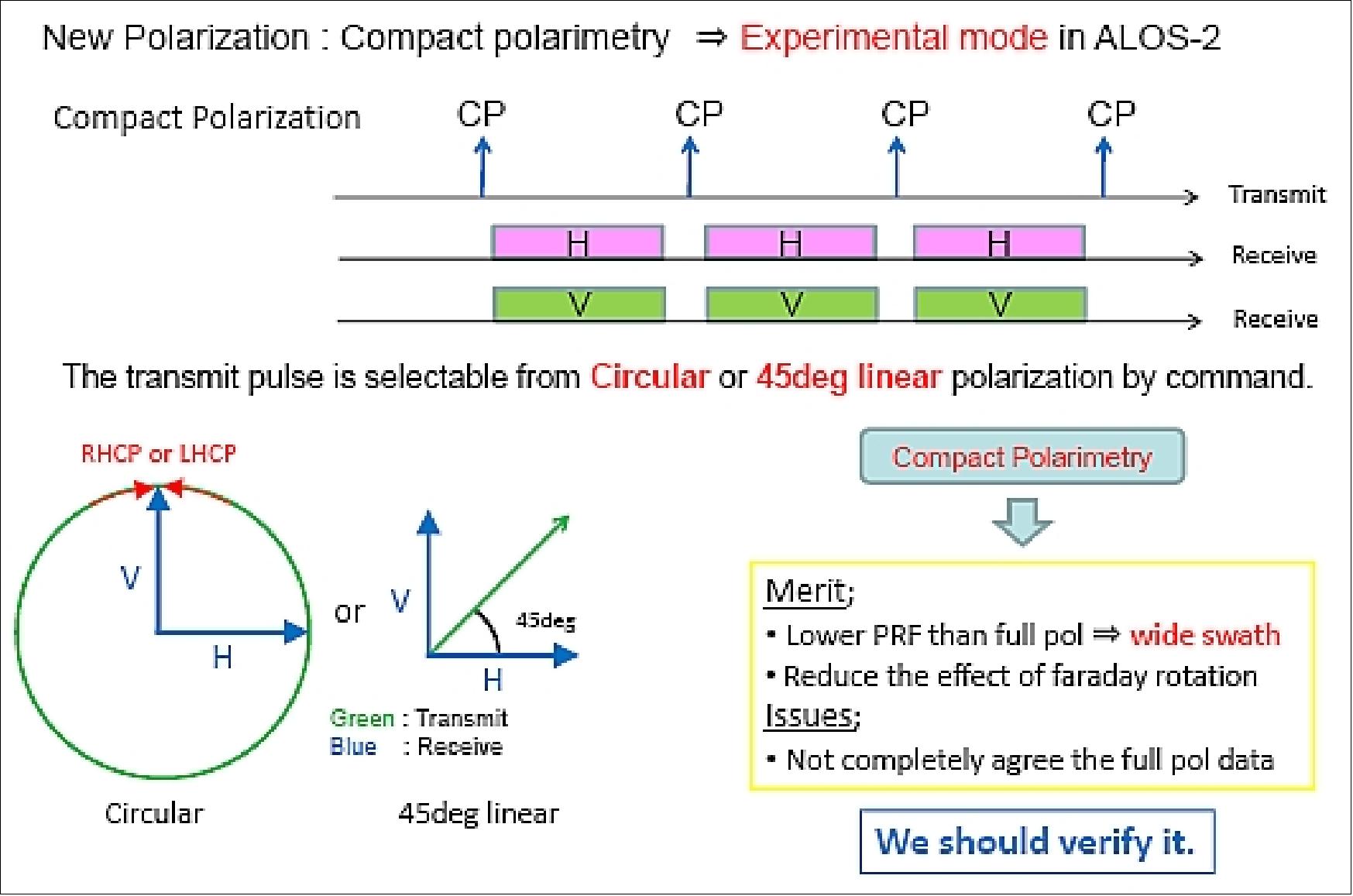
The enhanced instrument performance of ALOS-2, enabled through the right-and-left looking observation capability, will greatly expand the FOR (Field of Regard) of the satellite, up to about 3 times (from 870 km on Daichi to 2,320 km), for event monitoring services.
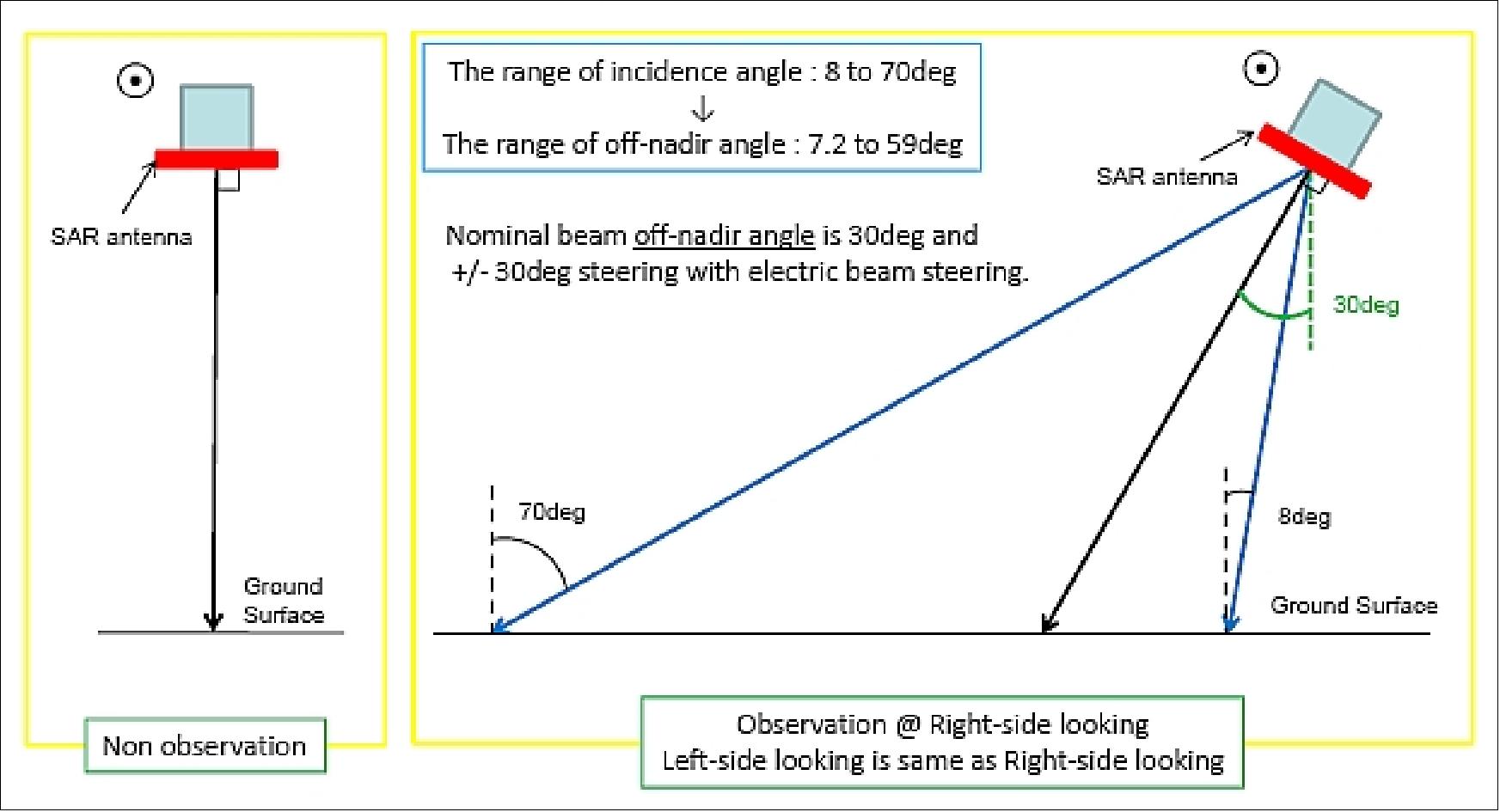
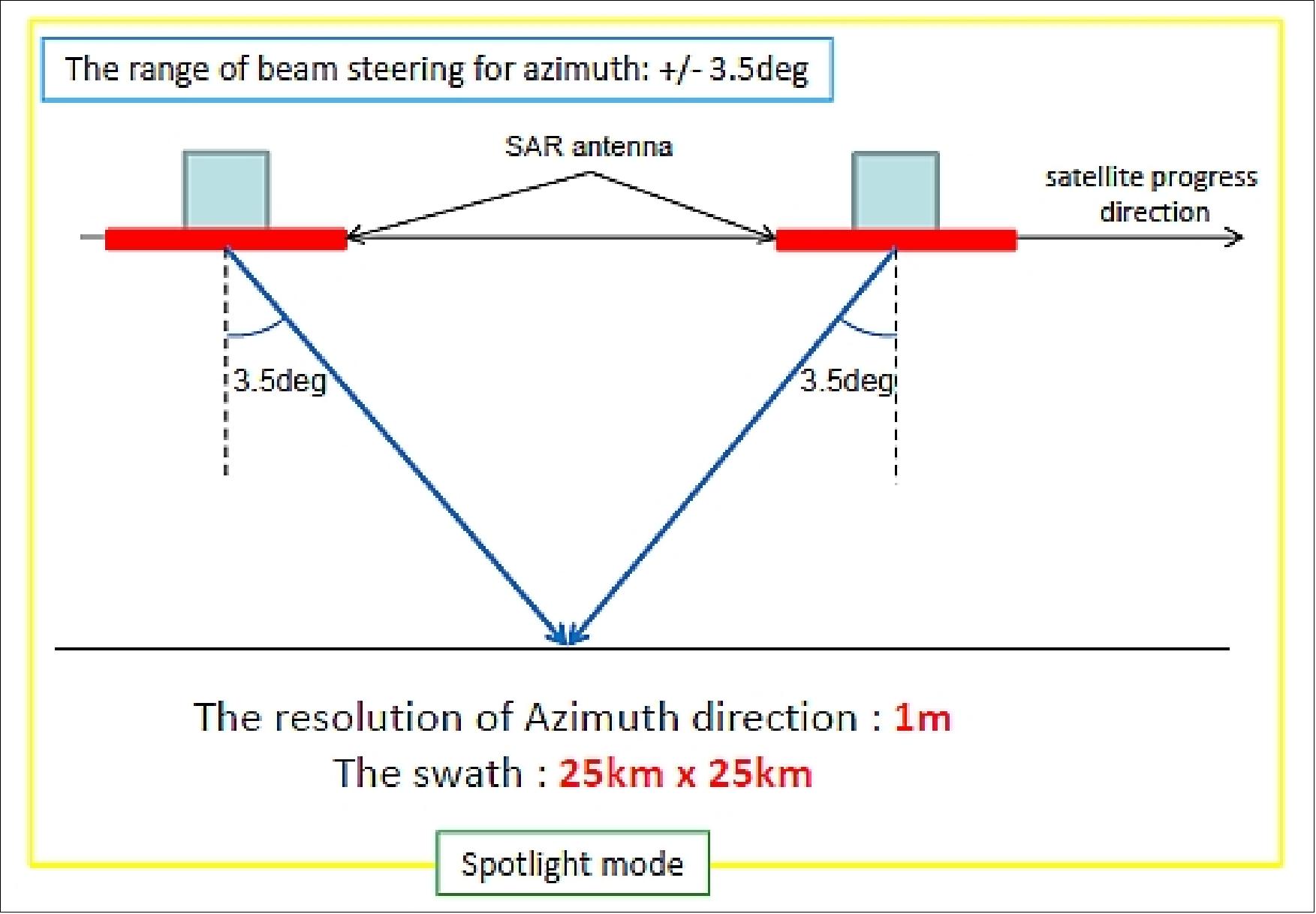

L-band SAR antenna (ANT): ANT is an active phased array antenna which steers the beam in both elevation and azimuth direction (±30º in elevation and ±3.5º in azimuth). It has a size of 9.9 m (azimuth) x 2.9 m (elevation) and is composed of 5 electrical panels. The antenna consists of 1,080 radiation elements which are driven by 180 TRMs (Transmit and Receive Modules). The design enables to steer and form the beam in elevation and azimuth direction for several imaging modes: Stripmap, Spotlight and ScanSAR. The antenna nominal pointing is in the nadir direction and it is pointing 30º sideways when observing (either to the left side or to the right side of the ground track). 75)
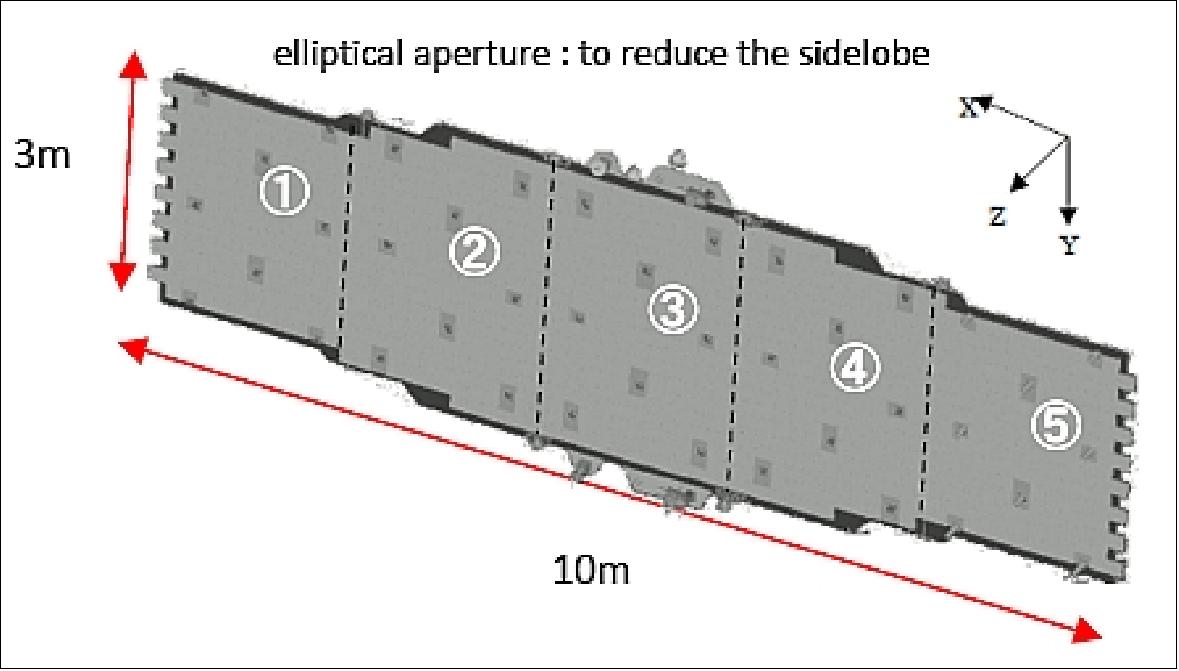
The SAR antenna is a DRC (Dual Receive Channel) system (Figure 57):
- The full aperture (5 panels) or partial aperture ( 3 of 5 panels, No 2, 3 and 4) of the antenna aperture may be used for signal transmission (Tx). The peak radiation power is 3,300 W with three panels for Spotlight mode and Ultra-Fine mode, or 5,100 W with full aperture for High sensitive mode, Fine mode and ScanSAR mode.
- In receive, the antenna is divided into two separate partitions in along-track. The signals of both receiving antenna partitions are being detected and recorded separately; this concept permits wide-swath acquisitions.
Wide swath coverage for polarimetric observation: ALOS-2 SAR utilises a type of polarimetry as single, dual and quad (full-pol.) as a standard mode, and compact (or hybrid) as an experimental mode. Full-pol. mode on ALOS-2 is a system which realises transmitted polarisation by replacing horizontal / vertical by turns with an interval of PRI (Pulse Repetition Interval). Therefore, when selecting full-pol. mode, the PRF of full-pol. is doubled as that of single/dual-pol., which means that the available swath in full-pol. is drastically restricted. In the case of conventional mode (“fine mode”: resolution of 10 m), the range coverage of full-pol. becomes 30 km, which is less than a half of single/dual-pol. (70 km).
The wider coverage of full-pol. is also achieved by using the DRC method. Since the full-pol. mode requires two receive channels for H and V polarisation synchronously, utilisation of the DRC mode for full-pol. requires double channels compared with the conventional full-pol. Mode, namely quad- receive channel. For the purpose of wide coverage and observation capability in higher incidence angles for full-pol. mode, ALOS-2 can execute the DRC and full-pol. observation simultaneously, in “high sensitive mode” (HS mode). The swath of the full-pol. mode in HS mode is 40-50 km with a resolution of down to 6 m in an off-nadir angle of 18-35º.
Another approach for wider coverage of polarimetric observation is a new technique of “compact (or hybrid) polarimetry”. Since one T/R module of ALOS-2 has two identical amplifiers for H and V polarimetry, RF signals of H/V polarisation with an optimum phase offset is generated from each antenna element, and resultantly circular or oriented at 45º is transmitted. Although polarimetric information of compact pol. is not enough compared to that of full-pol., the swath of compact polarimetry is wider than that of full-pol., and is the same as that of single/dual polarimetry mode.
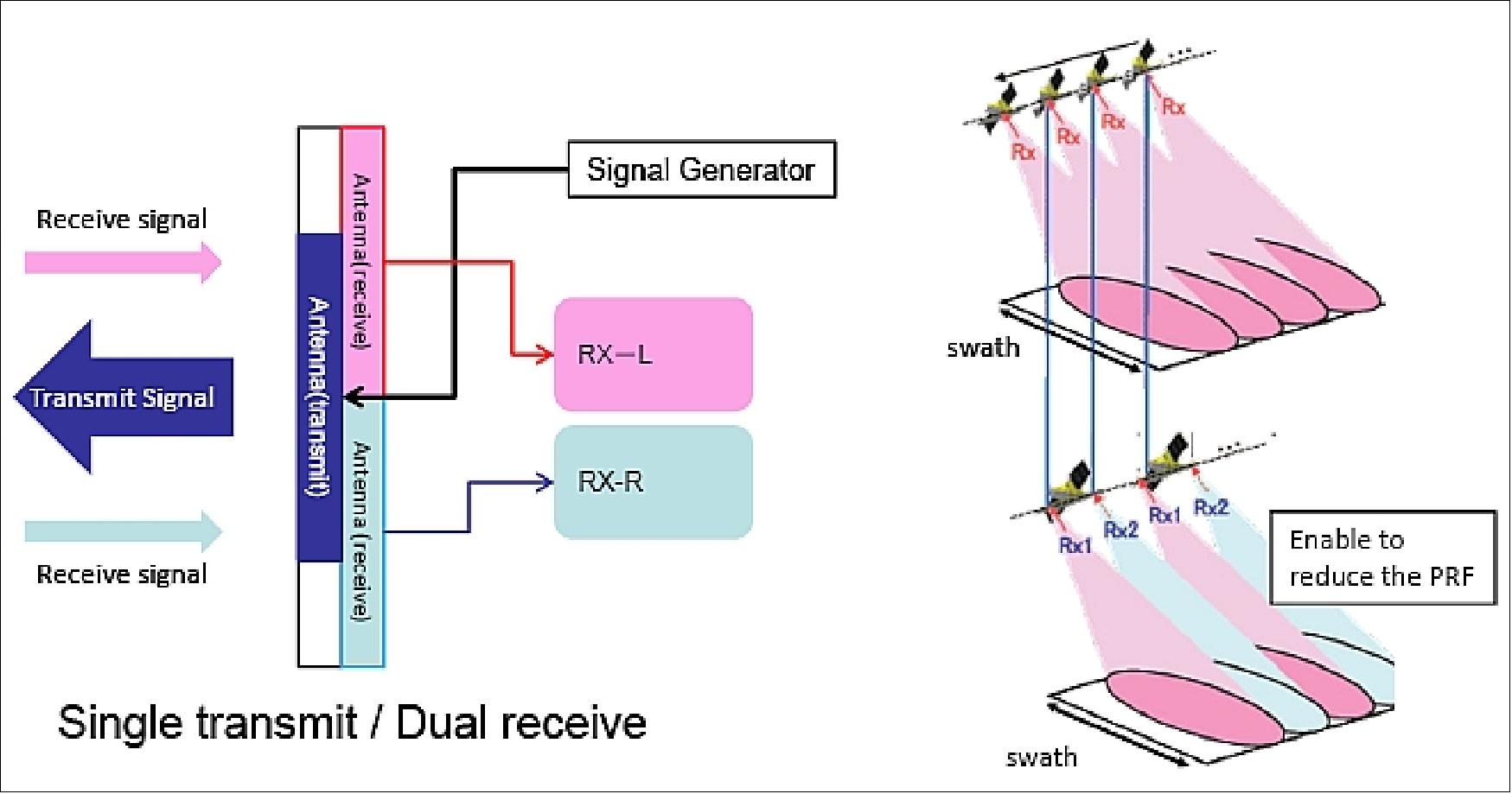
TRMs (Transmit Receive Modules):
The TRMs enable to select the polarisation of single (HH/VV/HV), dual (HH + HV=VV + VH), quad (HH + HV + VV + VH), and compact polarimetry (Tx: oriented 45º or circular, Rx: H or V) by transmitting H and V polarisation simultaneously. In L-band, the propagation disturbances and especially the ionospheric effects like Faraday rotation and phase delay have to be considered and if possible to be corrected. The quad polarimetry mode uses the alternative pulses of H and V which increase the PRF and result in a narrow swath.
The SAR instrument features a CP (Compact Polarimetry) mode as an experimental mode which can transmit the H and V polarisation simultaneously resulting in a linear polarisation oriented at 45º or circular (LHCP or RHCP), selectable by command.
Compared to the TRMs used in PALSAR, establishing higher power amplification in the TRMs of PALSAR-2 through a wider operational frequency range is necessary, as summarised in Table 12. An output power of 34 W is generated at the PALSAR-2 TRM output port with a low-loss and high-power solid state power amplifier using a GaN (Gallium Nitride) HEMT (High Electron Mobility Transistor). - The performance of a HPA (High-Power Amplifier) using GaN HEMT is tested by a breadboard model and confirmed to meet the requirement. Figure 58 shows the outside view of the HPA and the inside view of the BBM (Breadboard Model).
Item or parameter | ALOS / PALSAR | ALOS-2 / PALSAR-2 |
HPA (High Power Amplifier) | Si BJT (Bipolar Junction Transistor) | GaN HEMT |
Tx power | 25 W | 34 W |
Operational frequency range | 28 MHz | 85 MHz |
Number of TRMs | 80 | 180 |
Efficiency | 25% | 35% |
Noise figure | 2.9 dB | 2.9 dB |
TRM size | 203 mm x 117 mm x 23.5 mm | 200 mm x 110 mm x 14.6 mm |
TRM mass | 675 g | 400 g |

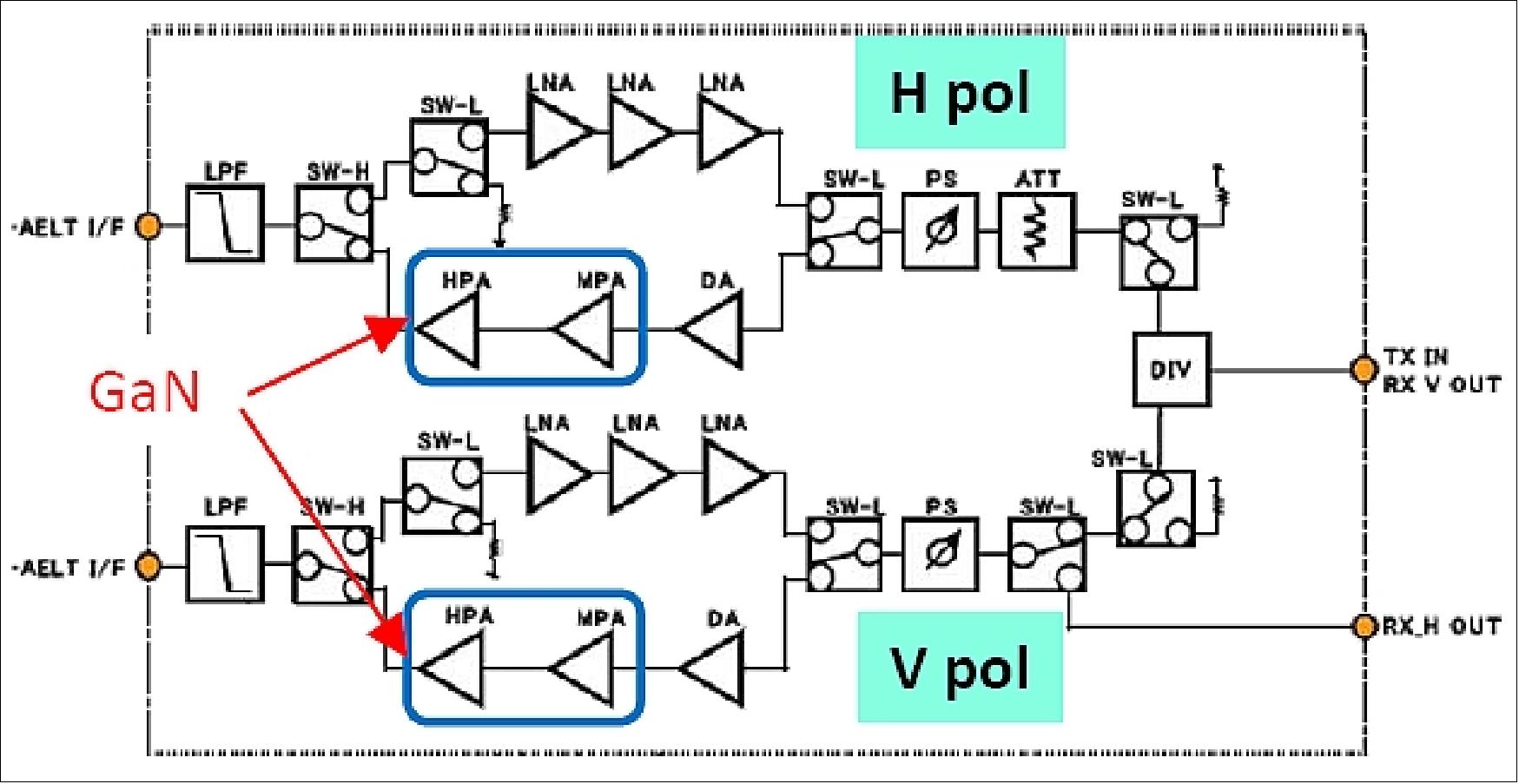
The image quality with chirp modulation: To distinguish each pulse, PALSAR-2 implements the chirp modulation.
- Up/down and phase modulation in each pulse
- PALSAR is only Down chirp.

Chirp signal management: In order to reduce range ambiguities, the ALOS-2 PALSAR-2 system has an ability to send up/down chirp signals alternatively.
Data compression algorithm: The maximum data rate (800 Mbit/s) of PALSAR-2 is much higher than that of PALSAR (240 Mbit/s max) due to the improved performances of the SAR instrument providing higher resolution data and a wide swath. To realise the frequent observations and data acquisitions, it is necessary to develop a new data compression technique on board with a highly efficient and a low error rate.
The data compression technique for PALSAR-2 is BAQ (Block Adaptive Quantization) or an improved BAQ version, namely DS-BAQ (Down-Sampling BAQ selectable. The BAQ technique, used for other SAR satellite like TerraSAR-X and COSMO-SkyMed, is the conventional technique. DS-BAQ is the new data compression technique. At conventional radar system, the A/D sampling frequency is wider than the transmitting bandwidth to decrease the ambiguity level. In DS-BAQ, the differential bandwidth between transmitting bandwidth and A/D sampling frequency is cut before BAQ processing (Ref. 67).
Figures 60 and 61 show the simulation results amplitude and phase error analysis, respectively. According to these Figures, DS-BAQ is able to decrease the error more than the BAQ technique in same compression ratio.
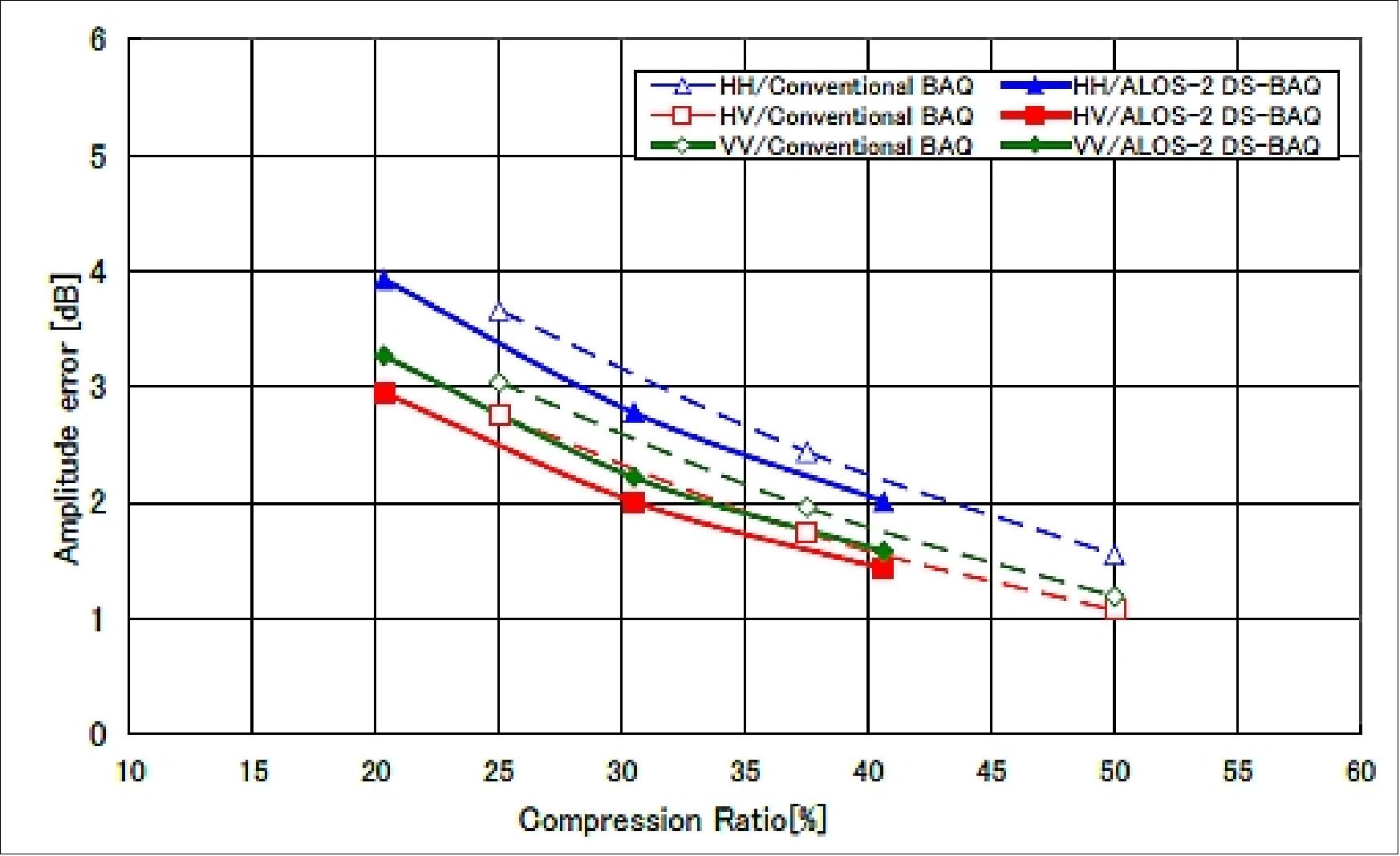
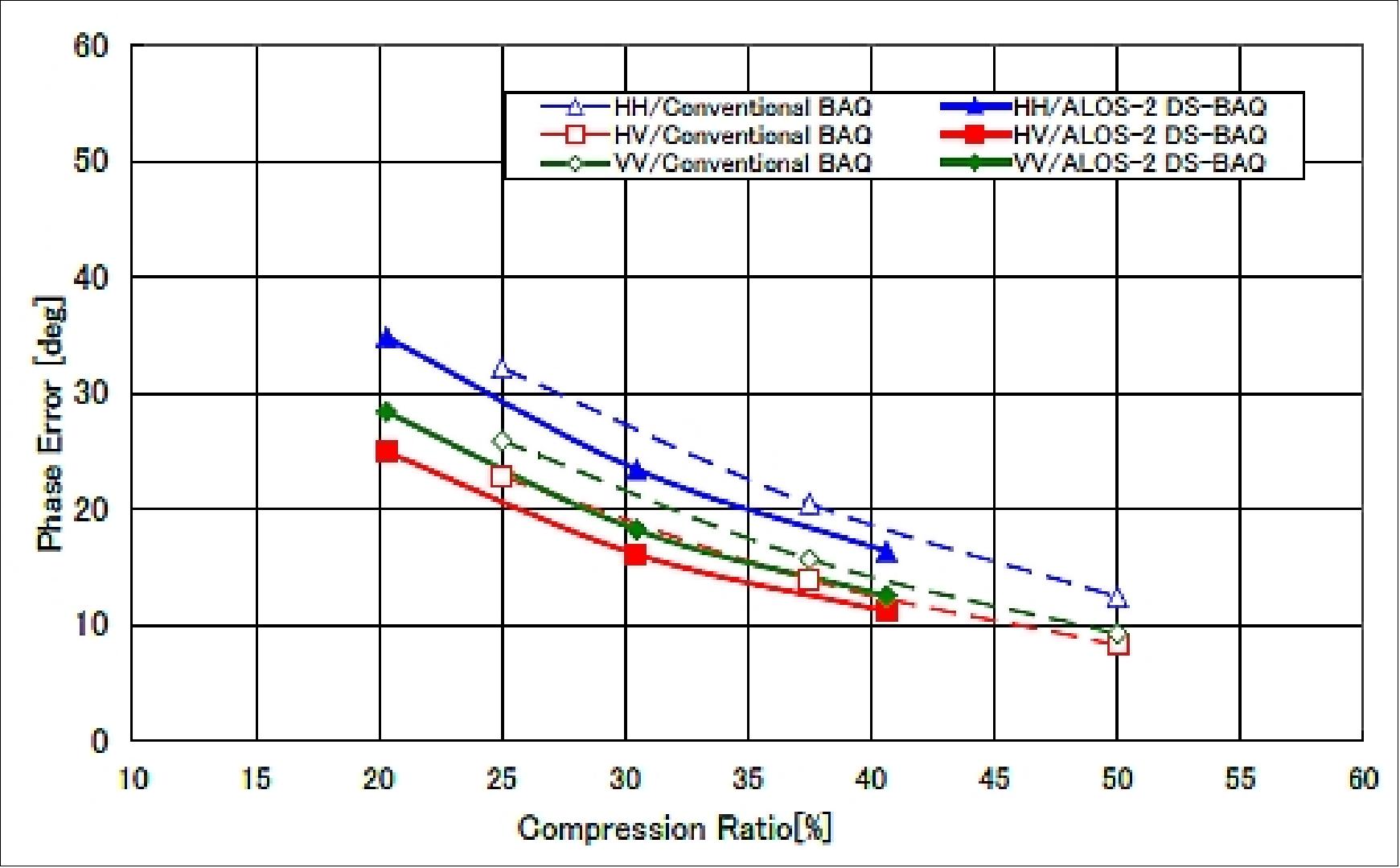
The error analysis result based on a simulation comparing the two compression algorithms under several polarisation modes shows that, in the same data compression ratio, down-sampling BAQ satisfies the lower errors of both amplitude and phase better than BAQ. The compression ratio was evaluated on the BBM (Breadboard Model) of the data compression module, confirming also its processing speed.
The implementation of the data compression algorithm is such that a compression mode is onboard selectable between the DS-BAQ, the original BAQ, and direct output without data compression.

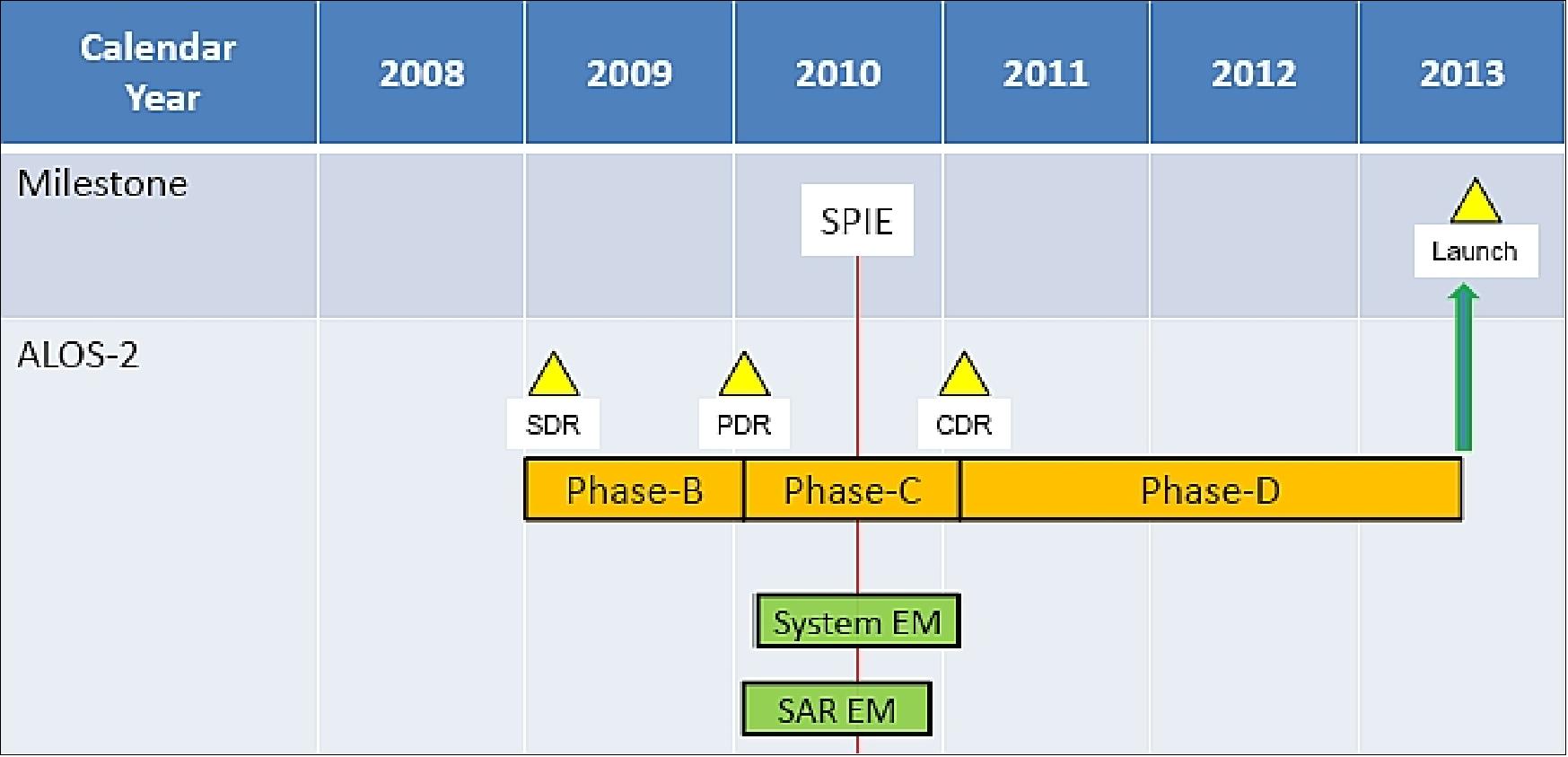
CIRC (Compact Infrared Camera)
CIRC is an infrared demonstration instrument of JAXA with state-of-the-art COTS (Commercial-off-the-Shelf) technology developed at MELCO (Mitsubishi Electric Corporation). The camera is equipped with an uncooled infrared array detector (microbolometer). The main objective of CIRC is to provide infrared imagery for wildfire detection. CIRC is mounted onto the spacecraft pointing to the right of the flight path at an off-nadir angle of 30º (Figure 65). CIRC is a small size instrument with a mass of ~ 3 kg. 76) 77) 78) 79)
Wildfires are one of the major and chronic disasters affecting many countries in the Asia-Pacific region, and indications are that this will get worse with global warming and climate change. Wildfire detection is one of the main goals in the Sentinel Asia project and to share this information in near real-time across the Asia-Pacific region.
The goal is to realise frequent observations by loading CIRC devices in as many satellites as possible by taking advantage of there small size, low weight, and low power consumption. Other mission targets of the CIRC are volcanoes or heat island phenomena in a city.
JAXA developed two CIRC instruments, one will be launched aboard the ALOS-2 spacecraft; the second one will be launched in 2015 onboard CALET (CALorimetric Electron Telescope), which was installed in the JEM -EF (Japanese Experiment Module) on the ISS (International Space Station) in April 2015.
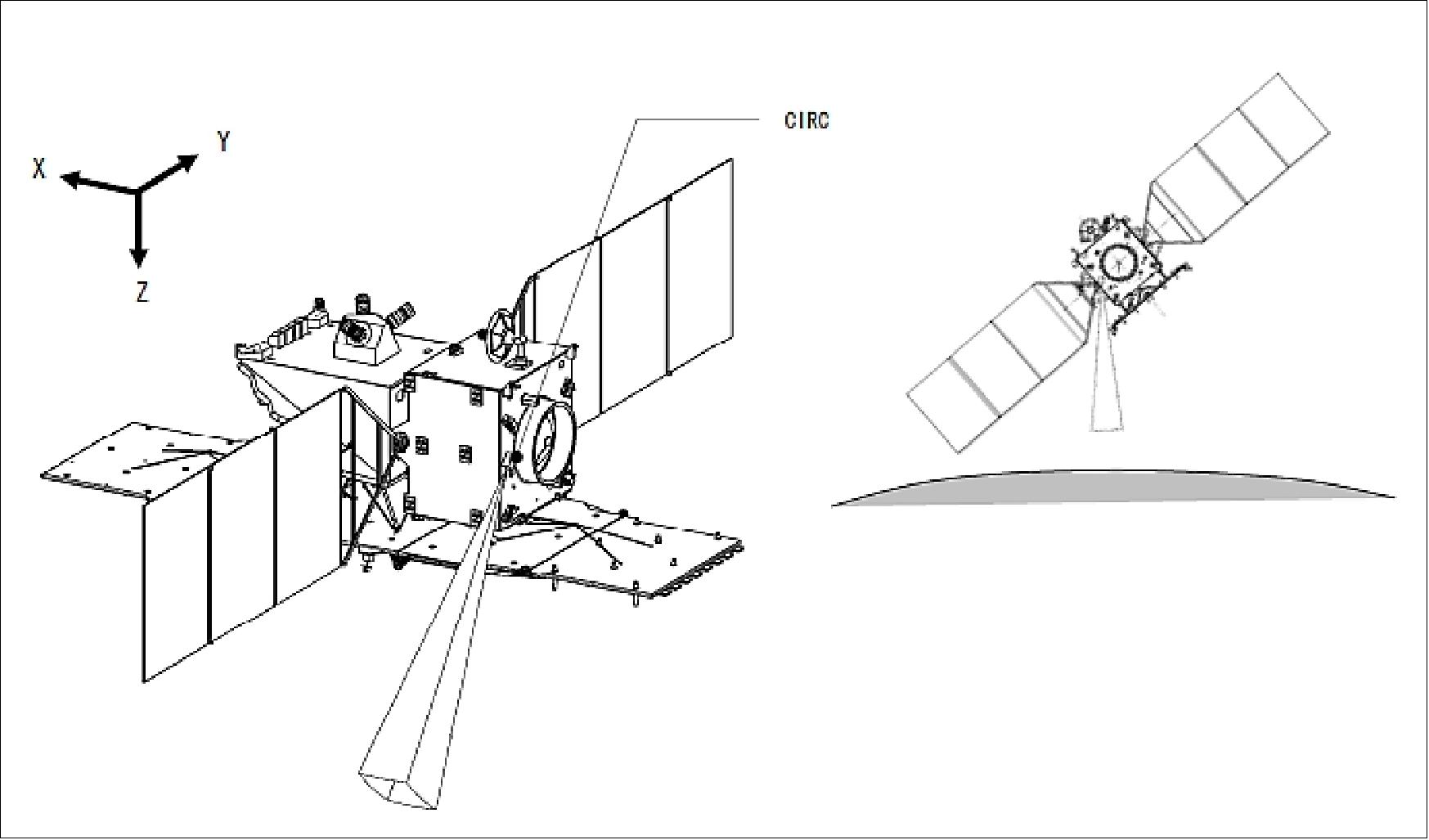
The baseline specifications of the CIRC instrument are listed in Table 13. The detector has a large format (640 x 480 pixels) to capture a wide field of view. Spatial resolution is an important factor for wildfire detection; it is 200 m from an altitude of 600 km (ALOS-2) and 130 m from an altitude of 400 km (CALET). Eliminating the cooling system reduces the size (110 mm x 180 mm x 230 mm) and the consumption power (<20 W) for CIRC.
Instrument mass, size | 3 kg, 180 mm x 110 mm x 230 mm |
Spectral range | 8-12 µm |
Spatial resolution | < 200 m @ 600 km altitude (corresponding to < 0.33 mrad) |
Detector, Number of pixels | Uncooled infrared detector, 640 x 480 |
FOV (Field of View) | 12º x 9º (128 km x 96 km) |
Exposure time | 33 ms |
Dynamic range | 180 K - 400 K |
NEDT (Noise Equivalent Differential Temperature) | 0.2 K@300 K |
Temeprature accuuracy | <4 k (goal 2 K @ 300 K) |
Microbolometer: The project adopted microbolometers as an infrared FPA (Focal Plane Array) of the CIRC device. Microbolometers are based on the principle of detecting infrared energy as minute changes of the IR absorber temperature when infrared radiation id detected. Their advantage is that they do not require a cooling system, such as a mechanical cooler. Sensors without a detector cooling system can be made to have a small size, low mass and low power consumption.
CIRC features a SOI (Silicon-on-Insulator) diode uncooled IR FPA developed by MELCO. Its pixel size is 25 µm square. The SOI diode uncooled IR FPA uses a single-crystal silicon pn-junction diode as a temperature sensor. The single-crystal sensor based on silicon LSI (Large-Scale Integration) technology gives it a low-noise characteristic. The NEDT (Noise Equivalent Differential Temperature) is 40 mK with f/1 optics. The drive and readout circuits are almost the same as those of the commercial IR camera. For the space application, the project performed a radiation damage test, and a screening of commercial devices.
Athermal optics: CIRC employs f/1.2 refractive optics with a focal length of 78 mm. The orbital temperature change of the optics will cause a defocus because the refractive indices of the lens materials are highly dependent on temperature. To compensate for this defocus, the project may employ a focus mechanism or a heater to keep the optics’ temperature constant. However, such mechanisms increase the instrument resources. An athermal optics can compensate for the defocus due to the temperature change without such mechanisms. CIRC can operate in a temperature range from -15º to 50ºC while maintaining its performance. Figure shows the optical design of CIRC. The athermal optics of the CIRC compensates for the defocus by a combination of different lens materials and diffractive lenses. The CIRC optics uses a germanium and a chalcogenide glass (GASIR). The MTF and athermal characteristics of the CIRC device have been verified in laboratory tests.
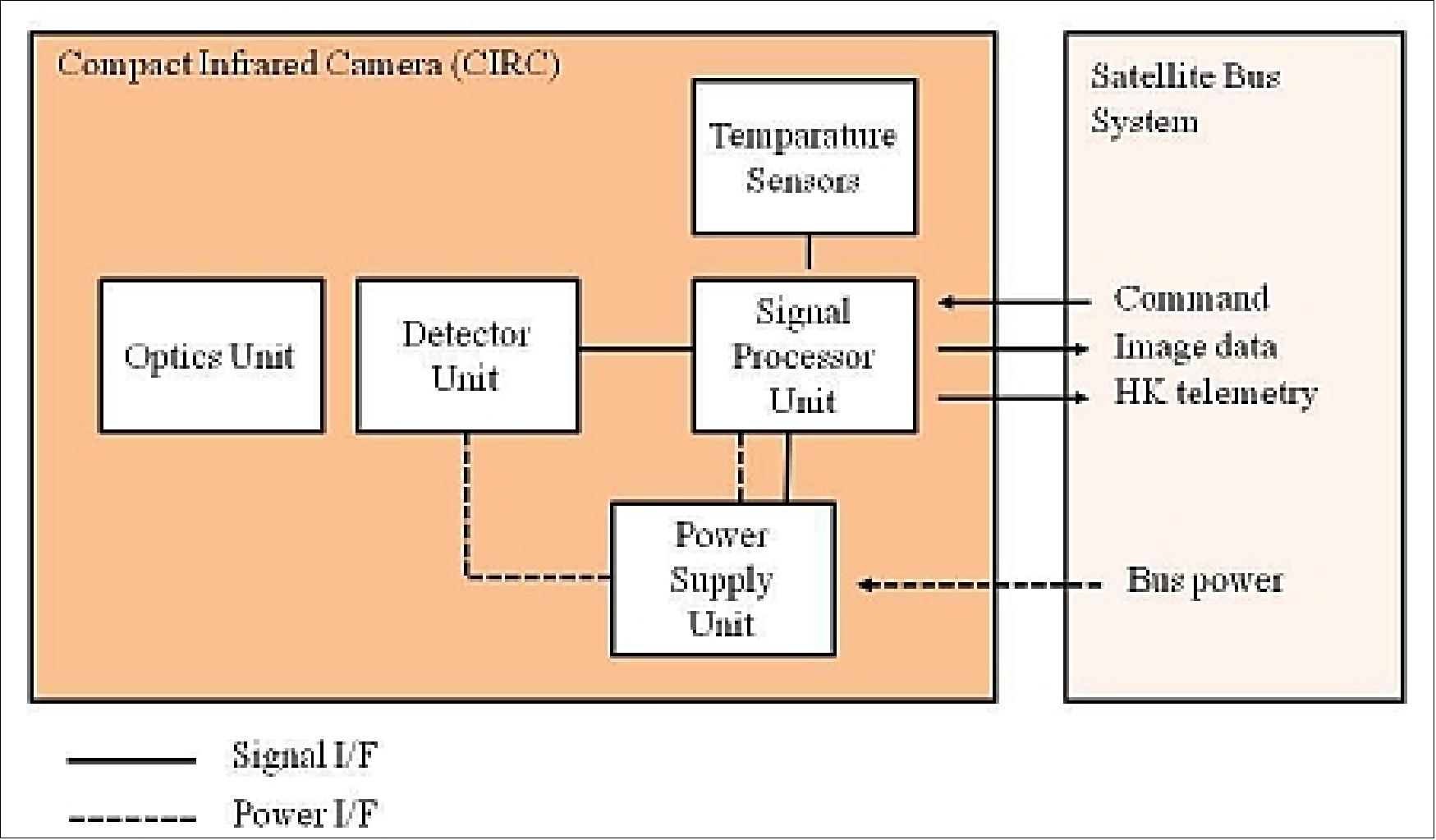
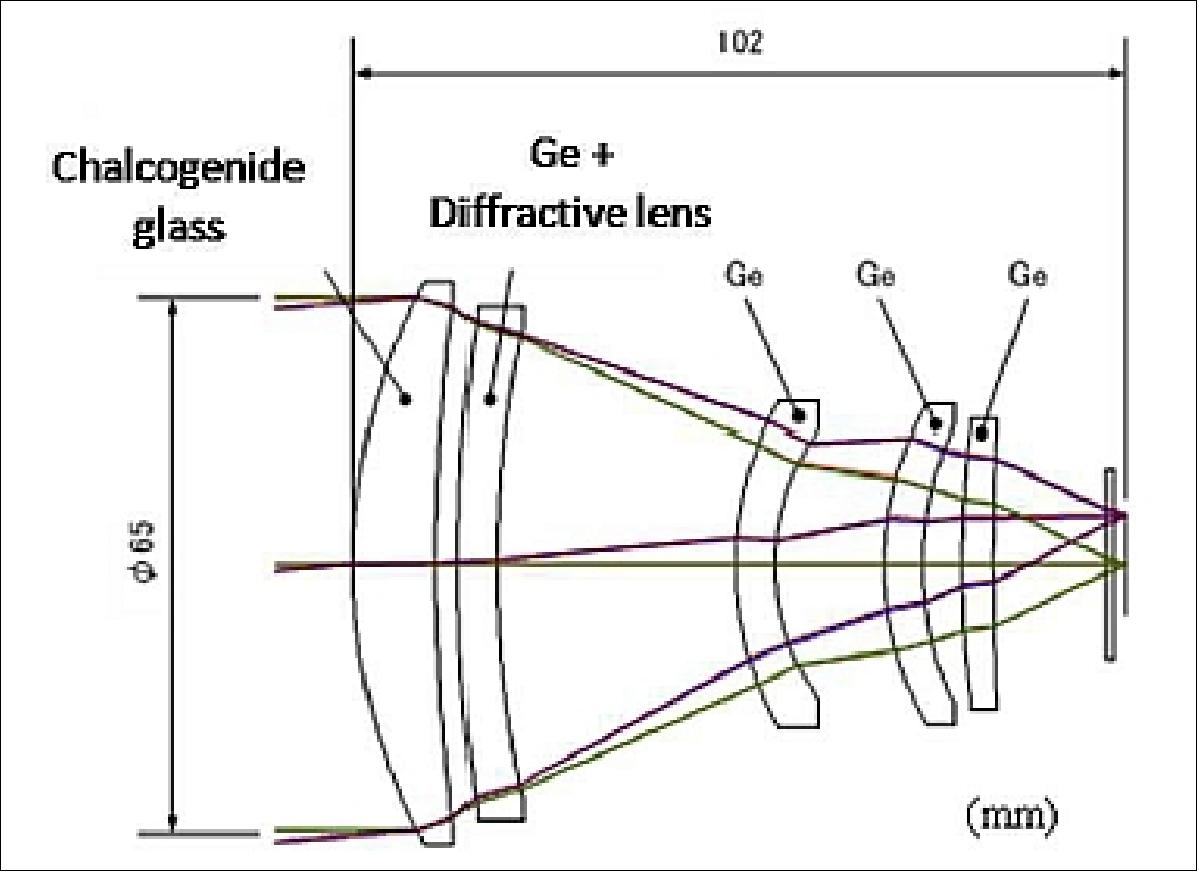
Shutterless system: The project eliminated the mechanical shutter from the CIRC for downsizing reasons. A mechanical shutter is more commonly used as a calibration source. Therefore, a way was devised to achieve temperature calibration and straylight correction from the inside the CIRC device. The project obtained images of various temperature blackbody with different CIRC temperatures in order to perform stray-light correction by temperature of the CIRC device.
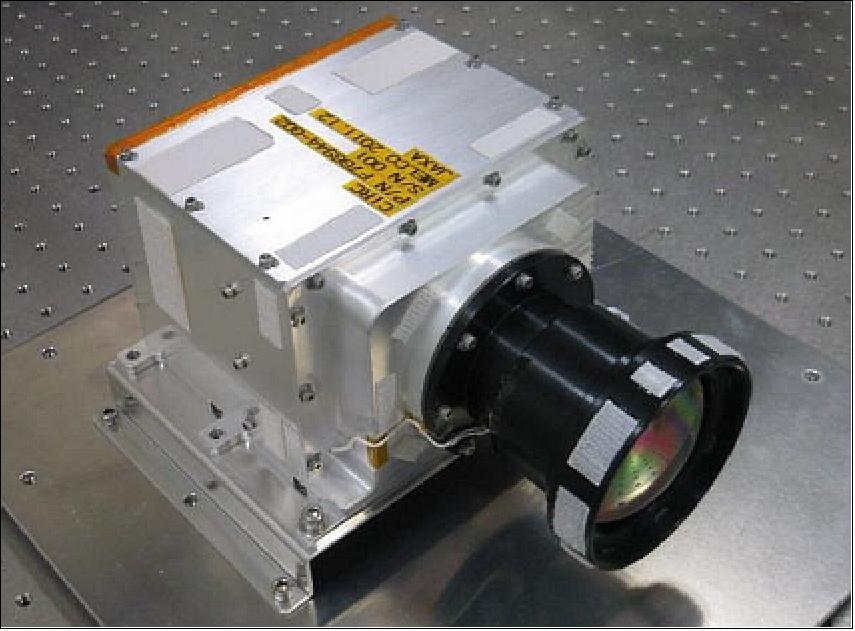
Airborne observations with the CIRC GTM (Ground Test Model): The project carried out airborne observations with the GTM) of CIRC. The model was constructed for establishing a way to perform ground calibration and carry out field observations before fabrication of the PFM.
Observational flight were carried out on March, 22 and 28, 2012. The aircraft was a “Cessna172 Sky hawk”. The observation area was Tsukuba City, Tsuchiura City in the south of Ibaraki Prefecture, and Narita City in Chiba Prefecture, all in Japan. The flight altitude ranged from 300 m to 750 m. The GSD (Ground Sample Distance) at these altitudes ranged from 10 cm to 25 cm. The flights confirmed that the performance of the CIRC is as expected and sufficient for launch on ALOS-2.
SPAISE2 (SPace based Automatic Identification System Experiment 2)
SPAISE2 is a second generation AIS instrument of JAXA featuring: 80)
• A 4 channel AIS signal reception capability (simultaneously 2 channels)
• Digital sampling and ground signal processing archtecture.
Main sensor | Cross dipole antenna |
Channel frequencies | AIS #1: 161.975 MHz, AIS #2: 162.025 MHz |
Minimum receiver sensitivity: | -112 dBm |
Sampling rate | 76.8 kHz |
Instrument mass, size | 7 kg x 2, 1050 mm x 800 mm x 800 mm |
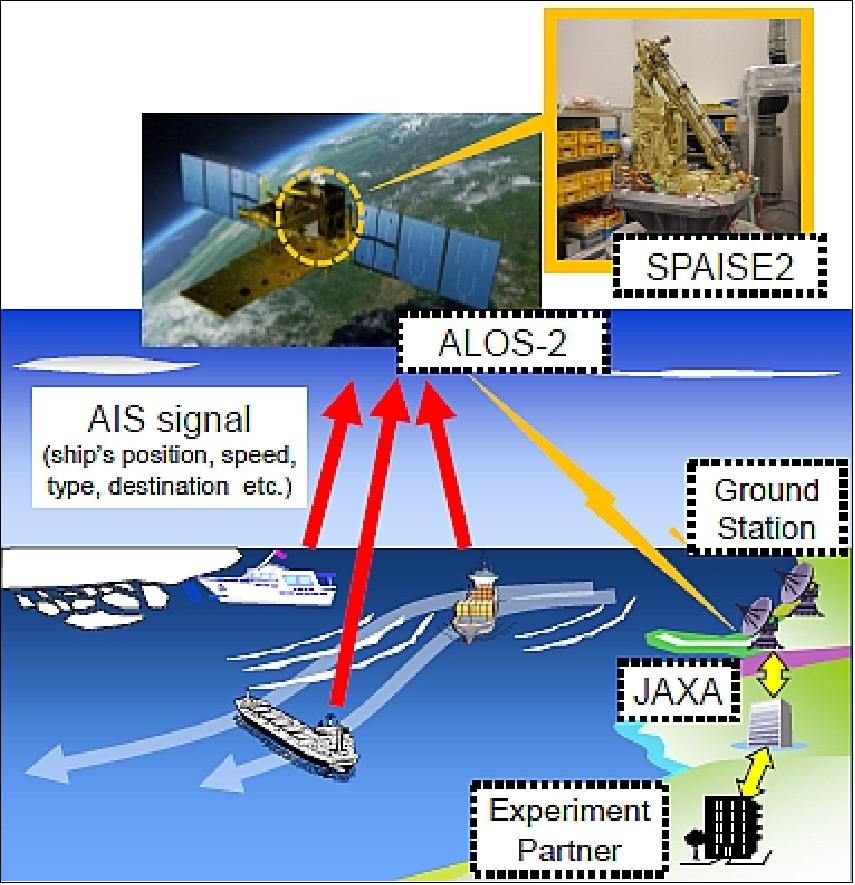
Ground System
An overview of the CIRC ground system is shown in Figure 70. The ACGS (ALOS-2/CIRC Ground System) consists of three components: a CIRC observation planning system, a data processing system, and a data archive system.

Generally, observation plans are constructed in response to requests from users by the CIRC observation planning system, utilising satellite operation information. After observation, the data processing system obtains Level-0 data from the ALOS-2 ground system and performs geometric and radiometric correction to produce Level-1 data. Then, the detection of wildfires, for example, is conducted to produce Level-2 data. Subsequently, the Level-1 and Level-2 data are released online through the data archive system, making them available to the users.
ALOS-2 ground system:
The ALOS-2 ground system is composed of the Satellite Control and Mission Operation System and the Information System, located at the JAXA Tsukuba Space Center. The Information System will have the functions of data processing, archiving, cataloging and user service functions for ALOS and ALOS-2.
For the global observation, the ALOS-2 ground system will utilise data relay communication and very fast X-band direct downlink (Figure 71). The observation data of PALSAR-2 will be once recorded on the solid state recorder onboard ALOS-2 and reproduced at 278 Mbit/s for Ka-band and at 800/400/200 Mbit/s via X-band.
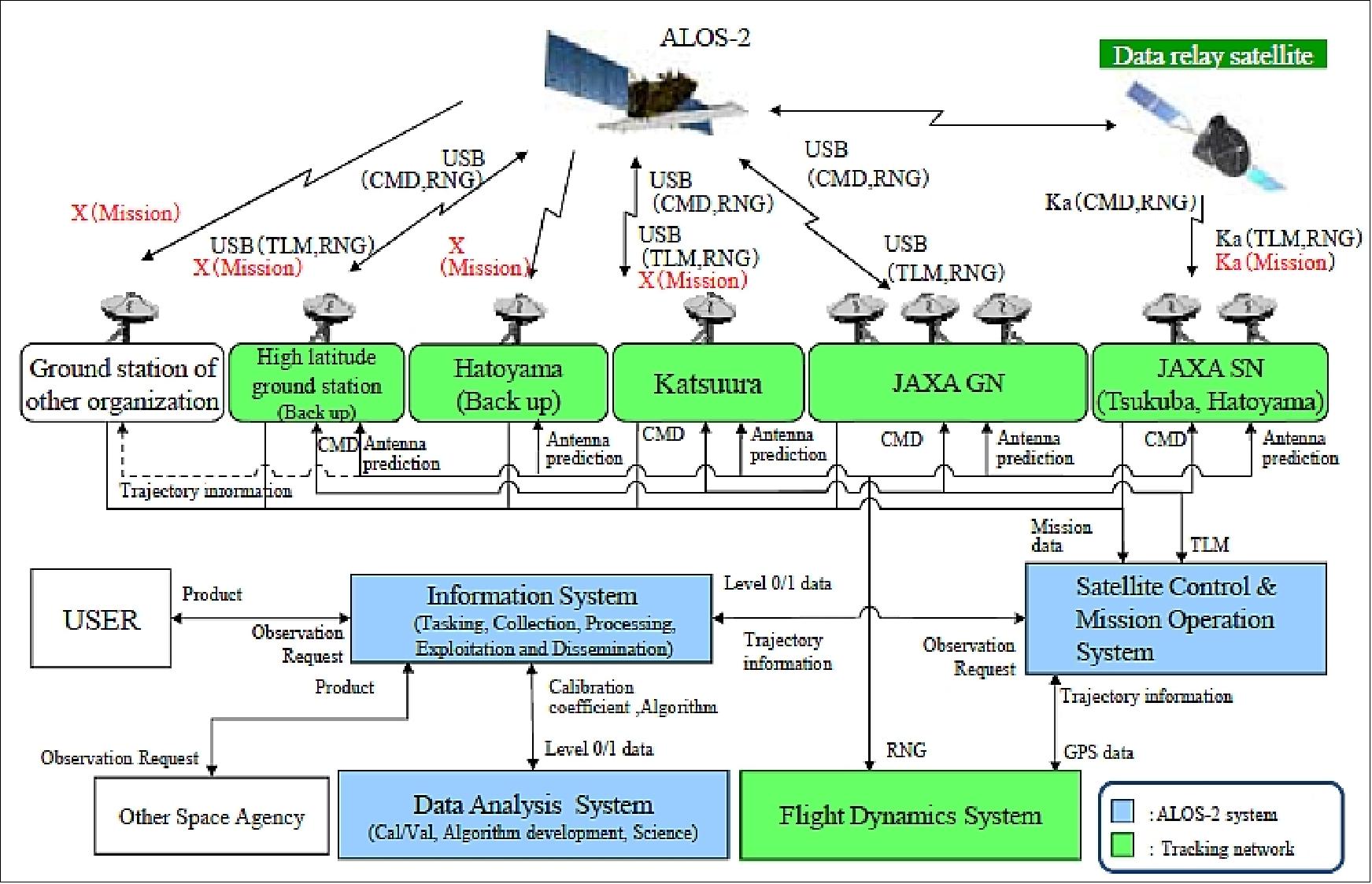
When a disaster occurs, command will be ready within 60 minutes for emergency observation. After the Ground station receives the observation data, the emergency product will be ready within 60 minutes. Figure 72 shows the example of quick tasking and processing in natural disaster occurrence.
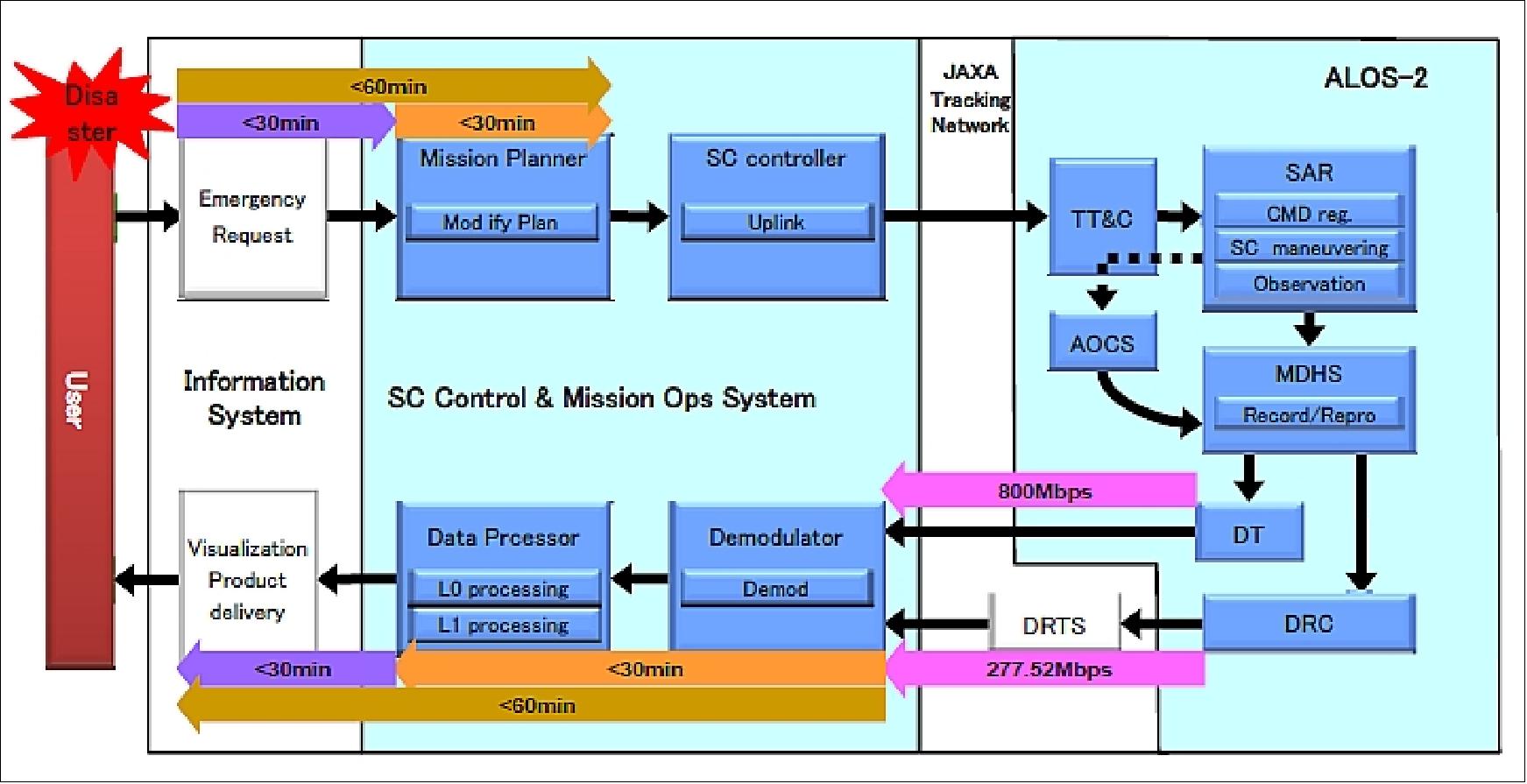
ALOS-2 science capabilities include global environmental monitoring using the time-series PALSAR-2. The research target also covers biospheric, cryospheric, and coastal ocean research as well as disaster mitigation. Table 15 summarises these research products. 81)
Category | Product | Contents |
Biosphere | 25-m spaced annual global mosaics (using orthorectified slope corrected SAR) | Produced using the DEM (DSM). Global browse, 500 m global browse mosaic, global 3 m resolution mosaic, and ScanSAR ortho-slope corrected path for quasi-deforestation monitoring of pantropical regions, i.e., Brazil, Indonesia, are also included. |
Forest and wetland monitoring | Generate global forest maps, i.e., forest/non-forest or forest maps with more classes and also wetland change maps. | |
Biomass estimation | Experimentally creates a biomass map using the gamma-naught-biomass, biomass-lidar, and biomass-classification methods | |
Land use classification | Creates the LULUCF map at several test sites | |
Agriculture | Crop monitoring using the SAR | |
Geosphere | Deformation | DinSAR and time-series analysis, surface deformations caused by earthquakes, volcanic activities, subsidence, and landslides, such as quick deformation patterns of earthquakes and annual monitoring of the Japan islands |
Soil moisture | Soil moisture will be generated from PolSAR data. | |
DEM (Digital Elevation Model) | To be generated by stacking, correction of topographic and ionospheric error is an issue | |
Cryosphere | Sea ice identification | Creates monthly ScanSAR mosaics for both polar regions and temporal changes for glacier movement. |
Marine | Wind speed distribution | LMOD (L-band modulation function) developed for PALSAR will be improved by using the dual-polarised PALSAR-2. |
Disaster | Sensitivity research for disasters | Time-series SAR data (amplitude), PolSAR and InSAR (coherence) will be combined to detect the best combination for each disaster. Flooding in urban areas is one target. |
Fire scar | Using time-differentiation of the slope-corrected HV, fire risk areas will be detected. |
References
1) Shinichi Suzuki, Yuji Osawa, Yasushi Hatooka, Tomohiro Watanabe, “The Post-ALOS program,” Proceedings of the 27th ISTS (International Symposium on Space Technology and Science) , Tsukuba, Japan, July 5-12, 2009, paper: 2009-n-02
2) Masanobu Shimada, “Advanced Land Observation Satellite (ALOS) and its follow-on satellite, ALOS-2,” Proceedings of the 4th International POLinSAR 2009 Workshop, Jan. 26-30, 2009, ESA/ESRIN, Frascati, Italy, URL: http://earth.esa.int/workshops/polinsar2009/participants/535/pres_8_Shimada_535.pdf
3) Yukihiro Kankaku, Yuji Osawa, Shinichi Suzuki, Tomohiro Watanabe, “The Overview of the L-band SAR Onboard ALOS-2,” Proceedings of PIERS (Progress In Electromagnetics Research Symposium), Moscow, Russia, August 18-21, 2009, URL: https://www.piers.org/pierspublications/PIERS2009MoscowProceedings02.pdf
4) Yoshihisa Arikawa, Yuji Osawa, Yasushi Hatooka, Shinichi Suzuki, Yukihiro Kankaku, “Development Status of Japanese Advanced Land Observing Satellite-2,” Proceedings of the SPIE Remote Sensing Conference, Toulouse, France, Vol. 7826, Sept. 20-23, 2010, 'Sensors, Systems, and Next-Generation Satellites XIV,' edited by Roland Meynart, Steven P. Neeck, Haruhisa Shimoda, doi: 10.1117/12.866675
5) http://www.jaxa.jp/projects/sat/alos2/index_e.html
6) ALOS-2:The Advanced Land Observing Satellite-2 "DAICHI-2", JAXA brochure, URL: http://global.jaxa.jp/activity/pr/brochure/files/sat29.pdf
7) Yukihiro Kankaku, Yuji. Osawa, Yasushi Hatooka, Shinichi Suzuki, “Overview of Advanced Land Observing Satellite-2 (ALOS-2)” Proceedings of ISPRS Technical Commission VIII Symposium, Aug. 9-12, 2010, Kyoto, Japan
8) Masanobu Shimada, “Advanced Land Observation satellite (ALOS) and ALOS-2,” Leiden, The Netherlands, May 17, 2011
9) “ALOS-2 Project,” JAXA/EORC, URL: http://www.eorc.jaxa.jp/ALOS/en/top/about_top.htm
10) Takao Akutsu, “JAXA’s Contributions to the Climate Change Monitoring,” June 7, 2011, URL: http://www.oosa.unvienna.org/pdf/pres/copuos2011/tech-20.pdf
11) Shinichi Suzuki, “Advanced Land Observing Satellite-2 "DAICHI-2" (ALOS-2) - Mission talk by team leaders,” JAXA, May 2014, URL: http://global.jaxa.jp/projects/sat/alos2/leaders.html
12) Yoshihisa Arikawa, Tomoya Niwa, Hideki Saruwatari, Yasushi Hatooka, Yuji Osawa, “ALOS-2 System Design and PFM Current Status,” Proceedings of the 29th ISTS (International Symposium on Space Technology and Science), Nagoya-Aichi, Japan, June 2-8, 2013, paper: 2013-n-41
13) Masanobu Shimada, Yukihiro Kankaku, Manabu Watanabe, and Takeshi Motooka, “Current Status of the ALOS-2 / PALSAR-2 and the CALVAL Program,” CEOS SAR CALVAL Workshop at ASF (Alaska Flight Facility), Fairbanks, AK, Nov. 7-9, 2011, URL: http://sarcv.ceos.org/site_media
/media/documents/Current_Status_of_ALOS-2_M.Shimada.pdf
14) Shinichi Suzuki, Yuji Osawa, Yasushi Hatooka, Yukihiro Kankaku, Tomohiro Watanabe, “Overview of Japan’s advanced land observing satellite-2 mission,” Proceedings of SPIE, 'Sensors, Systems, and Next-Generation Satellites XIII,' edited by Roland Meynart, Steven P. Neeck, Haruhisa Shimoda, SPIE Vol. 7474, 2009, 74740Q
15) Kazuya Inaoka, Masashi Shirakura Terumi Sunaga, Masaaki Shimada, Noboru Takata, “Development of an X-band Multi-mode High speed Modulator -Design and Development test Results of Engineering Model,” Proceedings of the 28th ISTS (International Symposium on Space Technology and Science), Okinawa, Japan, June 5-12, 2011, paper: 2011-j-10
16) Shinichi Suzuki , Yukihiro Kankaku,; Hiroko Imai, Yuji Osawa, “Overview of ALOS-2 and ALOS-3", Proceedings of SPIE,' Earth Observing Missions and Sensors: Development, Implementation, and Characterization II,' Vol. 8528, Kyoto, Japan, October 29, 2012, 852811 (November 9, 2012); doi:10.1117/12.979184
17) Awano Johta, Nakadai Mitsuhiro, Yajima Masanobu, “Study of TT&C Communication System for Next Generation JAXA Satellite,”Proceedings of TTC 2013, 6th International Workshop on Tracking Telemetry and Command Systems for Space Applications, Darmstadt, Germany, Sept. 10-13, 2013
18) Shinichi Suzuki, Yukihiro Kankaku, Yuji Osawa, “ALOS-2 development status and draft acquisition strategy,” Proceedings of SPIE Remote Sensing 2012, 'Sensors, Systems, and Next-Generation Satellites,' Edinburgh, Scotland, UK, Vols. 8531-8539, Sept. 24-27, 2012, paper: 8533-9
19) “DAICHI-2 (ALOS-2) Status and Orbit Calculation,” JAXA Press Release, May 24, 2014, URL: http://global.jaxa.jp/press/2014/05/20140524_daichi2.html
20) Patrick Blau, “Japan's H-IIA Rocket successfully Launches ALOS-2 Radar Satellite,” Spaceflight 101. May 24, 2014, URL: http://www.spaceflight101.com/h-iia-f24-launch-updates---alos-2.html
21) “Launch of H-IIA Launch Vehicle No. 24,” JAXA, MHI, March 14, 2014, URL: http://www.jaxa.jp/press/2014/03/20140314_h2af24_e.html
22) Naoki Okumura, “Launch Schedule in 2014 : ALOS-2,” JAXA, The 20th Session of the APRSAF (Asia-Pacific Regional Space Agency Forum), Hanoi, Vietnam, December 3-6, 2013, URL: http://www.aprsaf.org/annual_meetings/aprsaf20/pdf/program/day3/D3_1120_2_Japan.pdf
23) Toshinori Kuwahara, Kazaya Yoshida, Yuji Sakamoto, Yoshihiro Tomioka, Kazifumi Fukuda, Nobuo Sugimura, Junichi Kurihara, Yukihoro Takahashi, “Space Plug and Play Compatible Earth Observation Payload Instruments,” Proceedings of the 9th IAA Symposium on Small Satellites for Earth Observation, Berlin, Germany, April 8-12, 2013, Paper: IAA-B9-1502, URL: http://media.dlr.de:8080/erez4
/erez?cmd=get&src=os/IAA/archive9/Presentations/IAA-B9-1502.pdf
24) Toru Yamamoto, Isao Kawano, Takanori Iwata, Yoshihisa Arikawa, Hiroyuki Itoh, Masayuki Yamamoto, Ken Nakajima, “Autonomous Precision Orbit Control of ALOS-2 for Repeat-Pass SAR Interferometry,” Proceedings of IGARSS (IEEE International Geoscience and Remote Sensing Symposium), Melbourne, Australia, July 21-26, 2013
25) Yoshihisa Arikawa, Toru Yamamoto, Yoshinori Kondoh, Kyohei Akiyama, Hiroyuki Itoh, Shinichi Suzuki, “ALOS-2 orbit control and determination,” Proceedings of IGARSS (IEEE Geoscience and Remote Sensing Society) 2014, Québec, Canada, July 13-18, 2014
26) ”Satellites Size Up Bubbles of Methane in Lake Ice,” NASA Earth Observatory, Image of the Day for 14 July 2020, URL: https://earthobservatory.nasa.gov/images
/146940/satellites-size-up-bubbles-of-methane-in-lake-ice
27) ”Agreement on Data Utilization of Earth Observation Satellite with FAO,” JAXA Press Release, 23 January 2020, URL: https://global.jaxa.jp/press/2020/01/20200123-1_e.html
28) ”FAO teams up with the Japan Aerospace Exploration Agency,” FAO, 23 January 2020, URL: http://www.fao.org/news/story/en/item/1258016/icode/
29) ”Palu Landslides Linked to Rice Irrigation,” NASA Earth Observatory, Image of the Day for 4 November 2019, URL: https://earthobservatory.nasa.gov/images
/145796/palu-landslides-linked-to-rice-irrigation?src=eoa-iotd
30) ”Measuring Movement from the Ridgecrest Quake,” NASA Earth Observatory, Image of the Day for 25 July 2019, URL: https://earthobservatory.nasa.gov/images
/145318/measuring-movement-from-the-ridgecrest-quake
31) ”NASA Maps Surface Changes From California Quakes,” NASA, 9 July 2019, URL: https://www.nasa.gov/feature/jpl/nasa-maps-surface-changes-from-california-quakes
32) https://www.eorc.jaxa.jp/ALOS-2/en/img_up/dis_pal2_eruption_anak_krakatau_20181226.htm
33) Masato Ohki, Takeshi Motooka, Takahiro Abe, Hiroto Nagai, Takeo Tadono, Yukihiro Kankaku, Masanobu Shimada, ”ALOS-2 mission status and updates,” Proceedings of IGARSS (International Geoscience and Remote Sensing Symposium), Valencia, Spain, July 23-27, 2018
34) ”The Basic Agreement with FROM/FFPRI for Earth Observation Data Application on Forest Stewardship,” JAXA Press Release, 25 May 2018, URL: http://global.jaxa.jp/press/2018/05/20180525_ffpri.html
35) ”Release of JICA-JAXA Forest Early Warning System in the Tropics (JJ-FAST),” JAXA Press Release, 14 November 2016, URL: http://global.jaxa.jp/press/2016/11/20161114_jjfast.html
36) ”JICA-JAXA Forest Early Warning System in the Tropics,” EORC (Earth Observation Research Center), 2018, URL: http://www.eorc.jaxa.jp/jjfast/
37) Takeshi Motohka, Osamu Isoguchi, Masanori Sakashita, Masanobu Shimada, ”ALOS-2 PALSAR-2 Cal/Val Updates,” The Joint PI Meeting of Global Environment Observation Mission FY2017 (The 3rd ALOS-2 PI Workshop), Tokyo, Japan, Jan. 22-25, 2018, URL: http://www.eorc.jaxa.jp
/ALOS-2/en/calval/JAXA_PI_workshop_ALOS2CalVal_20180124.pdf
38) ”ALOS-2/PALSAR-2 Observation Result for Eruption of Mt. Agung in Indonesia,” JAXA/EORC, 6 Dec. 2017, URL: http://www.eorc.jaxa.jp/ALOS-2/en/img_up/dis_pal2_agung-eruption_20171205.htm
39) ”ALOS-2/PALSAR-2 Observation results on detachment of a large iceberg from Larsen-C Ice Shelf in Antarctic Peninsula,” JAXA July 25, 2017, URL: http://www.eorc.jaxa.jp
/ALOS-2/en/img_up/dis_pal2_ant-iceshelf_20170725.htm#20170809_add
40) ”Extent of Texas Flooding Shown in New NASA Map,” NASA/JPL, 30 Aug. 2017, URL: https://www.jpl.nasa.gov/spaceimages/details.php?id=PIA21928
41) ”NASA Working with Partners to Provide Harvey Response,” NASA/JPL, Aug. 30, 2017, URL: https://www.jpl.nasa.gov/news/news.php?feature=6938&utm_source=iContact&
utm_medium=email&utm_campaign=NASAJPL&utm_content=daily20170830-2
42) Alan Buis, Ian Hamling, ”Study of Complex 2016 Quake May Alter Hazard Models,” NASA/JPL, March 23, 2017, URL: https://www.jpl.nasa.gov/news/news.php?release=2017-084
43) ”Satellites shed new light on earthquakes,” ESA, March 24, 2017, URL: http://m.esa.int/Our_Activities/Observing_the_Earth/Copernicus
/Sentinel-1/Satellites_shed_new_light_on_earthquakes
44) Ian J. Hamling, Sigrun Hreinsdóttir, Kate Clark, John Elliott, Cunren Liang, Eric Fielding, Nicola Litchfield, Pilar Villamor, Laura Wallace, Tim J. Wright, Elisabetta D’Anastasio, Stephen Bannister, David Burbidge, Paul Denys, Paula Gentle, Jamie Howarth, Christof Mueller, Neville Palmer, Chris Pearson, William Power, Philip Barnes, David J. A. Barrell, Russ Van Dissen, Robert Langridge, Tim Little, Andrew Nicol, Jarg Pettinga, Julie Rowland, Mark Stirling, ”Complex multifault rupture during the 2016 Mw 7.8 Kaikōura earthquake, New Zealand,” Science 23 Mar 2017, eaam7194, DOI: 10.1126/science.aam7194, URL of abstract: http://science.sciencemag.org/content/early/2017/03/22/science.aam7194
45) ”Global Digital Surface Model "ALOS World 3D - 30m" (AW3D30) has been updated with void-filled DSM within 60 deg. of N/S latitudes as Version 1.1.,” JAXA/EORC, March 6, 2017, URL: http://www.eorc.jaxa.jp/ALOS/en/aw3d30/index.htm
46) ”ALOS-2 PALSAR-2 Observation Results on New Zealand,” JAXA/EORC, Nov. 16, 2016, URL: http://www.eorc.jaxa.jp/ALOS-2/en/img_up/dis_pal2_nzl-eq_20161115.htm
47) ”Release of JICA-JAXA Forest Early Warning System in the Tropics (JJ-FAST),” Nov. 14, 2016, URL: http://global.jaxa.jp/press/2016/11/20161114_jjfast.html
48) ”Data Release of Global Forest/Non-forest Map by DAICHI-2 - Contributing to measures to tackle global warming by understanding forest areas,” JAXA Press Release, Jan. 28, 2016, URL: http://global.jaxa.jp/press/2016/01/20160128_daichi2.html
49) ”JICA and JAXA Announce Forest Monitoring System Using ALOS-2 Satellite: Constant monitoring of deforestation throughout the tropics and open data access on the Internet,” JICA Press Release, December 15, 2015, URL: http://www.jica.go.jp/english/news/press/2015/151215_01.html
50) ”ALOS-2/PALSAR-2 Observation Results of Flooding on the Mississippi River,” JAXA/EORC, Jan. 21, 2016, URL: http://www.eorc.jaxa.jp/ALOS-2/en
/img_up/dis_pal2_mississippi-flood_20160106.htm#add2
51) “DAICHI-2 Emergency Observations of Sakurajima Volcano,” JAXA Press Release, Aug. 19, 2015, URL: http://global.jaxa.jp/press/2015/08/20150819_daichi2.html#pict
52) Masanobu Shimada, Manabu Watanabe, Takeshi Motooka, Yukihiro Kankaku, Shinichi Suzuki, “Calibration and validation of the PALSAR-2),” Proceedings of the IGARSS (International Geoscience and Remote Sensing Symposium) 2015, Milan, Italy, July 26-31, 2015
53) “Emergency observation and initial GLOF assessment of glacial lakes in western Bhutan by ALOS-2,” JAXA/EORC, July 2015, URL: http://www.eorc.jaxa.jp/ALOS-2/en/img_up/dis_pal2_btn-glof_20150702.htm
54) “Agreement concluded with MLIT on DAICHI-2 observation data,” JAXA, May 14, 2015, URL: http://global.jaxa.jp/projects/sat/alos2/topics.html#topics4652
55) “ALOS-2/PALSAR-2 Observation Results of the 2015 Nepal Earthquake (4),” JAXA, URL: http://www.eorc.jaxa.jp/ALOS-2/en/img_up/dis_pal2_npl-eq_20150502.htm
56) “ALOS-2/PALSAR-2 Observation Results of the 2015 Nepal Earthquake (1),” JAXA, May 5, 2015, URL: http://www.eorc.jaxa.jp/ALOS-2/en/img_up/dis_pal2_npl-eq_20150426.htm
57) “ALOS-2/CIRC data is open to public!,” JAXA, Jan. 23, 2015, URL: http://global.jaxa.jp/projects/sat/alos2/topics.html#topics3753
58) Masanobu Shimada, “ALOS-2 PALSAR-2 Mission Status,” POLinSAR 2015, ESA/ESRIN, Frascati, Italy, Jan. 26-30, 2015, URL: http://seom.esa.int/polinsar-biomass2015/files/D1S2_Missions_2.pdf
59) “Advanced Land Observing Satellite-2 "DAICHI-2" (ALOS-2) Regular Provision of Observation Data,” JAXA Press Release, Nov. 25, 2014, URL: http://global.jaxa.jp/press/2014/11/20141125_daichi2.html
60) “Provision of Emergency Data on Mt. Ontake Observed by Daichi-2,” JAXA Press Release, Sept. 30, 2014, URL: http://global.jaxa.jp/press/2014/09/20140930_daichi2.html#at
61) “First Image Data Acquisition by Compact Infrared Camera (CIRC) onboard DAICHI-2,” JAXA, Aug. 11, 2014, URL: http://circgs.tksc.jaxa.jp/news/first_light/index_e.html
62) “First Image Data Acquisition by DAICHI-2 (ALOS-2),” JAXA Press Release, June 27, 2014, URL: http://global.jaxa.jp/press/2014/06/20140627_daichi2.html#at
63) “DAICHI-2 (ALOS-2) Completion of Critical Operation Phase,” JAXA, May 27, 2014, URL: http://global.jaxa.jp/press/2014/05/20140527_daichi2.html
64) “DAICHI-2 (ALOS-2) L-band Synthetic Aperture Rader (PALSAR-2) Antenna Deployment,” JAXA Press Release, May 26, 2014, URL: http://global.jaxa.jp/press/2014/05/20140526_daichi2.html#at1
65) Yoshihisa Arikawa, Hideki Saruwatari,Yasushi Hatooka, Shinichi Suzuki, “ALOS-2 launch and early orbit operation result,” Proceedings of IGARSS (IEEE Geoscience and Remote Sensing Society) 2014, Québec, Canada, July 13-18, 2014
66) Yukihiro Kankaku, Masakazu Sagisaka, Shinichi Suzuki, “PALSAR-2 launch and early orbit status,” Proceedings of IGARSS (IEEE Geoscience and Remote Sensing Society) 2014, Québec, Canada, July 13-18, 2014
67) Yukihiro Kankaku, Yuji Osawa, Shinichi Suzuki, “The current status and brief results of Engineering Model for PALSAR-2 onboard ALOS-2,” Proceedings of the 28th ISTS (International Symposium on Space Technology and Science), Okinawa, Japan, June 5-12, 2011, paper: 2011-n-18
68) Yukihiro Kankaku, Yuji Osawa, Yasushi Hatooka, Shinichi Suzuki, “The overview of the L-band SAR onboard ALOS-2,” ISPRS Technical Commission VIII Symposium in Kyoto, Japan, August 10, 2010
69) Y. Okada, T. Hamasaki , M. Tsuji, M. Iwamoto, K. Hariu, Y. Kankaku, S. Suzuki, Y. Osawa, “Hardware Performance of L-band SAR System Onboard ALOS-2,” Proceedings of IGARSS (International Geoscience and Remote Sensing Symposium), Vancouver, Canada, July 24-29, 2011
70) Hiroyuki Inahata, Hiroshi Koyama, “Evolution of SAR Satellite for Agriculture Applications,” Proceedings of APRSAF-18 (18th Session of the Asia-Pacific Regional Space Agency Forum), Singapore, Dec. 6-9, 2011
71) Osamu Ochiai, Masanobu Shimada, and the JAXA BOS-2 group, “ALOS-2 status and Acquisition Strategy Update,” CEOS SDCG 2, USGS HQ, VA, USA, Sept 13-14, 2012
72) Yukihiro Kankaku, Yuji Osawa, Shinichi Suzuki, “The Developmental Status of PALSAR-2 onboard ALOS-2,” Proceedings of the 29th ISTS (International Symposium on Space Technology and Science), Nagoya-Aichi, Japan, June 2-8, 2013, paper: 2013-n-42
73) Yukihiro Kankaku, Shinichi Suzuki, Yuji Osawa, “ALOS-2 Mission and Development Status,” Proceedings of IGARSS (IEEE International Geoscience and Remote Sensing Symposium), Melbourne, Australia, July 21-26, 2013
74) Shinichi Suzuki, Yukihiro Kankaku, Masanobu Shimada, “ALOS-2 Acquisition Strategy,” Proceedings of IGARSS (IEEE International Geoscience and Remote Sensing Symposium), Melbourne, Australia, July 21-26, 2013
75) Y.Okada, S. Nakamura, K. Iribe, Y. Yokota, M. Tsuji, M.Tsuchida, K.Hariu, Y.Kankaku, S.Suzuki, Y.Osawa, M.Shimada, “System design of wide swath, high resolution, full polarimetric L-band SAR onboard ALOS-2,” Proceedings of IGARSS (IEEE International Geoscience and Remote Sensing Symposium), Melbourne, Australia, July 21-26, 2013
76) Masataka Naitoh, Haruyoshi Katayama, Masatomo Harada, Ryoko Nakamura, Eri Kato, Yoshio Tange, Ryota Sato , Koji Nakau, “Development of the Compact Infrared Camera (CIRC) for Earth Observation,” Proceedings of the ICSO (International Conference on Space Optics), Ajaccio, Corse, France, Oct. 9-12, 2012, paper, ICSO-066, URL: http://circgs.tksc.jaxa.jp/documents/2012/2012_ICSO_b.pdf
77) Masatomo Harada, Haruyoshi Katayama, Masataka Naitoh, Masahiro Suganuma, Ryoko Nakamura, Yoshio Tange, Takao Sato, “Development of the Compact Infrared Camera (CIRC) for Earth Observation,” ICSO 2010 (International Conference on Space Optics), Rhodes Island, Greece, Oct. 4-8, 2010, URL: http://www.congrexprojects.com/custom/icso/Papers/TPosters/10_Harada.pdf
78) Masataka Naitoh, Haruyoshi Katayama, Masatomo Harada, Ryoko Nakamura, Eri Kato, Yoshio Tange, Ryota Sato, Koji Nakau, “Compact Infrared Camera (CIRC) for Earth Observation,” Proceedings of the 29th ISTS (International Symposium on Space Technology and Science), Nagoya-Aichi, Japan, June 2-8, 2013, paper: 2013-n-29
79) Yusuke Murakia, Koji Nakau, Yohei Sugimoto, ”New Concept of International Satellite Constallation of Compact Thermal Infrared Camera,” Proceedings of the 67th IAC (International Astronautical Congress), Guadalajara, Mexico, Sept. 26-30, 2016, paper: AC-16-B1.1.10
80) Keizo Nakagawa, “R&D of JAXA Satellite Application Mission,” MEWS26 (26th Microelectronics Workshop), Tsukuba, Japan, Oct. 24-25, 2013, URL: https://eeepitnl.tksc.jaxa.jp/mews/jp/26th/data/1_1.pdf
81) Masanobu Shimada, “ALOS-2 Science Program,” Proceedings of IGARSS (IEEE International Geoscience and Remote Sensing Symposium), Melbourne, Australia, July 21-26, 2013